Comstock-Gág Read Aloud Book All Award Winners & Honor Books
2005 - Present
The first annual Comstock-Gág Read Aloud Book Awards program was given in 2005.
Award Winners
Growing Up Under a Red Flag: A Memoir of Surviving the Chinese Cultural Revolution written by Ying Chang Compestine and illustrated by Xinmei Liu (Rocky Pond Books). 2024

Ying Chang Compestine was a young girl in 1966 when Mao ZeDong launched the cultural revolution to regain his power in the Chinese government. Mao banned foreign items, required children to dress in uniform, and unleashed the Red Guard to terrorize and imprison people who disagreed with him. It was a time of chaos, fear, and scarcity that lasted until his death ten years later when Ying was thirteen. Yet through those harrowing years, Ying’s father, a surgeon trained by American missionaries, continued to educate her in secret and fuel her dreams of going to America to find freedom. Now she brings her childhood story from that dark chapter of Chinese history to life in this stirring and eye-popping memoir, magnificently illustrated by debut artist Xinmei Liu. This book was read multiple times to students in grades 4-6, and both the students and the readers rated it quite highly. After listening to the book, young readers expressed that they enjoyed learning about a different country and appreciated that the story was about the author and her early life. Many students made positive comments about the vibrant illustrations and how they helped to tell the story. One reader stated that the story brought her to tears, and that the story brought about a lot of great discussion among the students. Ying Chang Compestine grew up in Wuhan, China, during the Chinese Cultural Revolution, which she had previously written about in her acclaimed novel Revolution Is Not a Dinner Party. She is an award-winning author of more than twenty-five books and a former food editor for Martha Stewart’s Whole Living magazine. She lives in San Francisco with her husband and son. Xinmei Liu grew up in Shanghai, China and currently resides in Indiana. She is a freelance illustrator whose work has appeared in the New York Times, The New Yorker and NBC News. Growing Up Under a Red Flag is her first book published in the United States.
That Flag written by Tameka Fryer Brown, illustrated by Nikkolas Smith (Harper, an imprint of HarperCollins Publishers). 2023.
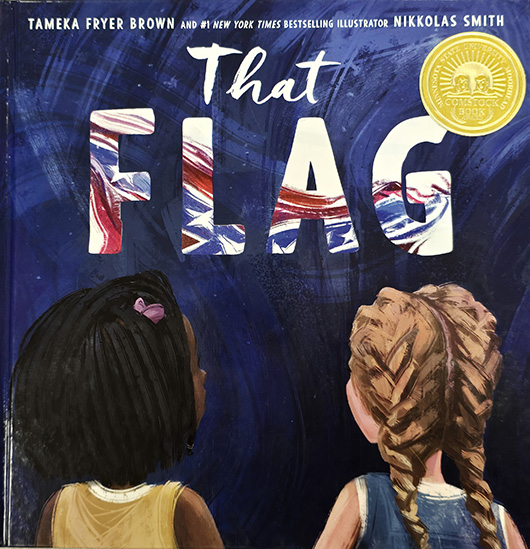
Bianca is Keira’s best friend at school and they are inseparable. But when they are at home it’s different story. While Bianca’s family proudly flies a Confederate flag, Keira is not allowed to visit Bianca’s house as her family says “that flag” represents hate. As Kiera learns more about the flag and its history from a class trip to the Southern Legacy Museum, she begins to question her friendship with Bianca. When the flag and its violence strike close to home, will the two friends overlook their different perspectives of the flag? Or will they come to terms with the flag’s effect on the past and present? This powerful story with its bold and expressive illustrations will have readers reflecting on topics of friendship, justice, growth, and facing the truth of our country’s history.
Readers between the ages of 9-12 showed considerable attention when listening to That Flag. Teachers noted positive comments from students such as how they learned a lot from the book as they were not aware of the Confederate flag and the history behind it. One teacher commented that their students of color really appreciated the book. All teachers mentioned the great discussions their classrooms had about the images in the museum, the right thing to do when something offends another person and asking for forgiveness. Lastly, teachers said That Flag could be incorporated into correlating curriculum.
Tameka Fryer Brown is an award-winning picture book author of Not Done Yet: Shirley Chisholm’s Fight For Change, Brown Baby Lullaby, and My Cold Plum Lemon Pie Bluesy Mood Tameka is also an active member of The Brown Bookshelf, Black Creators HQ, and KidLit in Color. Nikkolas Smith is picture book author/illustrator, artist, Hollywood film illustrator and activist. His books include The Artivist, The 1619 Project: Born on the Water, and I am Ruby Bridges.
Listen: How Evelyn Glennie, a Deaf Girl, Changed Percussion written by Shannon Stocker and illustrated by Devon Holzwarth (Dial Books for Young Readers). 2022
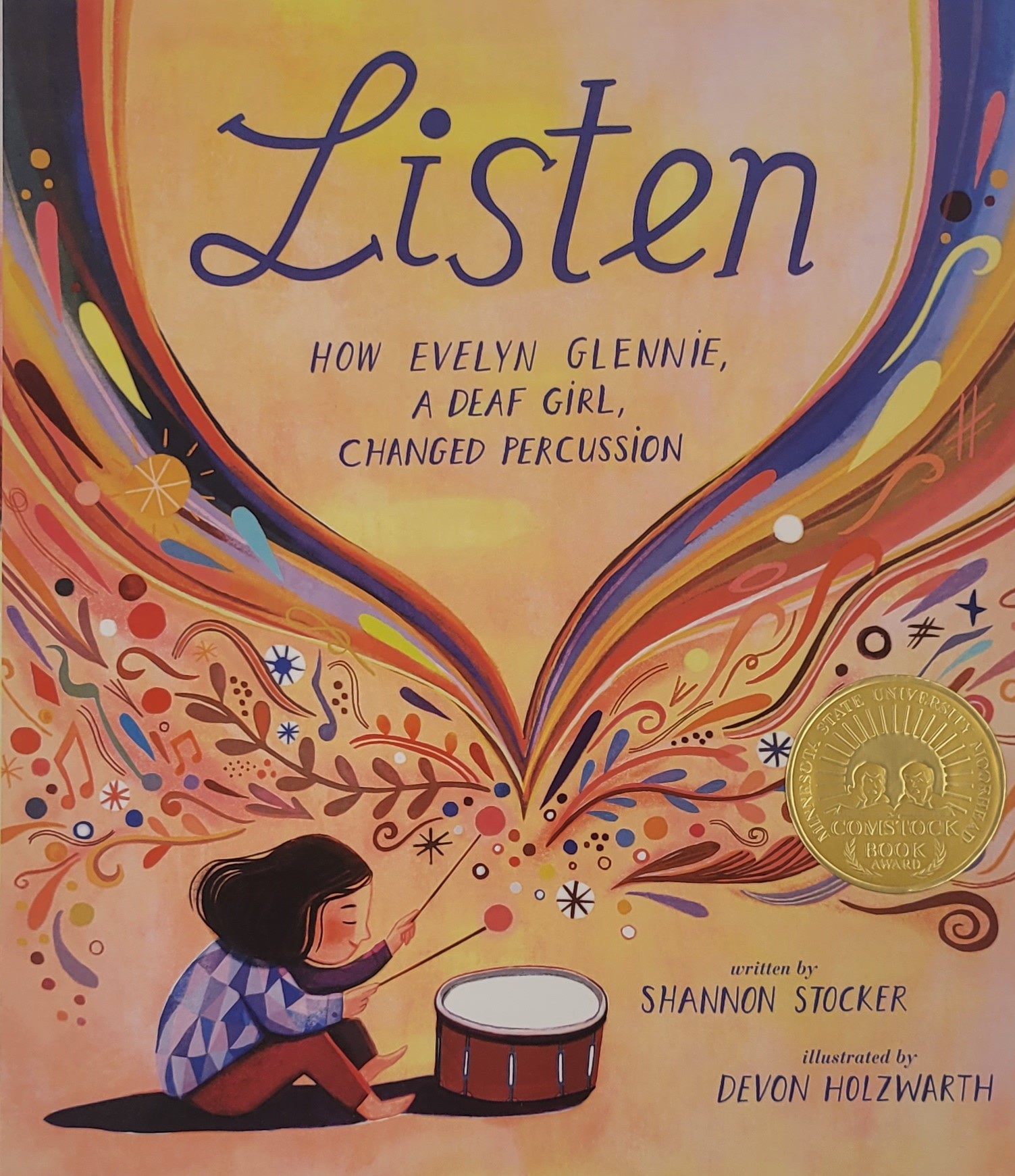
A percussionist renowned the world over, Evelyn Glennie has performed in over 40 countries, with over 200 ensembles, playing music that more often than not, has been written for her. She has done all this, achieving the highest honors in her field, all while being deaf. After learning, at the age of eight, that she would never be able to hear without hearing aids and that playing music would not be an option for her, Evelyn found percussion. Even though a listening test threatened to block her path to lessons, Evelyn found a teacher that was willing to take a chance on her. It was through this teacher, Mr. Forbes, that Evelyn discovered how to “listen” through feeling the vibrations of the instrument and a whole new world of sound opened up to her. Through determination, practice and refinement of this new found skill, Evelyn’s talent led her eventually to the Royal Academy of Music and the distinction of being the first performer to make a career of being a solo percussionist. Through ribbons of vibrant and flowing colors, as well as poetic and sometimes percussive language, Listen invites each reader to step into Evelyn’s remarkable story as they consider their own unique gifts.
Students ages nine to twelve were quickly captivated with this inspiring story of perseverance and overcoming obstacles. One reader noted that the child she was reading to “started more relaxed in her chair, but by the end she was sitting straight up”. Another reader commented that students were “captivated right away, and truly felt the sadness of the girl losing her hearing.” Readers also mentioned how the illustrations impacted the reading experience. In general, readers felt that the illustrations really made the story come alive through use of color and movement and that they supported the text well. Most notably, however, was the impact of the book’s theme. All readers found that the message of perseverance and problem solving was inspirational and well-received by their students.
Shannon Stocker is an award-winning author from Louisville, KY and has written for both the Together We Can series and Chicken Soup for the Soul. Devon Holzwarth is a picture book illustrator, author, painter currently living in Germany. Her most notable picture books include Tia Fortuna’s New Home, a 2203 Sydney Taylor Picture Book Notable winner. Shannon and Devon won the 2023 Schneider Family Book Award for Listen: How Evelyn Glennie, a Deaf Girl, Changed Percussion. [LOUIE LAUER]
The Elephants Come Home: A True Story of Seven Elephants, Two People, and One Extraordinary Friendship, written by Kim Tomsic, illustrated by Hadley Hooper (Chronicle Books). 2021.
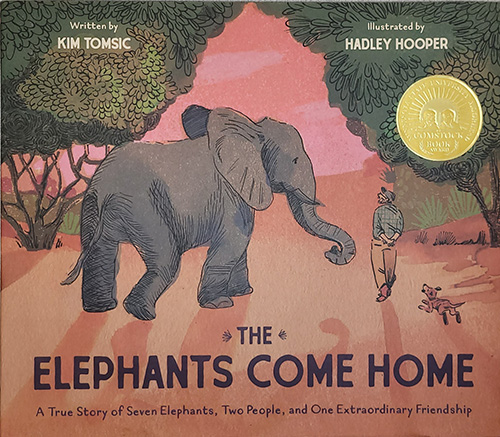
The Elephants Come Home is based on the true story of Lawrence Anthony and Francoise Malby-Anthony and their wildlife sanctuary, Thula Thula, in South Africa. Lawrence agrees to take a group of seven angry, destructive “problem” elephants from another game reserve who have been traumatized and hunted. Lawrence decides to try a new approach with this group of elephants and lives near them in the bush, talking and singing to them constantly. He slowly gains their trust with many hours of patience, kindness and understanding. His close bond with the herd is demonstrated when they welcome him home after any absence from the sanctuary. Lawrence and Francoise continued to live in Thula Thula working to preserve the wildlife of South Africa for many years. However, on a sunny day many years later, Lawrence dies. Though deep in the bush, the elephants sense his passing and come to the house to pay tribute to the man who loved them and created a home for them.
Evocative watercolor illustrations help to convey the emotional angst the elephants exhibit when they first arrive at Thula Thula. As the elephants begin to settle in and adjust to their surroundings, the colors match the tranquility and peace they feel in their new, safe home.
Students were actively engaged in the story and liked that it was based upon real-life events. One child commented, “Endings like that only happen in movies! No way the elephants knew he died and came back to the house!” Children had many questions about the book, asked for it to be read again, and shared the story with family members and friends. After story time, one child immediately ran upstairs to tell her parents about the book. The death of Lawrence evoked strong emotions in children, and many had tears in their eyes at the end of the book.
The Elephants Come Home is author Kim Tomsic’s second picture book. Tomsic was born in Italy into an American military family and has lived in various locations in the U.S. She is active in the Society of Children’s Book Writers and Illustrators (SCBWI) and in her father’s charity called the Friends of Haiti. She divides her time between Boulder, Colorado, and Scottsdale, Arizona, with her husband and two children. Illustrator Hadley Hooper has illustrated numerous picture books and currently lives in Denver, Colorado. [PAM WERRE]
The Oldest Student: How Mary Walker Learned to Read written by Rita Lorraine Hubbard, illustrated by Oge Mora, and published by Schwartz & Wade, 2020.
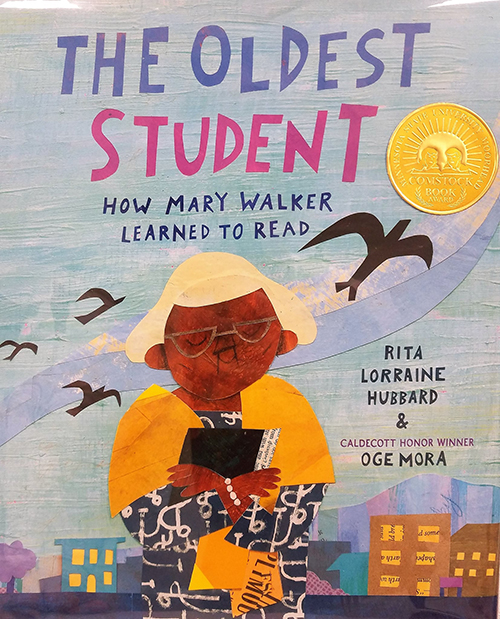
In 1964, at age 116, Mary Walker finally accomplished her dream of learning to read. This picture book biography follows her life story from slavery to Emancipation to sharecropping and finally to supporting herself by cooking, cleaning, and babysitting. Mary had to work hard to support her family which left no time for reaching her life goal of learning to read her treasured Bible. At age 114, Mary had outlived her entire family. Still determined to read, she joined a literacy class in her retirement home. At the age of 116, she realized her goal. Those squiggles she saw everywhere finally turned into words. A representative from the U.S. Department of Education certified that Mary was the nation’s oldest student.
After listening to the book, children realized how lucky they were to be able to read and were inspired to read more. The book is not only outstanding for its story but also for its illustrations and book design. Oge Mora’s artwork rendered in acrylic paint, china marker, colored pencil, patterned paper, and book clippings fascinated the 4-6th graders. They could not stop talking about the illustrations, especially noting how the squiggles turned into words. One reader commented: “Photos on the endpapers brought students face-to-face with a real person and made the story more personal.”
Author Rita Lorraine Hubbard was a special educator for over twenty years and currently is a full-time children’s book author. She lives in Chattanooga, Tennessee, where you can visit a historical marker at 3031 Wilcox Boulevard which commemorates Mary Walker’s amazing life story. Illustrator Oge Mora grew up in Columbus, Ohio and now lives in Providence, Rhode Island. She has received critical acclaim for many of her picture books, including a Caldecott Honor for Thank You, Omu! She is known for her colorful, patterned, collaged illustrations. [CAROL HANSON SIBLEY]
Sulwe written by Lupita Nyong’o, illustrated by Vashti Harrison (Simon and Schuster Books for Young Readers). 2019

In a recent interview, author Lupita Nyong’o described how as a child she was surrounded by people who looked like her, but she did not see herself in the books she read. Based on Nyong’o’s personal experiences, Sulwe is the story of a young girl who is uncomfortable with the darkness of her skin. Trying to look more like her family and the people around her, Sulwe tries different remedies to change her appearance. Neither a change in diet, the use of makeup, nor an attempt to erase her darkness changes her skin color or her feeling of self-worth. It is not until a journey through an ancient story of magical sisters that Sulwe recognizes true beauty comes in all shades and colors. Through a blend of realism and mythology, Sulwe’s story delicately addresses the issue of colorism and how people may be discriminated against based on the shade of their skin. Sulwe is an empowering story that reminds readers that beauty is based on a person’s nature and character and not on their appearance.
Readers between the ages of eight and eleven showed rapt attention when listening to Sulwe. Teachers noted positive comments from students; students stretching towards or pointing at the book, and in one case, spontaneous clapping. Aside from attention, teachers commented on the power of the message and how easy it was for students to understand. One teacher mentioned that it connected well with their school’s theme of “We are all different and that’s beautiful”. Another teacher commented that she felt the message was easily understood and that students could relate it to themselves.
Lupita Nyong’o is an Academy Award winning actress. Sulwe, her debut picture book, is a New York Times bestseller and won the NAACP Image Award for Outstanding Literary Work for Children. Illustrator Vashti Harrison, is the author/illustrator of the New York Times bestselling book, Little Leaders: Bold Women in Black History. She is also the recipient of the Coretta Scott King Illustrator Honor award for Sulwe. (LOUIE LAUER)
The Survivor Tree written by Gaye Sanders, illustrated by Pamela Behrend (The RoadRunner Press). 2017

A large American elm is planted by a loving family on the Oklahoma prairie. The prairie gradually evolves into Oklahoma City and the tree enjoys all that makes for a growing city – paved streets, skyscrapers, and more and more people. As the tree narrates the story we learn about all it loves: the construction workers who seek shade underneath it as they eat lunch, the children who play in and around it, and the view it enjoys overlooking the Alfred P. Murrah Federal Building. The tree doesn’t notice the yellow moving van that parks next to the building on April 19, 1995, but watches the chaos that ensues as a bomb from the truck explodes and people run toward the building to help. In the aftermath of the bombing, the future of the tree is uncertain, especially as it is charred and devoid of any greenery. What will happen to the tree? And to the people of Oklahoma City?
Third, fourth and fifth-grade students listening to the book enjoyed it, sitting with rapt attention and even moving closer to be able to see the color illustrations. They felt that hearing the story from the perspective of the tree was unique, and commented, “I liked how the story was like a lifespan of the tree.” Each of the classes discussed the message that love is stronger than hate. They also thought it was “really cool” that a seedling from the survivor tree grows in every state in the U.S. and that one was planted at the 9/11 Memorial Site.
Author Gaye Sanders is a fourth-grade teacher in the Mustang Public Schools in Oklahoma and this is her first book. Pamela Behrend is an artist, musician and former public school teacher who lives and keeps her art studio in Pennsylvania. [MARCI GLESSNER]
Follow the Moon Home: A Tale of One Idea, Twenty Kids, and a Hundred Sea Turtles written by Philippe Cousteau and Deborah Hopkinson and illustrated by Meilo So (Chronicle Books). 2016

Children ages eight to twelve especially enjoyed this nonfiction book about loggerhead turtles. Vivienne, who has just moved to a South Carolina barrier island, takes up the challenge of her summer school teacher to solve a community problem. She and her classmates entitle their project “Lights Out for Loggerheads,” as they inspire their whole town to shut off the lights along the beach so that hatching baby turtles head for the sea lit by the moon and the white caps of the waves, and not towards the man-made lights on shore.
This story inspired young listeners. They showed intent attention, asked questions and made comments, shared the book with friends and family members, checked out the websites mentioned in the back matter, and watched YouTube videos to learn more about how the turtles hatched and found their way to the sea. Teachers noted that the book could inspire children to pursue a passion by volunteering in other environmental endeavors. Children also appreciated how the beautiful illustrations in watercolor, colored ink, and colored pencils supported the text and helped them to understand the subject matter.
Author Philippe Cousteau is a leader in the environmental movement to educate the public about nature and conservation. His family’s non-profit organization, EarthEcho International, has the goal of inspiring young people to change the world. Philippe Cousteau is the grandson of the famous explorer Jacques Cousteau, who taught him “to be curious, to ask questions, and to dream.” Cousteau and his wife live in Los Angeles, California.
Co-author Deborah Hopkinson is well known for her many children’s books about historical and scientific topics. In 2009, her book Abe Lincoln Crosses a Creek also won the Comstock Read Aloud Book Award. Ms. Hopkinson lives with her family near Portland, Oregon.
Illustrator Meilo So has created the artwork for many children’s books about nature and animals. Originally from Hong Kong, she now lives with her family in the village of Cullivoe on the island of Yell, one of the Scottish Shetland Islands. Her studio called “Paradise” is a beautiful red shed in her garden where she is surrounded by nature and views of the sea. (CAROL HANSON SIBLEY)
Finding Winnie: The True Story of the World's Most Famous Bear written by Lindsay Mattick, illustrated by Sophie Blackall (Little, Brown and Company). 2015

Lindsay Mattick tells the true story of her great grandfather, Harry Colebourn, a veterinarian whose simple, kind gesture had an amazing ripple effect. Harry adopted a motherless bear cub and named her Winnipeg, shortened to Winnie. When Harry and his infantry brigade were shipped off to Britain during World War I, Winnie went along as the company mascot. When the men were called to fight in France, Harry reluctantly left Winnie behind at the London Zoo. It was here that Winnie met Christopher Milne. Christopher named his stuffed bear after the real Winnie and a legend was born. Christopher’s father was the well-known children’s author, A.A. Milne, who later wrote many stories about Christopher and Winnie’s adventures.
Illustrator Sophie Blackall brings this very personal story to life through her Chinese ink and watercolor illustrations. She tells the story through detailed double-page spreads, wordless panels, small vignettes, and photos.
Children, ages eight to twelve, and their readers truly appreciated this book. They were surprised to learn that Winnie-the-Pooh, a story they loved as young children, was based on a real bear. They enjoyed the story-within-a-story structure and the details in both the text and illustrations. The children especially explored the peritextual elements of the book. For example, they noticed the connections between the front and the back of the book jacket, the silhouettes of the soldiers and bear on the cover, and how the story actually begins on the front endpaper and title page. Teachers liked the focus on generations of a family and the themes of following your heart and the impact of a simple act of kindness. One fifth grade teacher perfectly captured the joy of this book, “Wow! Just a really great book.”
This is author Lindsay Mattick’s first children’s book. She lives with her family in Toronto, Canada. Her son, Cole, is named after his great-great grandfather, Harry Colebourn. Illustrator, Sophie Blackall, grew up in Australia and now lives in Brooklyn. She has illustrated over thirty children’s books. In 2016, Blackall received the Randolph Caldecott Medal for her illustrations in Finding Winnie. (CAROL SIBLEY)
What to Do When You're Sent to Your Room written by Ann Stott and illustrated by Stephen Gilpin (Candlewick Press). 2014

Ben has had lots of experience on how to keep busy when you get sent to your room. When he is sent to his room (again) for feeding his dinner to the dog (again), he is well prepared. Ben shares many ideas with the reader for ways to keep yourself entertained while doing time for your crime. His ideas range from writing notes of apology to his parents, preparing his birthday list, “redecorating” his room, and perfecting his sling shot skills. Ben is always ready for an early release because he shares a room with his older brother, and his mom never allows them to stay in the same room at the same time. After reading this story, you will understand why.
Gilpin’s detailed illustrations are humorous and draw the reader into the story. The illustrations range from double page spreads showing Ben busy in his room, to vignettes showing him doing chores and improving his special-ops skills. The large illustrations make this book perfect as a read aloud. The facial expressions of Ben and his pets are very humorous and enhance the reading experience.
Children, ages five to eleven, loved this book. They were enthusiastic about reading the book and found the characters to be engaging and entertaining. The plot is true to life and easy to relate to for many children. The fantastic illustrations and humorous antics of the main character captivated students. Readers highly recommended this book and children begged for it to be read again and again.
Ann Stott is a children’s book designer and author and based the book upon her real life experience with her youngest son. She lives in Massachusetts with her family. Stephen Gilpin is the award winning illustrator of dozens of children’s books. He lives and works with his wife in Hiawatha, Kansas. (ELIZABETH BAKKEN-MAYNARD)
Papa's Mechanical Fish written by Candace Fleming and illustrated by Boris Kulikov (Margaret Ferguson Books, Farrar Straus Giroux). 2013

The story begins with an introduction to an inventor, his crazy ideas, and his family. The onomatopoeia draws all readers into the hard and diligent work of a brilliant mind that tinkers around waiting for that one fantastic idea. In lieu of obtaining that fantastic idea, the family decides to go fishing. While on a pier on Lake Michigan, one of the children poses a thoughtful question, "Papa, have you ever wondered what it's like to be a fish?" and the story surges through Papa's quest to make a fish-like machine that allows people to explore and experience the water as fish do. After many trials and tribulations and tinkering sounds, there is success!
The vibrant colors and rich texture make the multi-perspective illustrations magnificent. Page by page, readers are taken to new heights and great depths exploring the journey of this quirky inventor and his outstanding family. It is as though you can feel the scales of the fish and breathe the taste and texture of a workshop. The combination of enticing dialogue and rich illustrations encourages robust interaction between readers of all ages and the story.
Children ages 8 to 10 found this book interesting, funny, and cool. The students "loved the onomatopoeia and the baby's comments" as well as the illustrations of the expressive dog. This story allowed for discussion of inventions, fixing mistakes, and never giving up. It is an outstanding example of real life being incorporated into a meaningful story for children to explore persistence, perseverance, and creativity.
Candace Fleming has enjoyed a lifetime of being a storyteller and has written more than twenty children's books. Boris Kulikov lives and works as an illustrator in Brooklyn, NY. HEATHER NESEMEIER
The Fantastic Flying Books of Mr. Morris Lessmore written by William Joyce and illustrated by William Joyce and Joe Bluhm (Moonbot, an imprint of Atheneum Books for Young Readers). 2012
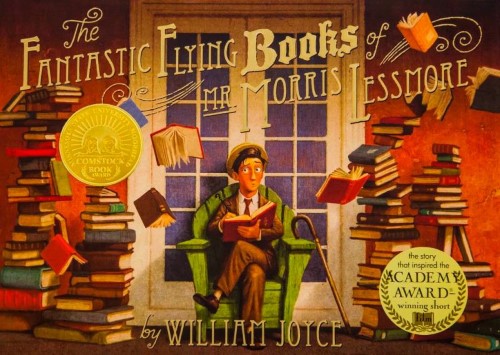
"Morris Lessmore loved words. He loved stories. He loved books." Morris Lessmore spends his mornings writing of his life's joys and sorrows until one day, a tornado tears apart everything, toppling houses and scattering the words of his life's book. In his aimless wandering, Mr. Morris Lessmore comes across a woman floating by, holding on to a "festive squadron of flying books." One such book leads Morris to the books' nesting place in an old antiquated library. Morris's life among the books begins. He cares for the many books in his possession, sharing the books with others, all the while continuing to write his life's story. When the years passed and the time came for the books to care for the now elderly Morris, he finishes his book. The book is found by a young girl, and our story ends with the opening of Mr. Morris Lessmore's book.
Joyce and Bluhm's lush multimedia illustrations are reminiscent of Pixar movies. In fact, the story is based on William Joyce and Brandon Oldenburg's Academy Award winning animated short film by the same name. Readers and children alike raved about the use of color in this book, as the characters move from black and white to color with the introduction of a good book. The detailed illustrations cemented the message of the story in a subtle way through the use of color. Many commented on the imaginative nature of the book, with its abstract and fantastical storyline. Students wanted more books by the author, and many begged to have the book read again.
William Joyce is the cofounder of Moonbot Studios, a storytelling and animation collective. Joe Bluhm, who made his picture book debut with this book, also works for Moonbot Studios. They both reside in Shreveport, Louisiana. BRITTANY LAZUR
The Busy Life of Ernestine Buckmeister written by Linda Ravin Lodding and illustrated by Suzanne Beaky (Flashlight Press). 2011
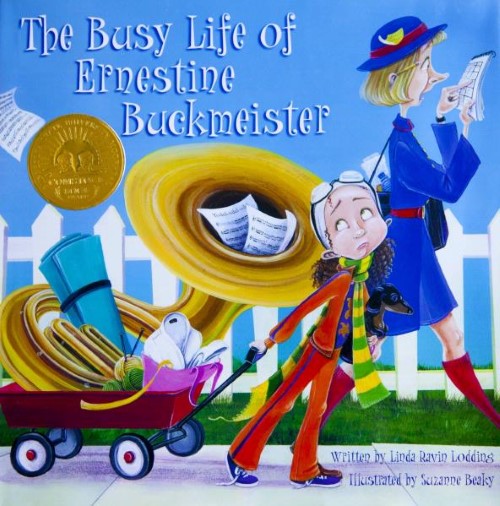
Ernestine Buckmeister's well-meaning parents zip out the door every day on their way to work, calling adages to their daughter like "Live life to the fullest!" and "Make every moment count!" Unfortunately, such mantras have manifested themselves in a busy extra-curricular schedule for young Ernestine. On Mondays, she has sculpting with Clay Lumpkin. On Tuesdays, Ernestine does water ballet with Miss Goldfisher. Wednesdays consist of knitting with Mrs. Pearl Stitchem, while Thursdays mean tuba lessons with Mr. Oompah. Fridays Ernestine yodels with Little Old Lady Hoo, Saturdays she does karate with Grand Master HiYa, and on Sundays, Ernestine Buckmeister practices yoga with Guru Prakash Pretzel. Between her schedule and her nanny to keep her on task, Ernestine has no time for play! Finally, Ernestine takes her schedule into her own hands.
The use of vibrant colors adds a whimsical feel to Beaky's acrylic illustrations. Double page spreads are effectively used to show the stress in Ernestine's life as well as the joy of play. Equally effective are the paneled paintings, which depict Ernestine at each of her activities with plenty of details and added humor. Beaky's facial expressions heighten the drama.
Children in grades one through six laughed at the names of the teachers and their personalities. They also appreciated the illustrations that were "filled with humor." Students related to Ernestine's busy life; one child even reported feeling like she was in the book. Readers appreciated the lessons to be learned from this story, both for children, who need to remember to play and be kids, and parents, who need reminders to allow their children to just have fun.
Linda Ravin Lodding, originally from New York, lives in Stockholm, Sweden, with her family. Suzanne Beaky lives in Huntingdon, Pennsylvania, with her husband and her two cats who make an appearance in this book. BRITTANY LAZUR
Stand Straight, Ella Kate: The True Story of a Real Giant written by Kate Klise and illustrated by M.Sarah Klise (Dial Books for Young Readers, an imprint of Penguin Group). 2010
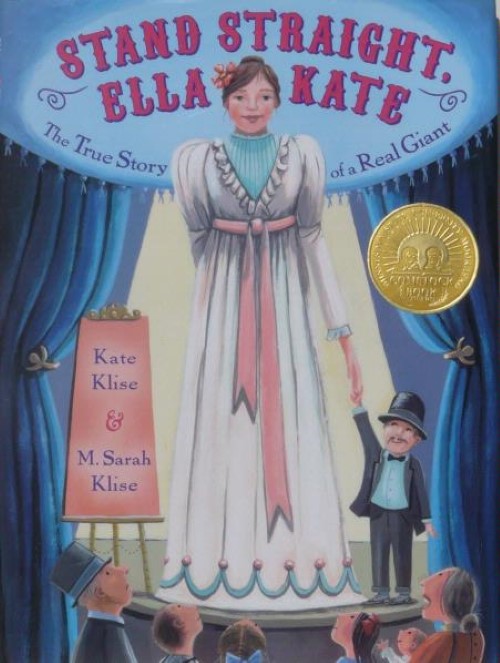
In this fictionalized biography, Ella Kate Ewing tells her own story about growing up to be a “real, live giant.” By age seventeen, Ella Kate was eight feet tall. Even though her parents wanted to protect her, she decides to accept a job from a museum manager in Chicago. He advertises her as “the tallest lady on earth.” Ella Kate made so much money that she paid off the debt on her family farm and built a house where she could stand straight. In the late 1800’s, she lived the life of an independent woman, making appearances around the country in exhibitions, traveling circuses, and even the world’s fair. “Stand straight, Ella Kate,” a saying she learned from her parents, became her mantra. Born in 1872, Ella Kate died in 1913 at the age of forty. An author’s note at the end of the book provides further information, including a description of the disorder “gigantism.” Ella Kate continues to be known in her home state of Missouri as the “Gentle Giantess.”
The book’s vertical trim size perfectly fits the subject. The muted acrylic illustrations provide details of the time period and aptly depict Ella Kate’s special abilities. Several teachers commented on the endpapers. A third grade teacher wrote: “The endpapers caused the real stir. Things like the size of Ella Kate’s shoes and gloves really got the children talking. They all wanted to compare their hands to hers.”
This book was popular with students from ages nine through twelve. Children were very attentive during the read aloud sessions and were inspired to ask questions and add comments. Fourth graders noted: “It was touching—how her life turned out positively despite a rough start.” One sixth grade teacher commented that the story led to a good discussion about differences and that he planned to recommend the book to the school’s social worker.
The author and illustrator, who are sisters, grew up in Peoria, Illinois. Kate Klise now lives on a farm near Norwood, Missouri, and M. Sarah Klise resides in Berkeley, California. CAROL HANSON SIBLEY
14 Cows for America written by Carmen Agra Deedy, in collaboration with Wilson Kimeli Naiyomah, and illustrated by Thomas Gonzalez (Peachtree). 2009

When Wilson Kimeli Naiyomah returns to his small remote village in Kenya, he tells his people, the Maasai, about being in New York City on 9/11 and witnessing the horrors of “fires so hot they can melt iron,” “smoke and dust so thick they can block out the sun,” and the loss of “more than three thousand souls.” To the Maasai, the cow is a symbol of life, so Kimeli offers his only cow to the people of America. In a sacred ritual attended by a diplomat from the United States Embassy in Nairobi, the Maasai add thirteen more cows to the gift and present “fourteen cows for America.” In the words of Kimeli: “We were helping to heal a people far away.”
The book’s back matter further explains this incredible act of hope and friendship. These sacred cows remain in Kenya where the herd has already grown to thirty-five. The herd has become a living symbol of peace.
Stunning, full-page illustrations created in pastels and colored pencils in tones of blues, greens, oranges, and browns, capture the vast Kenyan landscape and the beauty of the Masaai people in their native dress.
Fourth through sixth graders listened intently to this story. Teachers noted that this powerful book led to much discussion during and after the reading. One fourth grade class “wrote about what was interesting and shocking.” Children appreciated the illustrations with their vibrant colors, especially the portrayal of the ceremony to bless the cows. Teachers and their students found the note by Kimeli Naiyomah important for understanding the context of the story. One librarian’s comment reflects the heart of this story: “A touching book [of] how people reach out when a nation is hurting.”
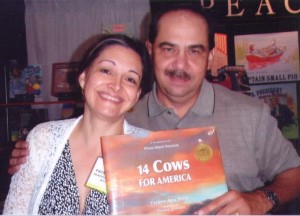 Carmen Agra Deedy and Thomas Gonzalez both immigrated to the United States from Cuba and now live near Atlanta, Georgia. Wilson Kimeli Naiyomah from Kenya has completed a master’s degree in molecular biology and now is pursuing an advanced degree and a career in peace and conflict resolution.
Carmen Agra Deedy and Thomas Gonzalez both immigrated to the United States from Cuba and now live near Atlanta, Georgia. Wilson Kimeli Naiyomah from Kenya has completed a master’s degree in molecular biology and now is pursuing an advanced degree and a career in peace and conflict resolution.
Abe Lincoln Crosses a Creek: A Tall, Thin Tale (Introducing His Forgotten Frontier Friend) by Deborah Hopkinson and pictures by John Hendrix (Schwartz & Wade Books, an imprint of Random House Children's Books. 2008
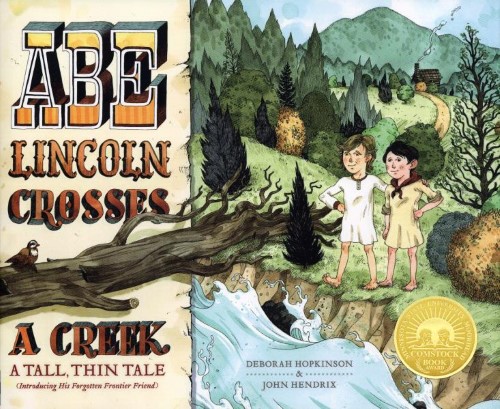
Imagine you are sitting on a Kentucky front porch hearing an experienced storyteller. The year is 1816 and the setting is the Kentucky valley near Knob Creek. Abraham Lincoln and his first best friend, Benjamin Austin Gollaher, better known as Austin, are about to get into a heap of trouble. Abe dares Austin to cross the high, raging waters of the creek to find some partridges. Since history doesn’t tell us exactly how the boys crossed the creek, the author/illustrator team adds tension by offering a couple of possibilities. The crux of the story though is that Austin makes it across, while Abe falls in, only to be saved by his steadfast friend. Abraham Lincoln never forgets his friend and years later as President during the Civil War, “Abe will be heard to say he’d rather see Austin Gollaher again than any other living man.”
The illustrations in watercolor and pen-and-ink and the book’s large horizontal trim size invite children into the story. The artistic process is even displayed on the endpapers where we see the illustrator doodling as he works to create just the right set of pictures.
Fourth through sixth graders listened intently to readers. They liked how the author talked and interacted with them and enjoyed how the illustrator drew the pictures as the story unfolded. Some of the students commented that Abe and his friend were just normal kids, and others were surprised that Abe disobeyed his mother (who had told him not to go near the creek). One fifth grader stated the author’s moral in his own words: “What we do matters; someday it may be history.”
 Author Deborah Hopkinson lives with her family near Portland, OR, while illustrator John Hendrix lives in St. Louis, MO with his wife and son. (Carol Hanson Sibley)
Author Deborah Hopkinson lives with her family near Portland, OR, while illustrator John Hendrix lives in St. Louis, MO with his wife and son. (Carol Hanson Sibley)
The Boy Who Was Raised by Librarians written by Carla Morris and illustrated by Brad Sneed (Peachtree). 2007
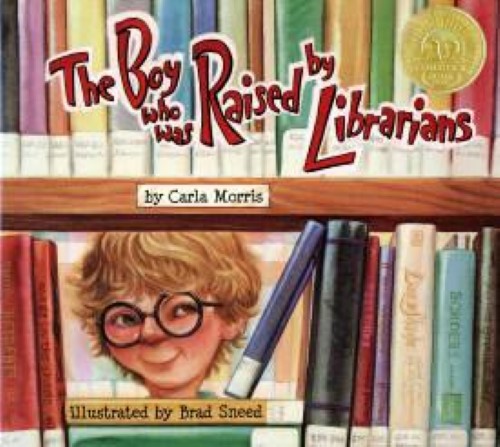
Melvin loves the Livingston Public Library which he visits every day after school. There he befriends reference librarians Marge, Betty, and Leeola, who answer his many questions and help him with school projects and contests. Melvin attends all the library programs, including movie nights and sleepovers. In high school he works part-time in the Library and at his graduation his librarian friends beam with pride. The story has a satisfying, cyclical closing when another young boy comes to the library and gets help from the new librarian—Melvin!
This homage to librarians is brought to life with Brad Sneed’s detailed and humorous watercolor and gouache illustrations. Each librarian, along with Melvin, age appropriately as Melvin grows up to finally join them at the Livingston Public Library.
Students in grades three and four were great fans of this story. They enjoyed the humor, the interesting characters, and the detailed illustrations. The topic of libraries was a popular theme. The children liked learning how librarians find all kinds of information and “how smart librarians are.”
Carla Morris, who is the children’s librarian at the Provo City Library in Utah, got the idea for this book from a “real boy who blossomed under the wings of Provo’s librarians.” Carla lives with her husband and three children in Springville, UT. The Boy Who Was Raised by Librarians is her first children’s book.
 Illustrator Brad Sneed lives near Kansas City, KS with his wife, a daughter, a dog, two rats, and a gecko.
Illustrator Brad Sneed lives near Kansas City, KS with his wife, a daughter, a dog, two rats, and a gecko.
Epossumondas Saves the Day written by Coleen Salley and illustrated by Janet Stevens (Harcourt). 2006
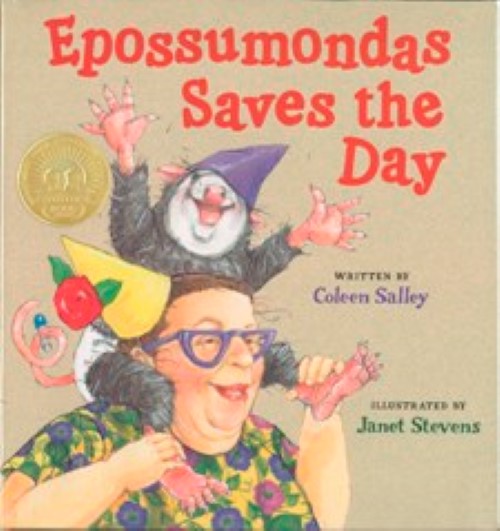
It’s a rare picture book, indeed, that appeals to children of all ages. Epossumondas Saves the Day is one of those special treats. Author Coleen Salley appears in her book as Epossumondas’s Mama. Mama is getting ready to make the opposum’s favorite birthday dessert, but she needs baking soda, that is, sody sallyraytus. The characters in the story take turns going to the plantation store to get sody but on the way home are swallowed in one gulp by the GREAT, HUGE UGLY LOUISIANA SNAPPING TURTLE. Epossumondas saves the day. When he faces the snapping turtle, Epossumondas retaliates by throwing box after box of sody at him. The snapping turtle gulps down all of it until he puffs up so big that he pops out all the people he swallowed, including Mama. Everyone then goes home to celebrate the best birthday party ever, which, of course, includes Epossumondas’s favorite biscuits with strawberries.
This is a story that demands to be read aloud. It was appreciated by three-year-olds through sixth graders. The colorful language is poetic and memorable. Children enjoyed the rhythm and repetition and continued chanting “Sody! Sody! Sody sallyraytus!” long after the book was read. The comic details of the large-size mixed media illustrations appeal to children. Fourth graders spontaneously clapped at the end of the story, and sixth graders were so engaged that they volunteered to give up their free time to finish the book. All ages savored this story and wanted it read again and again.
Coleen Salley, a retired children’s literature professor and professional storyteller, lives in the French Quarter of New Orleans. This is her third book about Epossumondas. Illustrator Janet Stevens resides in Boulder, CO. In 2006 she won the Wanda Gág Read Aloud Book Award for The Great Fuzz Frenzy.
Dad, Jackie, and Me written by Myron Uhlberg and illustrated by Colin Bootman (Peachtree). 2005
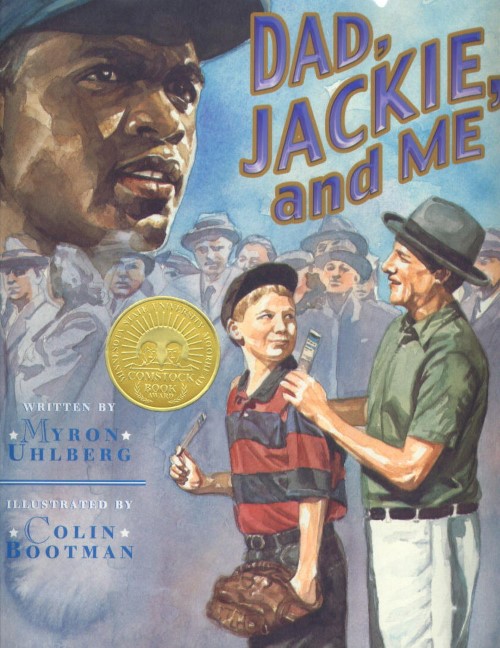
A young baseball fan narrates this story about his father who suddenly has a keen interest in baseball because of Jackie Robinson playing for the Brooklyn Dodgers. The father who is deaf identifies with the prejudice and discrimination faced by Jackie Robinson. During the course of the 1947 baseball season, the father and son attend and listen to the games, learn everything about Jackie Robinson, and keep a scrapbook of newspaper clippings about this famous player. The father, who never had the opportunity to play baseball, also practices catching with his son. The climax of the story comes after Robinson catches a line drive at the end of the last game of the season and turns and throws the ball to the narrator’s father who is able to catch it in his bare hands. While the story revolves around the 1947 baseball season, the real strength of the book is the strong bond that develops between father and son.
In the “Author’s Note,” Uhlberg explains that he attended Jackie Robinson’s games with his own father who was deaf. He came to understand the deep connection between his father and Jackie Robinson: “They were both men who worked to overcome thoughtless prejudice and to prove themselves every day of their lives.”
Colin Bootman’s framed, watercolor illustrations detail the Brooklyn setting, Ebbets Field, and the Brooklyn Dodger games. Riveting close-ups show Jackie Robinson batting, running, and playing first base. The scrapbook-page endpapers of actual newspaper clippings reflect the scrapbook from the story.
Nine-year-olds through twelve-year-olds listened intently to this book. They commented on the great illustrations and enjoyed learning more about Jackie Robinson. Teachers and parents noted that the story led to good discussions about disabilities and discrimination.
Myron Uhlberg, who grew up in Brooklyn, now lives in Palm Springs, CA. Colin Bootman, originally from Trinidad, currently lives in Brooklyn, NY.
Elena's Serenade written by Campbell Geeslin and illustrated by Ana Juan (Anne Schwartz/Atheneum Books for Young Readers). 2004

Elena’s Serenade is the first book to receive the Comstock Read Aloud Book Award for the year’s best picture book to read aloud to older children, ages eight to twelve.
Young Elena leaves her home to embark on a magical journey to Monterrey, Mexico in order to follow her dream of learning the art of glassblowing. Later, she returns home to her father, who had refused to teach her his trade because no one had ever “heard of a girl glassblower.” Now Elena and her father work side by side; he produces typical bottles and glasses, while Elena combines song with her glassblowing to create “birds, stars, butterflies.” This story celebrates Elena’s uniqueness as an artist and a person, as well as the importance of pursuing a dream.
With acrylic and crayons, Juan has created luminous paintings with an expressionistic, folk-art quality and a palette of desert colors. Juan’s use of light is particularly noteworthy, especially in the illustrations depicting glassblowing. The rounded figure of Elena and her expressive facial features make her an attractive character. The colors, movement, and details of each painting invite one to linger over every page.
In selecting this book for the Award, the Read Aloud Book Award Committee noted the lyrical quality of the text, as well as children’s special appreciation of the illustrations. In addition, children were interested in the conflict between Elena and her father and also enjoyed the sprinkling of Spanish words. Readers found the Spanish-English Glossary in the front of the book helpful.
Author Campbell Geeslin lives in White Plains, NY and illustrator Ana Juan resides in Madrid, Spain.
Listen: How Evelyn Glennie, a Deaf Girl, Changed Percussion written by Shannon Stocker and illustrated by Devon Holzwarth (Dial Books for Young Readers). 2022

A percussionist renowned the world over, Evelyn Glennie has performed in over 40 countries, with over 200 ensembles, playing music that more often than not, has been written for her. She has done all this, achieving the highest honors in her field, all while being deaf. After learning, at the age of eight, that she would never be able to hear without hearing aids and that playing music would not be an option for her, Evelyn found percussion. Even though a listening test threatened to block her path to lessons, Evelyn found a teacher that was willing to take a chance on her. It was through this teacher, Mr. Forbes, that Evelyn discovered how to “listen” through feeling the vibrations of the instrument and a whole new world of sound opened up to her. Through determination, practice and refinement of this new found skill, Evelyn’s talent led her eventually to the Royal Academy of Music and the distinction of being the first performer to make a career of being a solo percussionist. Through ribbons of vibrant and flowing colors, as well as poetic and sometimes percussive language, Listen invites each reader to step into Evelyn’s remarkable story as they consider their own unique gifts.
Students ages nine to twelve were quickly captivated with this inspiring story of perseverance and overcoming obstacles. One reader noted that the child she was reading to “started more relaxed in her chair, but by the end she was sitting straight up”. Another reader commented that students were “captivated right away, and truly felt the sadness of the girl losing her hearing.” Readers also mentioned how the illustrations impacted the reading experience. In general, readers felt that the illustrations really made the story come alive through use of color and movement and that they supported the text well. Most notably, however, was the impact of the book’s theme. All readers found that the message of perseverance and problem solving was inspirational and well-received by their students.
Shannon Stocker is an award-winning author from Louisville, KY and has written for both the Together We Can series and Chicken Soup for the Soul. Devon Holzwarth is a picture book illustrator, author, painter currently living in Germany. Her most notable picture books include Tia Fortuna’s New Home, a 2203 Sydney Taylor Picture Book Notable winner. Shannon and Devon won the 2023 Schneider Family Book Award for Listen: How Evelyn Glennie, a Deaf Girl, Changed Percussion. [LOUIE LAUER]
Honor Books
Into the Goblin Market written by Vikki VanSickle and illustrated by Jensine Eckwell (Tundra Books). 2024

In Vikki VanSickle and Jensine Eckwell’s Into the Goblin Market, we meet Millie who is quite happy living her quiet life. She does not have an interest in going beyond the boundaries of her family’s little farm. Her sister, Mina, however, dreams of adventure. One night, when the goblin market has come to town, Mina wants to go even though Millie warns her that, “The Goblin Market isn’t safe. It is a tricky, wicked place.” When Millie awakes the next morning, she finds Mina gone, she realizes she must go after her sister and get her back home. Mina is scared and worried she was not wise enough to be able to trick the goblins and save her sister. This tale expertly brings older elementary age children into the world of magic, trickery, and fantasy as it brings together the rogue characters from some of the classic tales and weaves this suspenseful tale into a work of literary art.
Young readers were intrigued by this unique story and appreciated seeing elements from some of their favorite folk tales. The cadence of the rhyming helped the reader slow down and as one reader remarked, the story “told in verse made it interesting.” Jensine Eckwall, filled the pages with delightfully dark images with details that guide the young reader through the story or make the listener gasp, like when the picture of the wolf’s eyes are staring back at them. The illustrations were described by young listeners as the perfect blend of cool but also a little bit scary. Many noted the use of color, specifically the touches on each page that as one listener explained, was used to, “to signal the importance of that object.” A young reader could easily spend an extended amount of time poring over the images and text, making new meaning out of this story with each additional read.
Vikki VanSickle, author of a number of award-winning children’s novels and picture books. Ms. VanSickle currently resides in Toronto, Canada, where she can find treasured books to share on a Canadian Morning TV show. Jensine Eckwall, residing in Queens, New York, has illustrated the cover of several middle-grade novels and picture books. In addition, you may have seen Ms. VanSickle work in the New York Times, The Boston Globe, and Marvel Comics.
The Dictionary Story written and illustrated by Oliver Jeffers and Sam Winston (Candlewick Press). 2024

Even though the Dictionary has nearly all the words that have ever been written, she never gets a chance to tell a story. That is until one day when a hungry Alligator goes off in search of a Donut. The once orderly Dictionary is now all a jumble, as the Alligator dashes through an unexpecting Ghost, rushes past a ruling Queen, and causes a complete uproar when a bar of Soap lands on top of a Tornado. Total mayhem ensues as all the words get swept up in the Tornado’s fury, mixing up the order and creating utter confusion. Once the Dictionary realizes that this is NOT what she had intended, a very concerned Dictionary enlists the help of a friend to get things back the way they used to be. Oliver Jeffers and Sam Winston have crafted an uproarious wordplay bonanza, complete with handcrafted definitions, laugh-out-loud illustrations and design elements that will have students coming back to this book time and time again.
Students ages eight through eleven showed great interest in this story through their facial expressions and exhibited great attention throughout. Readers also noted that students pointed or commented at elements of the story, laughed spontaneously, and asked for either a re-read or to look at this book on their own. One reader noted, “the words were so silly and created such a wonderful story, and the students were raving about it afterwards”. Another reader added that there was so much figurative language included in this story that she saw this book as a resource for many Language Arts lessons. Visually, readers noted how much students appreciated the detailed and colorful illustrations, as well as the interruptions of speech balloons and mixed-up words throughout.
Oliver Jeffers is an artist from New York whose works range from paintings and art installations to picture book illustration. His books for children include, Stuck, Lost and Found, The Day the Crayons Quit, and A Child of Books, which he collaborated on with co-creator Sam Winston. Sam Winston is a London based writer and artist known for his works held in museum collections around the world. His picture books include One and Everything and A Child of Books.
Finding Papa written by Angela Pham Krans, illustrated by Thi Bui (Harper, an imprint of HarperCollins). 2023
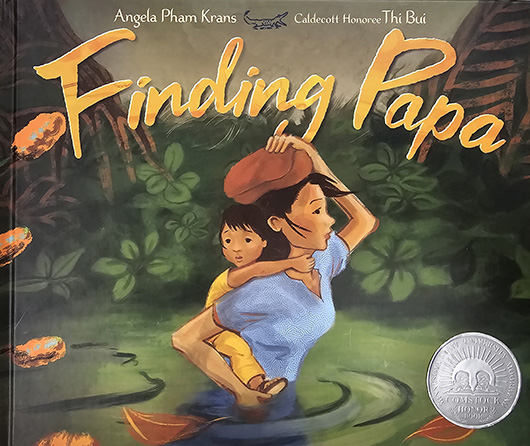
Mai loves playing “crocodile” with her Papa, even though crocodiles are scary Papa is not. Then one morning Papa’s goodbyes take longer than usual and he doesn’t come home that night. Mai’s Mama tells her “Papa is finding a new home for us.” Mama and Mai continued to live in Vietnam, receiving letters from Papa and waiting. One night, Mama packed a bag and thus began Mai’s adventure. Based on the real-life journey of the author and her mother in 1983, Finding Papa follows Mai and her mother as they follow the path Mai's father took from Vietnam to the United States of America to reunite their family.
Students aged eight through twelve listened attentively to the reader and scooted closer to view the illustrations. They had empathy for Mai, missing her father and her feelings while on the journey to the United States. Classes discussed the journey immigrants make and the obstacles they face. One teacher said “The author did a great job turning a true experience into a narrative for younger students to understand."
Author Angela Pham Krans is a children’s book author. Finding Papa, her debut picture book, is based on her experience as a child. She lives in Atlanta with her family. Illustrator Thi Bui is an award-winning graphic novelist and illustrator. She immigrated from Vietnam to the United States of America as a child and currently teaches at the California College of the Arts. In 2018, she won the Caldecott Honor for A Different Pond.
Remembering written by Xelena Gonzalez, illustrated by Adriana M. Garcia (Simon & Schuster Books for Young Readers, an imprint of Simon and Schuster Children’s Publishing Division). 2023
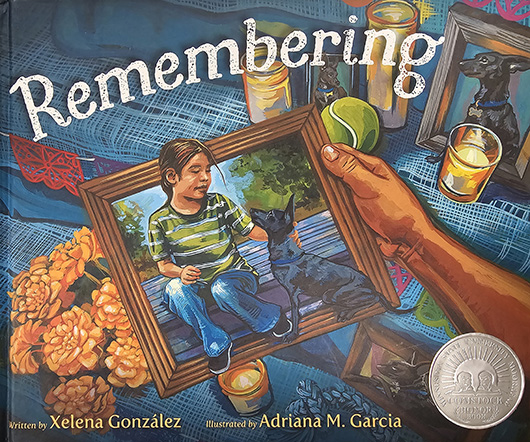
Remembering is a poignant exploration of familial bonds and cultural heritage, highlighting how the act of remembering a loved one lost can be healing for those left behind. This story follows a child and their family, celebrating the life of their pet dog, Simon, and building an ofrenda in remembrance of him. The custom of celebrating Dia de Muertos and building a remembrance altar is a strong cultural tradition in Mexico and throughout the Americas. Throughout the story, the child goes through the daily rituals like providing food and water for the dog, going on a favorite walk and collecting items the dog would have liked, and sharing stories and memories with their family. The poetic prose of the story explores the healing power of remembering through sharing with loved ones. The end pages provide more details on the cultural tradition and how to build your own ofrenda. Throughout the story, the author and illustrator highlight the universal experience of loss, reminding readers of the shared emotions and healing journeys that accompany the departure of loved ones
After listening to this book,an overwhelming number of responses focused on how students were able to relate to the story and how many of them had experienced loss of some kind, including the loss of a pet. In addition to being able to relate to the story, students also liked learning about the cultural tradition of celebrating Dia de Muertos and creating an ofrenda, which was new to many of them. Some specific comments from students included, “this was such a sweet book, even though it was sad. It taught us a way to remember and celebrate pets and people after they are gone and how different people do that.” Many comments also noted the vivid illustrations and how they really reflected the feelings that were happening in the book.
Xelena Gonzalez is a poet and storyteller who has won multiple awards for her picture books All Around Us, Where Wonder Grows, and Remembering. She is a member of the Tap Pilam Coahuiltecan Nation and lives in San Antonio, where she grew up. She wrote Remembering as a way to ease her own loss of her cat, Buju, and to share her traditions as a way of comforting others.
Adriana M. Garcia is a muralist and illustrator who has won the Pura Belpre Illustrator Award for Where Wonder Grows and Honor for All Around Us. She lives in San Antonio, where she was born and raised. She illustrated Remembering shortly after losing her own dog, Simon, and illustrating this book helped her honor his memory and heal from his loss. Xelena and Adriana have worked on multiple award-winning picture books together.
A History of Me written by Adrea Theodore and illustrated by Erin K. Robinson (Neal Porter Books). 2022
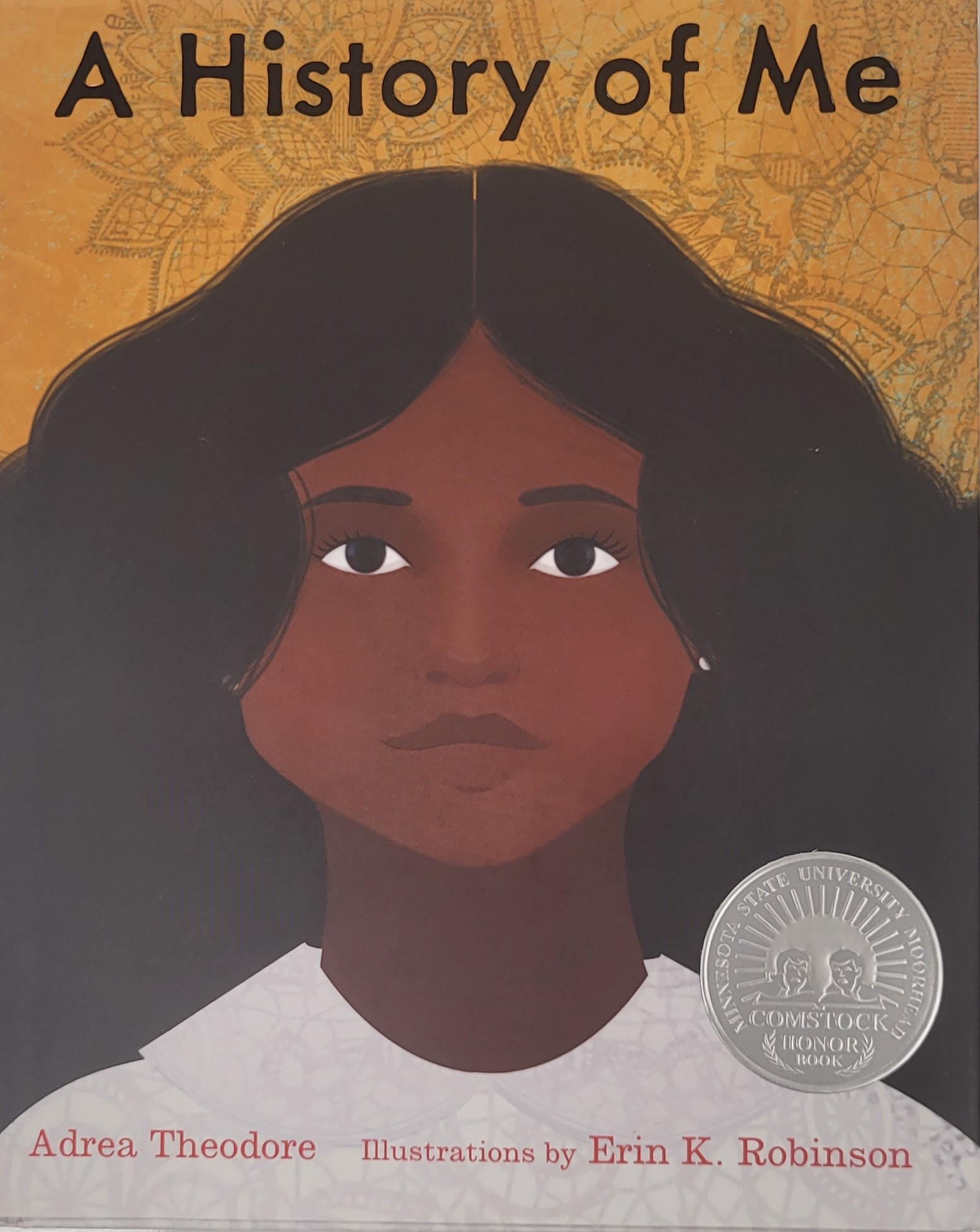
A History of Me tells the story of a young girl who is the only brown person in her class and is learning about historical topics like slavery and civil rights. This picture book takes the reader through generations of a family, alternating between the perspective of the young girl and the stories of her ancestors and their past experiences. She expresses her feelings as they learn about slavery, and then transitions to the history of her great-great-grandmother who was a slave. She moves through learning about Civil rights and her great-grandmother, her own racist encounter with a boy from school, and her mother’s experience also being the only brown person in her class. Interspersed between each page’s story is the idea that the author loves school, loves to learn, but faces unique challenges because she is the only one with brown skin in her class. Towards the end, the narrator addresses that her daughter has the same experiences, but she is able to teach her that even though most of what is taught regarding history and racism focuses on the hardships and struggles, but there is also “courage, strength, intelligence, and creativity”. The narrator’s ending message to her daughter is that she should be proud of who she is and her history and that she can choose to be anything she wants to be.
As students listened to this book being read aloud, they showed high levels of interest through their focused body language, pointing out specific aspects they noticed and asking reflective questions as they listened. Some of the comments from students included that they liked the “real life” aspect and the mother-daughter connections and sharing about the past. They felt the connection of the mother sharing her experiences with the daughter and allowing her to be herself was powerful. Many students related to this book and the experience of being the only brown student at some time or another and many students found the content and message important. Comments also emphasized how strongly the illustrations supported the story and added to the message.
Author Adrea Theodore is a children’s book author, mother and pediatrician currently residing in Durham, North Carolina. She grew up loving reading, writing, and language, and was inspired to write this story when she realized the experiences her daughter had in elementary school learning about slavery and civil rights were the same as the ones she herself experienced. A History of Me is Adrea’s debut picture book. [JEN HESS]
Hello, Opportunity: The Story of Our Friend on Mars written by Shaelyn McDaniel and illustrated by Cornelia Li (Page Street Kids). 2022
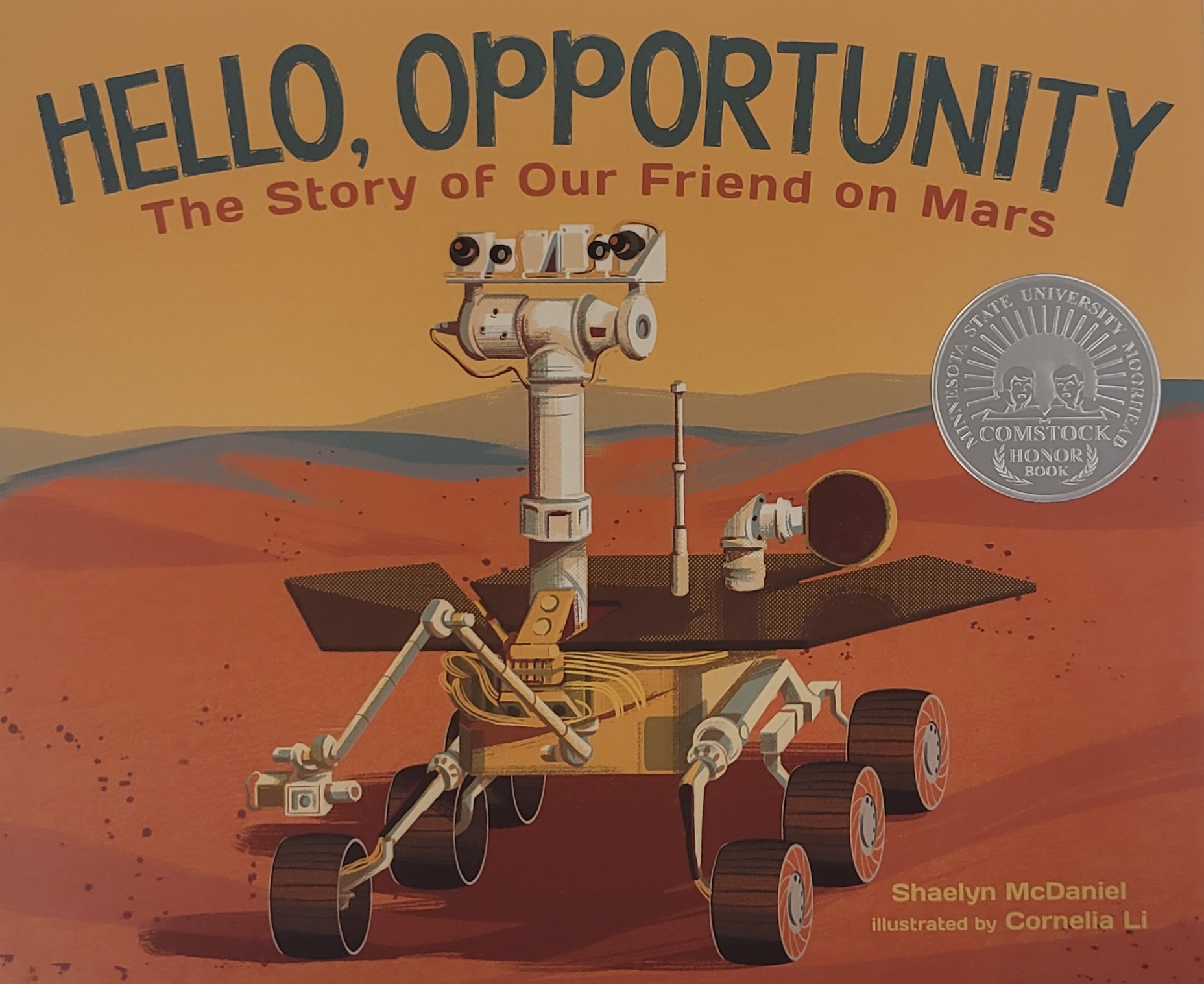
Hello, Opportunity: The Story of Our Friend on Mars, introduces young readers to the evolution of space exploration. Focusing on the Mars Rover Opportunity, readers learn about how “Oppy” was designed, built, and launched. Updates from the mission show the relationship between their NASA team and this little robot with big drive and personality. Initially launched in 2003, Mars Rover Opportunity supplied data consistently for 15 years, far surpassing the originally anticipated 3 months. Opportunity collected images, weather reports, and mineral samples.
Students enjoyed learning about the development of the human interest in space, and the science that took us from “we want to go there” to “so we did!” There was particular interest in the materials used to build the rover, and how a robot could process and “think” of responses. Readers reported an empathetic response to Opportunity’s fate in June of 2018, and exhibited further curiosity about space exploration after the book was read.
This is author Shaelyn McDaniel’s debut title. A Florida native living in New York, she drew inspiration from her own misunderstanding about space exploration to help young readers learn more about Mars. Illustrator Cornelia Li is a celebrated freelance Canadian artist. She adds Hello Opportunity to a body of 9 other children’s books, many of which focus on human interactions with space and nature. [MADDISON MELQUIST]
The Story of Bodri written by Hédi Fried, illustrated by Stina Wirsén, and translated by Linda Schenck (Eerdmans Books for Young Readers). 2021.
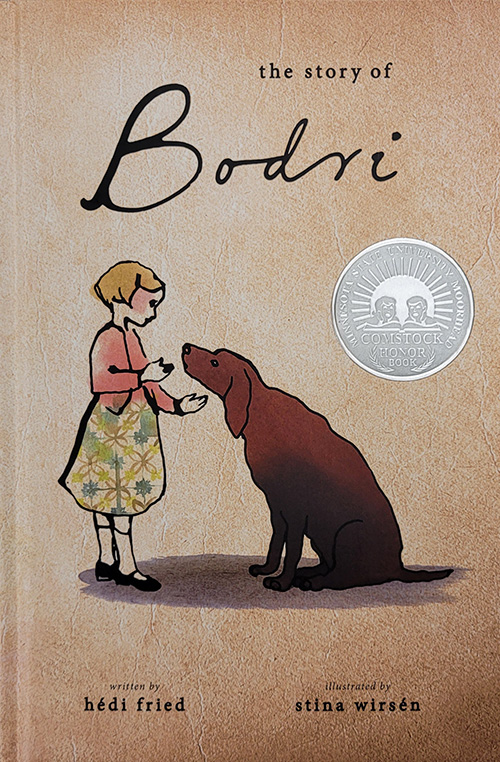
Inspired by a child’s question about the fate of family pets during the Holocaust, The Story of Bodri provides a window into overlooked aspects of Jewish life under the Third Reich. The author recounts days playing with her two best friends: her dog, Bodri and her friend, Marika. As the shadow of Hitler’s power falls over her town, Hédi’s family is deported to concentration camps along with other Jewish residents. Bodri and the other family pets try to follow but are left behind. Hédi’s love for Bodri gives her enough strength and hope to survive the camps. The book ends when Hédi is reunited with Bodri who is overjoyed to hear her voice once again.
When read this book, students ages eight to twelve gained a new perspective on this important historical time period. Students appreciated learning through the experiences of a beloved pet and particularly enjoyed the minimalist watercolor artwork and color schemes. Teachers noted that this was the first time several students had heard about the Holocaust and the book sparked interest in further discussions and research on the topic. One teacher stated that “the book elicited a high level of engagement and conversation.”
Author Hédi Fried writes and lectures frequently about her experiences as a teenager during the Holocaust. This is her first children’s book. Artist Stina Wirsén works in a variety of mediums and has worked on several children’s books. The Story of Bodri is her first book published in English. Both author and illustrator live in Sweden and met during a mutual project promoting human rights and democracy. [MADDISON MELQUIST]
Monet’s Catwritten by Lily Murray, illustrated by Becky Cameron (Random House Studio). 2021.

Join French painter Claude Monet as he chases his cat through some of his most famous paintings. With just three taps of his paintbrush, Chika, Monet’s porcelain cat, comes alive and immediately heads down the hallway. When Monet spies Chika actually inside his painting, The Luncheon, he jumps in to catch her, and the reader is immersed in the world of Impressionism. Each time Monet gets close to catching his cat, Chika takes off again, exploring (and changing) yet another painting. It’s not until both cat and painter enter the Bridge over a Pond of Water Lilies, that both pause to take a look around and admire the world inside this beautiful painting. Based on the actual porcelain cat that can be found sleeping in Monet’s house, this fictional story gives young readers an introduction to the paintings of Monet, as well as Impressionism in general. As a jumping off point for an art project or as just conversation starter about Impressionism, this title will be sure to elicit some oohs, some aahs, and maybe even an oh là là!
Children from ages nine to twelve showed great interest in this book. All teachers noted that their students had facial expressions that showed interest and intent attention, and that students noticed or commented on something in the jacket, cover or end papers. Teachers also noted several examples of students pointing to something in the story or making unsolicited positive comments about the story. Teachers appreciated that this was an accurate introduction to the paintings of Monet and one teacher commented, “After we read the book, students wanted to learn more about Monet.” Several mentioned how their students enjoyed seeing Chika throughout the story and that they appreciated the information about Chika included in the backmatter.
This is the first collaboration between Lily Murray and Becky Cameron. Murray is a children’s book author who has written over thirty children’s books and lives in Surrey, England. Cameron is a British author and illustrator who has been creating books since 2018 and lives in Oxfordshire, England. [LOUIE LAUER]
Flight For Freedom: The Wetzel Family's Daring Escape from East Germany written by Kristen Fulton, illustrated by Torben Kuhlman, and published by Chronicle Books, 2020.
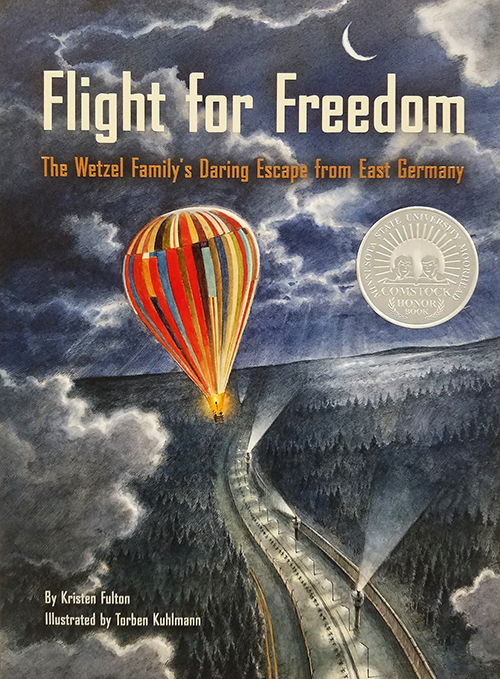
This vividly narrated and cinematically illustrated true story is told by six-year-old Peter Wetzel, whose family successfully fled Communist East Germany in 1979 by means of their home-made, hot-air balloon. Their bold flight to freedom into West Germany lasted only 30 minutes, but covered 15 miles and landed safely landing in Naila, Bavaria, where a colorful sign indicating their landing-site can be seen today.
School children, ages 9-12, greatly enjoyed hearing this book read to them. Comments from readers were that “It was very suspenseful and the kids were absolutely silent during the reading. … We loved it that it was about a family.” Students appreciated the book’s endpapers with a detailed map of the path the balloon traveled.
The author, Kristen Fulton lives in Florida. She met the Wetzel family patriarch, Günter, and was captivated by the family’s flight for freedom. Fulton re-traced the sky-journey from Oberlemnitz to the now-famous Bavarian landing-site near Naila, Germany. Torben Kuhlmann, is an award-winning German children’s book author who lives in Hamburg. His full-page and double-page spreads with stunning close-up and long-range details create the illusion that while turning the pages you are watching a movie. [KONRAD A. CZYNSKI]
A Bowl Full of Peace: A True Story written by Caren Stelson, illustrated by Akira Kusaka, and published by Carolrhoda Books, 2020.
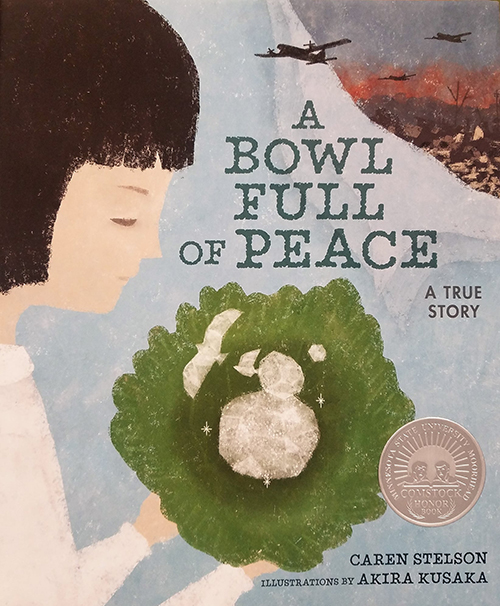
Sachiko’s story begins with her family enjoying meals together served in Grandmother’s precious bowl, which has been handed down for many generations. As World War II grows closer, schools close, food becomes scare, and air raid sirens wail. On August 9, 1945, when Sachiko is just six-years-old, an American plane drops a nuclear bomb on Nagasaki, Japan. Sachiko’s youngest brother dies in the blast and the family flees the city. When they return two years later, Father digs through the rubble at their former home and miraculously finds Grandmother’s bowl, completely intact. On each anniversary of the bombing, Mother fills the bowl with ice to remind them of how the ice chips soothed their burning throats in the days after the bombing. The bowl and the ice become a symbol of peace. Finally, only Sachiko has survived. Fifty years after the bombing, Sachiko uses the bowl and her voice to share her story and talk to Japanese children about peace.
Author Caren Stelson lives in Minneapolis, Minnesota. She made numerous trips to Japan to interview Sachiko and to conduct research. She has also written a longer middle grade biography entitled Sachiko: A Nagasaki Atomic Survivor’s Story. In a video interview, Stelson states that we all need a bowl full of peace. She suggests that in addition to peace our bowls might hold resilience, love, empathy, and compassion. Japanese illustrator, Akira Kusaka, digitally created the illustrations to have a chalky, weathered effect. Soft shades represent times of peace, while black and red colors show the horrors of war. Kusaka remembers his grandmother telling him about her experiences in the war. In the book’s back matter, he states that soon there will be no witnesses left of the horrors of the nuclear bombs and states, “That is why Sachiko’s story of surviving the atomic bomb is especially important.” [CAROL HANSON SIBLEY]
Elvis Is King! written by Jonah Winter, illustrated by Red Nose Studio (Schwartz & Wade Books). 2019

How did a poor boy from Tupelo, Mississippi rise to become king of rock ‘n’ roll, “the biggest star the world has ever known”? In this picture book biography, readers learn how singing eased the pain of Elvis’ young life “because there ain’t nothing better for the soul than singing.” The story follows the family’s move to Memphis and Elvis’ transformation as he creates his first records, changes his looks, and converts his nervousness to his iconic onstage shaking that “starts an AVALANCHE of screaming” from the teenage girls.
An author’s note provides additional details about Elvis’ early life. Winter explains that the music industry was highly segregated. The foundation for Presley’s fame was being a white musician, singing “black music” for white teenagers. Even though he was famous, Winter notes that Presley was lonely all his life, pouring his feelings into his songs. “His music gave his original audience—mainly 1950’s white teenagers—the freedom to feel.”
The illustrations by Red Nose Studio are as attention-getting as Elvis himself. The illustrations are photos of hand-built three-dimensional scenes. The inside book jacket details how the sets were “scratch-built” with readily available materials. Some of these include pieces of foam, cardboard, masking tape, wire, thread, and stick pins. The Studio used polymer clay to create Elvis with sculpted details made with old dental tools. The design of this book is truly noteworthy. The front book jacket shows a close-up of Elvis’ flipped up black hair with the back cover capturing a jittering Elvis onstage. The front book cover shows an empty folding chair, a broken-down guitar, and a glittering star. Inside the book jacket is a treasure trove explaining how the art was made. Librarians—do not tape down the book jacket to deprive readers of these visual surprises!
Students ages nine through eleven especially liked how the story flowed. Winter uses headlines to introduce the main events of Elvis’ young life and then elaborates in poetic language. Students were especially interested in how someone so poor and unpopular could become rich and famous. Fifth graders commented that the story “made history into a really great book” and a fifth-grade teacher noted that this is a “unique biographical book to introduce young listeners to a legend.”
Jonah Winter is an acclaimed author of many nonfiction picture books, especially biographies. He was born and raised in Texas. Chris Sickles, of Red Nose Studio located in Greenfield, Indiana, grew up on a small family farm where he learned to fix things with what was at hand. Besides his “puppets” and hand-built sets, he is passionate about motorcycles. (CAROL HANSON SIBLEY)
Sergeant Billy: The True Story of the Goat Who Went to War written by Mireille Messier, illustrated by Kass Reich (Tundra Books). 2019
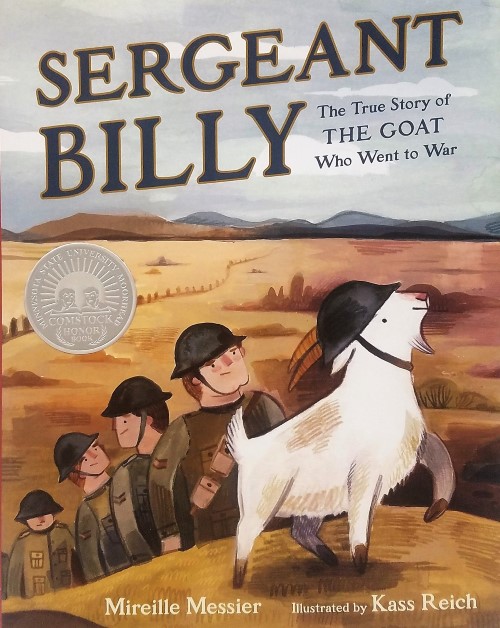
Stories about animals who go to war intrigue intermediate age readers. In this true story set during World War I, soldiers from the Fifth Canadian Battalion borrow a goat from a young girl in Broadview, Saskatchewan. Billy provides comfort for the young soldiers as they train for war. They become so attached to their goat that they smuggle him aboard the ship to England and then to France to fight on the front lines. While the book has a light-hearted tone, readers do learn of the challenges of war—mud, foul food, and rats in the trenches. When Billy nibbles on some secret documents, the colonel places him under arrest and in jail for being a spy! However, when the soldiers become unhappy, bored, and grumpy, Billy is returned to his Battalion. Billy suffers as do the soldiers with trench foot and shellshock. For capturing an enemy and saving soldiers’ lives, Billy is promoted to sergeant and is decorated as a war hero. When the war is over, the soldiers keep their promise and deliver Billy back to his original owner.
The cartoon style hand-painted artwork in muted tones of brown and green gouache help readers visualize the war setting. The beautiful red poppies on the endpapers are a reminder of how the poppy is a symbol of remembrance for the First World War.
This story received high marks from readers in grades three through five. Students appreciated the book’s back matter, including photographs and information about Sergeant Billy after he returned home to Canada in 1919. One fourth grader commented: “If the author didn’t write this book, we wouldn’t know animals were in war.” A teacher noted that the story “got students interested in researching and reading other books about animals in wars.” In fact, a perfect companion to Billy’s story is Finding Winnie: The True Story of the World’s Most Famous Bear, which was the recipient of the 2016 Comstock Read Aloud Book Award.
Author Mireille Messier, a resident of Toronto, Canada, remarked: “I hope that readers will learn that service animals and military mascots like Billy played an important role in history. I also hope that this story will remind them of how strong the bond between humans and animals can be, even in wartime.” Illustrator Kass Reich has lived and traveled extensively abroad. Her work with children has inspired her to create picture books. She is now back home in Canada, living in Toronto. (CAROL HANSON SIBLEY)
The Day War Came by Nicola Davies, illustrated by Rebecca Cobb (Candlewick Press). 2018

In this universal story for all ages, a young girl enjoys a typical morning at home and a day at school until the war comes and she is left without her family. She cries, “War took everything. War took everyone.” A double-page spread shows her grueling journey to a refugee camp. When she walks through a nearby town, adults turn away, including a teacher who tells her there is no room and no chair for you. In an act of compassion, a young boy from that classroom brings her a chair and his classmates line the road to the camp with chairs “so that all the children here can come to school.”
Author Nicola Davies first wrote this text in anger when the United Kingdom government refused to take in 3,000 unaccompanied child refugees. In an act of solidarity, artists contributed drawings of 3,000 empty chairs, symbolic of the plight of children who are denied refuge. Davies’ timely poem has now become this notable picture book. Rebecca Cobb’s pencil and watercolor illustrations capture the devastation of war, the difficult journey, and finally the kindness of fellow children.
Hopefully this book will inspire readers to take action, perhaps in their own communities. Third through fifth graders appreciated this powerful book. Teachers commented that the first-person point of view helped children understand the emotions of the young girl and how it must feel to be a refugee. Students thought about their own classmates and commented, “We have friends who have experienced this.” The story also led to discussions about why the U.S. is not admitting many refugees. Students realized that: “kids can change the world.” The author’s note summarizes the importance of this book: “I want this story to remind us all of the power of kindness and its ability to give hope for a better future.”
Nicola Davies, a zoologist and animal lover, has written many non-fiction science books for young readers. She lives in Wales. Illustrator Rebecca Cobb lives in Falmouth, England. In a recent interview, she commented that she wanted the illustrations to be universal and relatable to refugee children. [CAROL HANSON SIBLEY]
Pocket Full of Colors: The Magical World of Mary Blair, Disney Artist Extraordinaire written by Amy Guglielmo and Jacqueline Tourville, illustrated by Brigette Barrager (Atheneum Books for Young Readers). 2017
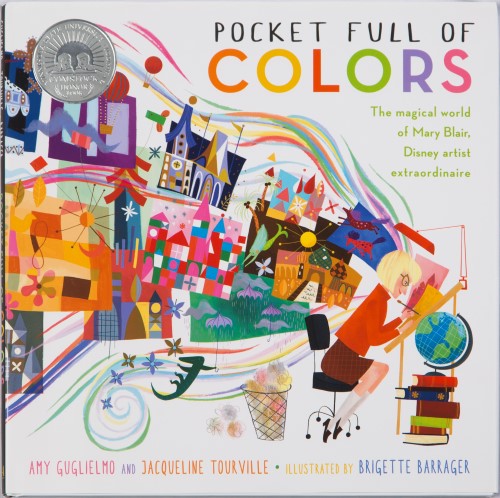
This bright, bold book tells the story of a little-known artist who contributed to one of the most well-known companies in the world. Mary Blair grew up collecting colors like russet, azure, fuchsia, and lime green into her pallet of colors. Eventually Blair looked for a job and was one of the first women to be hired at Walt Disney Studios. She brought vibrant, unusual colors to Disney, even though “the old men” at Disney wanted her to stick to boring black and white. Many of her ideas were considered “just not right,” so finally she left the company. But one person at Walt Disney Studios really missed Mary and her bright colors. That person was Mr. Walt Disney and he had a special project for Mary. Together Mary and Walt created a ride of beautiful colors that traveled around the world. We all know it now as “It’s a Small World”.
Children loved the bright, imaginative illustrations on every page and learning about new colors. Adults and children alike could relate to the Walt Disney Studios and found it inspiring and informative to learn about one of the first women to work there.
Author Amy Guglielmo is a writer, illustrator, and artist. She is the co-author of the Touch the Art children’s series and How to Build a Hug and is also the founder of Via Verde School of Art in New York City. Guglielmo divides her time between the shores of Lake Champlain and Costa Rica. Co-author, Jacqueline Tourville is the author of the children’s picture book, Albie’s First Word. Tourville is very interested in child development and family life, contributing as a blogger and producer for multiple websites. She currently lives in Maine with her family.
Brigette Barrager is an artist, designer, illustrator and author of children’s books living in Los Angeles. She graduated from California Institute of the Arts with a degree in character animation and worked at both Pixar and Walt Disney Animation Studios before freelancing. She is a New York Times best-selling illustrator of children’s books, including Uni the Unicorn. [CASSEY ORRE]
The Youngest Marcher: The Story of Audrey Faye Hendricks, a Young Civil Rights Activist written by Cynthia Levinson and illustrated by Vanessa Brantley Newton (Atheneum Books for Young Readers). 2017
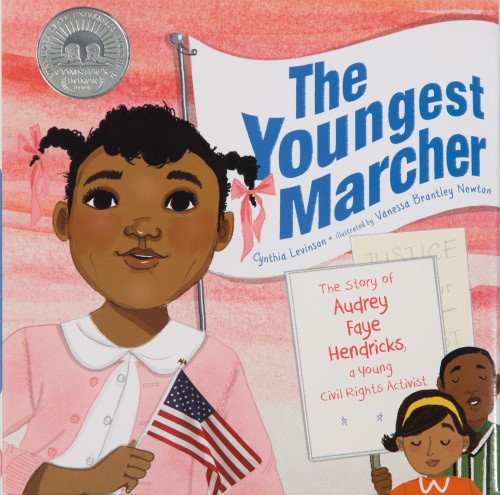
The Youngest Marcher tells the true story of Audrey Faye Hendricks who was arrested at a civil rights protest in 1963. Nine-year-old Audrey knew the rules of segregation for blacks in Birmingham, Alabama—hand-me-down schoolbooks, using freight elevators, and sitting in the back of the bus to name a few. When the idea to let the children march and protest was announced in church, Audrey immediately decided she wanted to participate. She was going to break the law and go to jail to help make things right for her people because she wanted the same rights as all Americans. Newton’s bright, digital collages highlight the details of the experience showing Audrey first being arrested during the protest and then sleeping in a stark jail cell with only a bare, dirty mattress for a bed.
Students ages eight to twelve showed intent attention and asked many questions while listening to the story. They felt that Audrey was very brave and were shocked that she went to jail. The story allowed teachers to discuss segregation in the 1960’s and to help students realize that even 9-year-olds can make a difference.
When author Cynthia Levinson met Audrey Faye Hendricks 45 years after she went to jail, she knew she would write a book about her for young readers. The book became a reality after three years of interviewing marchers and researching the events. Levinson has written other books on social justice including Watch Out for Flying Kids!: How Two Circuses, Two Countries, and Nine Kids Confront Conflict and Build Community and We've Got a Job: The 1963 Birmingham Children's March. Illustrator Newton is a self-taught artist who used brightly colored digital collages to captivate the reader in this book. She has illustrated many books including We Shall Overcome: The Story of a Song and The Hula Hoopin' Queen. [KATHY VANDERVORST]
Her Right Foot written by Dave Eggers and illustrated by Shawn Harris (Chronicle Books). 2017
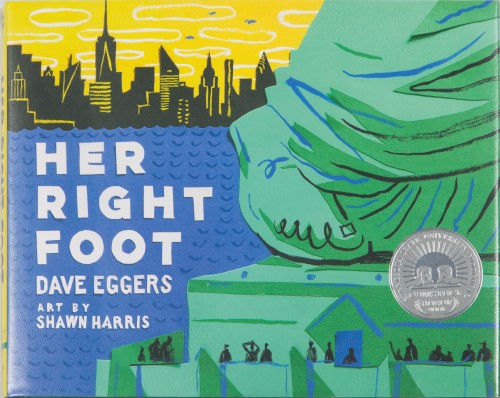
In an unconventional, chatty style, author Dave Eggers tells the history of the Statue of Liberty from its design, to construction in Paris, to its final assembly on Bedloe’s Island, now called Liberty Island. This nonfiction picture book includes many engaging details, including the fact that Her Right Foot appears to be moving. “After all, the Statue of Liberty is an immigrant, too. And this is why she’s moving. This is why she’s striding” (Eggers).
Shawn Harris’ full color illustrations in construction paper, India ink and collage bring the text to life with vignettes and full-page and double-page spreads. The back matter includes photos, a list of sources, and suggestions for further reading.
This well-designed book was especially popular with nine to ten-year-olds. During the read aloud, they paid intent attention, asked questions and made comments, and even clapped at the end of the reading. They learned many new facts, said the pictures were “really cool,” and even mimicked how the Statue stands. Teachers commented: “This is a book that was looked at often and students saw new items each time. Students loved the story and found it to be a great message for today’s world. I would read this every year.”
Author Dave Eggers grew up in the Chicago area and is the owner of McSweeney’s, an independent publishing house. He now lives in the San Francisco Bay area. This is illustrator Shawn Harris’ first book. He lives in Morongo Valley, California. (CAROL HANSON SIBLEY)
Rules of the House written by Mac Barnett and illustrated by Matt Myers (Disney-Hyperion). 2016

Are you a rule follower? Or do you think it’s more fun to break the rules? This book is about two siblings who are at opposite ends of the spectrum when it comes to following the rules. Ian always follows the rules, while his older sister Jenny doesn’t think rules are important that is until their family goes on vacation to a cabin in the woods. Both Ian and Jenny learn some new things about following and breaking rules, as well as a thing or two about appreciating and standing up for each other.
This book was read to preschoolers through fourth graders. Children of all ages loved this book, they commented on the pictures and the story, and many groups asked to hear it again. One reader commented on the emotions that her listeners expressed. They enjoyed the suspense they felt when Jenny opened the forbidden door, and felt sympathy for her even though she didn’t follow the rules. Several readers commented on the discussions of “rules” that ensued after reading the book to children, and they appreciated that the lesson was presented in a very engaging way.
Mac Barnett has written several children’s books, including two Caldecott Honor books, Sam & Dave Dig a Hole and Extra Yarn. He won the 2015 Comstock Read Aloud Book Award for his book, Sam & Dave Dig a Hole. His books have also received the Boston Globe-Horn Book Award, the E.B. White Read-Aloud Award, and two of his books were named among the Ten Best Illustrated Books of 2015 by the New York Times. Mac proclaims that his job is “lying to children,” but he does so in a way that moves readers to the place where lies and truth intersect in “wonder.” That place “where a story, no matter how strange, has some semblance of the truth, and then you’re able to believe it…” Barnett lives in Oakland, California. (ERIKA JOHNSON)
Seven and a Half Tons of Steel written by Janet Nolan and illustrated by Thomas Gonzales (Peachtree Publishers). 2016

Following the tragic events of September 11th, 2001, pieces of steel wreckage from the World Trade Towers in New York City were sent to various organizations across the country including the US Navy. Workers used the steel beam they received to create a remarkable memorial in the bow of the USS New York. This story is a gentle reminder of the terrible events of that day and helps teach us that something special can be built out of an unimaginable tragedy.
Children responded with many comments such as: “Best book ever,” “It’s sad someone would try to destroy a country,” and “I liked that I learned something new.” Readers shared that the children leaned in or moved closer to see the beautiful pictures and had many questions while the book was being read. Despite the sad nature of the topic, children were very interested in talking about and learning more about the events related to 9/11.
A lifelong lover of books and seeker of good stories, Janet Nolan believes a good story is a gift that keeps on giving. She is the author of both fiction and nonfiction picture books for children. Nolan lives with her husband and their dog outside of Chicago.
Born in Cuba, illustrator Thomas Gonzalez now resides in Georgia. As an artist and painter, Gonzalez not only illustrates children’s books, but also directs the marketing campaigns of several national companies. The book’s beautiful illustrations were created in pastel colored pencil and watercolor. (MARILYN LABRENSZ AND LISA STAIGER)
Jars of Hope: How One Woman Helped Save 2,500 Children During the Holocaust written by Jennifer Roy and illustrated by Meg Owenson (Capstone). 2015
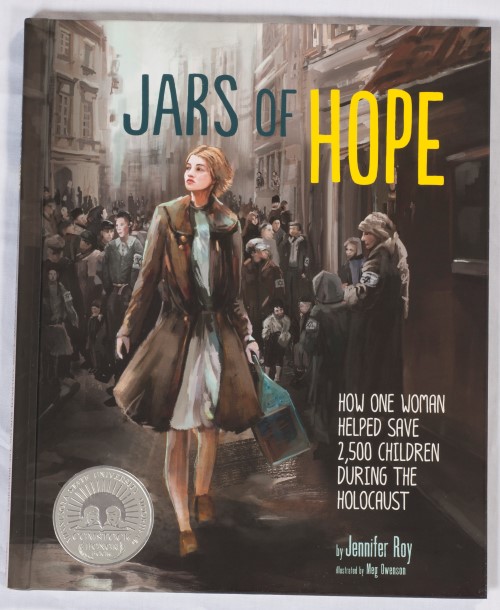
When people discuss the Holocaust, they typically focus on the horrific acts committed during the war. They occasionally forget the heroic acts committed by everyday people during this troubled time. Irena Sendler was only a child when she discovered the terrible ways Jewish people, especially children, were treated in Poland. Later, Irena became a social worker in the Warsaw Ghetto to help the Jewish people in their time of need. She realized that if the children were to survive they would need to be relocated to foster families outside the Ghetto. Irena and her friends took many risks to help these Jewish children escape, but they were eventually caught and sent to prison. Irena kept a record of each child’s name and their family so they could be reunited after the war. Irena and her friends buried the children’s names in jars of hope for safe keeping.
This true story captivated readers ages nine and up with its painted illustrations and the courageous acts performed during the Holocaust. One teacher commented that “Roy took a difficult topic and presented it in a way students could relate to.” Many children asked questions about World War II and wanted to know more about it after the book was read. Students did not want the story to end and asked for it to be read over again and again. Lastly, they noted the themes of courage and self-sacrifice in the book.
Jennifer Roy is an established children’s writer who focuses on tough subjects such as living with a disability or the Holocaust. She currently resides in Saratoga Springs, New York, with her family. Meg Owenson is a skilled Illustrator and concept artist who lives in Scarborough, UK. She has worked with a variety of mediums ranging from video games to clothing. (SADIE HERMAN)
Tucky Jo and Little Heart written and illustrated by Patricia Polacco (Simon & Schuster), 2015
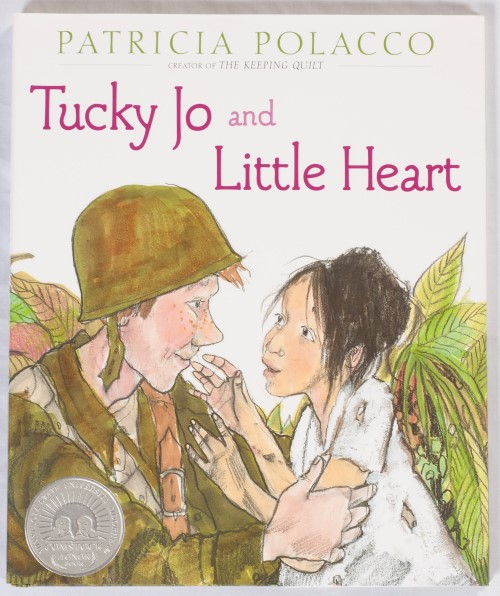
Kentucky Jon is a young American soldier who ends up in a thick jungle in the Philippines during World War II. He meets a young village girl who calls him Tucky Jo. She has a heart-shaped birthmark on her arm, so he calls her Little Heart. The two form a special friendship and spend time together nearly every day. Tucky Jo earns the trust of Little Heart’s family and the other villagers by being kind to Little Heart and by bringing food and treats for everyone. The villagers also provide something to Tucky Jo. He is away from his family and misses them terribly. Little Heart and her people make him feel like he is at home, surrounded by his “kinfolk.” One day, the enemy moves into their jungle. Tucky Jo gets permission from his sergeant to save Little Heart and the people in her village. As the villagers are taken to safety in a truck, Little Heart and Tucky Jo are saddened at losing their friendship. Will they ever see each other again?
As a professional artist, Patricia Polacco illustrates each of her books using vivid colors and emotion-filled images that help portray the depth of her stories. Both children and adults appreciated the illustrations and commented on the wonderful addition of emotion and realistic scenery to help the reader understand this story.
The book appealed to fourth and fifth-grade classes. Students listened intently, asking questions about some of the language and commenting on the emotional story with both happy and sad parts. They appreciated that this story is based on a real person and events that actually happened.
Patricia Polacco has written and illustrated nearly 60 children’s books including Fiona’s Lace, The Blessing Cup, and The Keeping Quilt. In 2012, she was awarded the Regina Medal for distinguished contributions to children’s literature. Polacco lives in Union City, Michigan. (ERIKA FISCHER)
Gifts from the Enemy written by Trudy Ludwig and illustrated by Craig Orback (White Cloud Press). 2014
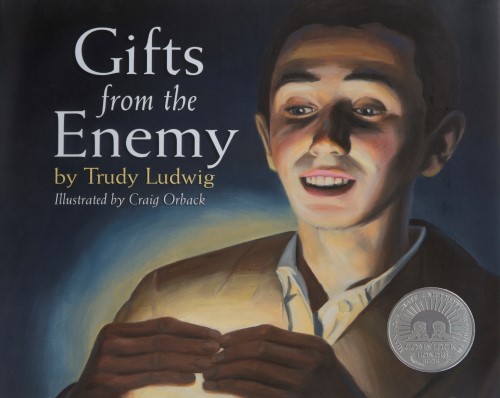
Gifts from the Enemy is a true story about a young man’s experience while imprisoned in a labor camp in Germany during the Holocaust. Alter Wiener learns at an early age that kindness can come in surprising ways and that hope can be found in something as simple as a cheese sandwich. This story sheds light on a beautiful act of kindness from one person to another despite the circumstances and the risk during a very dark time in history. The illustrations are simplistically detailed and luminous, supporting the text throughout the story.
Students responded enthusiastically to the book. Some said they learned that “Not all people are bad just because they are part of a bad group.” Students were engaged throughout the story and were interested in doing more research so they could learn more about World War II and the Holocaust. After reading the book to her class, one teacher commented that the students, “Really felt strongly about the book and stated that it reminded the children of their freedom.” Supplemental questions and activities for young readers are supplied to aide teachers and parents in the discussion of the history and background of this book.
Author Trudy Ludwig resides in Portland, Oregon with her family. Her books have won numerous awards including the Mom’s Choice Gold Awards, the CCBC Best of the Year award, and School Library Journal Best Picture Book for 2013. Illustrator Craig Orback has illustrated over 20 children’s books and lives near Seattle where he teaches children’s book illustration classes. (ANNA WILSON)
Rags: Hero Dog of WWI: A True Story written by Margot Theis Raven and illustrated by Petra Brown (Sleeping Bear Press). 2014
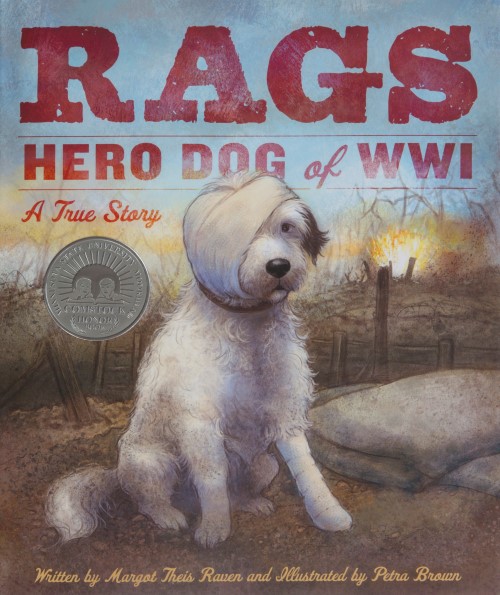
Rags, a stray dog, is rescued in Paris during WWI by Army Private James Donovan. When Donovan is sent to the battlefield, Rags goes along and helps the soldiers by chasing mice and rats out of the trenches, warning of incoming shells, delivering messages, and boosting the soldiers' morale. During a battle, Private Donovan and Rags are both wounded. Severely injured, Donovan is sent back to the United States and Rags refuses to leave his side and so returns to the U.S. with him.
Both students and teachers felt that this was a heartwarming story. Several comments were made about the story being sad, but one student replied it was a “good kind of sad.” Students liked that it was a true story which described a unique part of history during WWI. One group summed it up by stating, “We want to meet Rags.”
Background information on War Dogs of WWI and an epilogue that describes how Rags spent his final years are included.
Margot Theis Raven was born in Indianapolis, IN on August 30, 1950 and died in Mt. Pleasant, SC on August 16, 2014. Raven was an accomplished fine art painter and a national award winning author. Rags: Hero Dog of WWI was her last book and was released just weeks before her death. Petra Brown, the illustrator, lives in North Wales, UK and has been a children’s book illustrator since 2006. (PEGI ECKER)
The Bambino and Me written by Zachary Hyman and illustrated by Zachary Pullen and published by Tundra Books, 2014.

The Bambino and Me is the story of 10-year-old George Henry Alexander in the summer of 1927. There were no computers, television or video games in those days so George spent his time playing baseball. George was not good at baseball. He was always picked last for teams and Nick the Noodle called him "an easy out." But George loved the game so much he couldn't give it up.
Baseball was called the "National Pastime" and everyone had their favorite team. George loved the New York Yankees and his favorite player was the great Bambino - Babe Ruth. His prized possession was his Babe Ruth baseball card and his dream was to see Babe play.
George’s dream came true on his birthday when his parents gave him tickets to the game against the Yankees' biggest rival, the Boston Red Sox. His dream was quickly shattered when he opened a birthday gift from his uncle - a Red Sox jersey and cap. George didn't want to wear the jersey to the game but his parents insisted. He knew he was asking for trouble sitting with the Yankee fans in the enemy's uniform. But after the Yankees won the game, wearing that jersey brought him the biggest surprise of his life.
Students grades 1 through 5 enjoyed the book. They laughed at the pictures, especially when George defied his mother and got his mouth washed out with soap. And children laughed at some of the phrases in the book such as, "I'd rather kiss a girl." Both boys and girls liked the story and they especially liked the theme of never giving up.
Zachary Hyman has written several sports books for children that convey the idea that children who believe in themselves can accomplish anything they set their minds to. Hyman is currently studying at the University of Michigan on a hockey scholarship. Zachary Pullen’s picture-book illustrations have won awards and garnered starred reviews. His character-orientated books are popular with children and they are especially drawn to the detail in people's expressions. Pullen lives in Wyoming with his wife and son. This is the second book collaboration for Hyman and Pullen. Their first book creation was Hockey Hero. (BARB HOPPE)
Becoming Babe Ruth written and illustrated by Matt Tavares (Candlewick). 2013

Tomato-stealer, inmate, rule-breaker—not necessarily words that immediately come to mind when we think of Babe Ruth. Indeed, Babe Ruth's meteoric rise in baseball came from humble beginnings. In the first part of the 20th century, Babe was indeed a troublemaker and his parents were at their wits' ends. Although not truly an orphan, Babe found himself in a children's home with little to look forward too. Nevertheless, it was at Saint Mary's, this children's home, where Babe met Brother Matthias and was introduced to his destiny: baseball.
The watercolor and pencil illustrations combined with the baseball stats sheets had students commenting on how real and engaging the illustrations were – truly adding to the story.
Matt Tavares has a true gift for humanizing our heroes making us love them even more. As he did in There Goes Ted Williams, Tavares shares some less then savory truths about Babe Ruth. Children ages eight through twelve were fascinated to learn pieces of information about Babe that they had not been exposed to before. Children immediately concluded that a rough start does not necessarily mean a bad end and that one person (Brother Matthias) can make a difference in a young person's life.
From Boston, Matt Tavares is the author and illustrator of several books and illustrator only of several more. Tavares' books frequently earn starred reviews in various publications including School Library Journal, Booklist, and The Horn Book. His books have also garnered numerous awards including the Oppenheim Gold Seal, the Orbis Pictus Award, and the Parents' Choice Gold Award. HEATHER MANEIRO
Jasper's Story: Saving Moon Bears written by Jill Robinson and Marc Bekoff and illustrated by Gijsbert van Frankenhuyzen and published by Sleeping Bear Press, 2013.
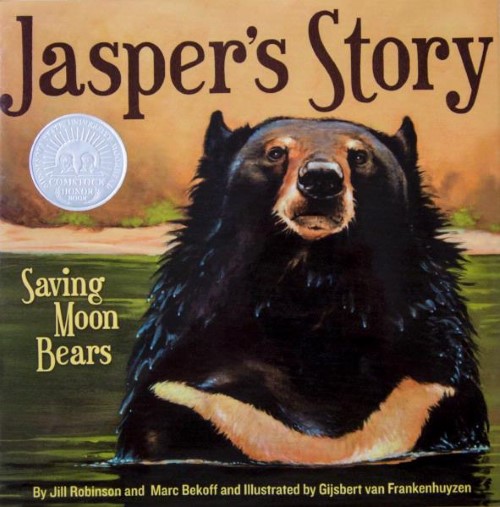
Moon bears are named for the crescent-shaped cream-colored marks on their chests. This emotionally-charged true story describes the rescue of these moon bears after long periods of confinement. Moon bears are taken from the wild and caged in farms so their bile can be extracted and used in traditional Asian medicines. Jasper is a moon bear that had been confined for 15 years in a small metal cage and subjected to this cruel practice. Jasper is rescued from captivity and cared for by the Animals Asia Rescue Group. He is returned to full health and begins his new life in the Moon Bear Rescue Centre in Chengdu, China.
In the sanctuary, Jasper befriends each new bear as it arrives and he serves as a guide and mentor. Everyone who reads Jasper's Story will be touched by the lessons of healing, forgiveness, kindness, and love. One class of fourth graders responded to this story by each writing individual statements of support for the book.
Co-authors, Jill Robinson and Marc Bekoff, have drawn attention to the plight of the moon bears in China by creating this provocative and heart-warming story. The acrylic illustrations rendered by Gijsbert van Frankenhuyzen capture the beauty and strength of the moon bears. The close-up images of Jasper and the other bears thoughtfully convey their agony and then their serenity as they adjust to life in the sanctuary. PAM WERRE
Jack and the Baked Beanstalk written and illustrated by Colin Stimpson (Templar, an imprint of Candlewick). 2012
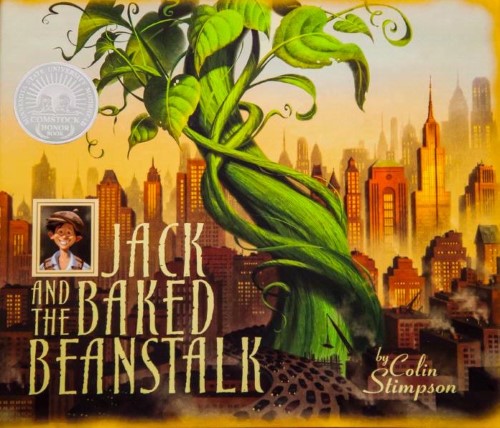
Illustrated in an Art Deco style with soft, romantic, muted dream-like colors, Jack and the Baked Beanstalk is a playful twist on the beloved story we all know about happy-go-lucky, down-on-his-luck, Jack, and his long suffering mother who need magic to stay alive, and yes, to put food on the table. As Jack takes his mother's few remaining coffee beans, a mysterious figure trades the java for Jack's favorite, baked beans. "Now, Jack had read enough fairy tales to know that you don't turn down an offer like that."
Eating baked beans along the way, Jack climbs the stalk to find a near-sighted, money hoarding, food-loving giant at the top. And what does the giant do? Eat Jack and his dog, Bella? No, he does what every foodie would do, and prepares a giant sized feast for Jack and Bella. There's an unexpected twist at the end and all live happily ever after, with plenty of food to last all of them their lifetimes.
Read aloud to children ages nine to elven years old, children liked the new take on an old story and thought it was funny, especially that the giant would cook for Jack. They loved the illustrations and observed the fine use of color and imagery, with muted, yet vivid illustrations. Children liked that everything was on a giant's scale, super-sized. While the illustrations are delightful to view, the language is also poetic, and some children repeated the fee-fi-fo chorus when the reading ended. Children were very engaged in this story and appreciated the unpredictable, yet predictability of the story.
Colin Stimpson, an art director and film designer, lives in England. This is the first book he has both authored and illustrated. KATHY ENGER
Mrs. Harkness and the Panda written by Alicia Potter and illustrated by Melissa Sweet (Knopf, an imprint of Random House Children's Books). 2012
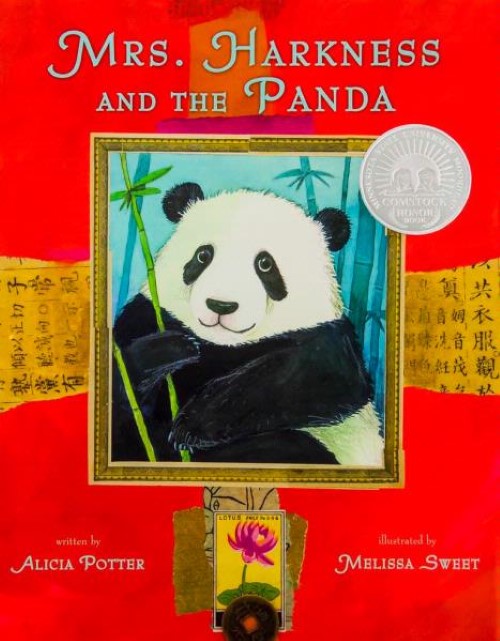
"In 1934, Ruth Harkness had never seen a panda bear. Not many people in the world had." Thus begins the story of Mrs. Harkness, who had not intended to go looking for the beishung. After all, in 1934 women were considered "too dainty for exploring." But after Mr. Harkness passes away in China during his search for the panda, Mrs. Harkness is determined to take on the expedition. Despite the vocal naysayers, Mrs. Harkness packs, prepares, and heads to China. With the help of Quentin and Lao Tsang, a panda is found. Mrs. Harkness names the baby Su Lin and finds him a home in the Brookfield Zoo. The naysayers are quieted and Mrs. Harkness is recognized as a woman explorer.
The watercolor and mixed media illustrations bring a nostalgic feel to Mrs. Harkness's travels. According to Melissa Sweet's web page, much of the paper and collage materials used were obtained while she was in China.
Students from nine to eleven were drawn in by the phenomenal illustrations and the rich language of this story. A passion for research was ignited in some students sending them to the library to look for more information about both pandas and female explorers. The children loved the determination of Mrs. Harkness and commented on how she continued her quest despite the negative feedback from others. A "Chronology of Events," "Author's Note," and "Selected Bibliography" provide further information for readers wanting to know more about Su Lin and Mrs. Harkness.
From Boston, Alicia Potter is a long-time reviewer of children's books. Melissa Sweet, who currently resides in Rockport, Maine, has received a 2009 Caldecott Honor award and the 2012 Sibert Award. HEATHER MANEIRO
Suryia Swims! The True Story of How an Orangutan Learned to Swim written by Bhagavan 'Doc' Antle with Thea Feldman and photographs by Barry Bland (Henry Holt). 2012
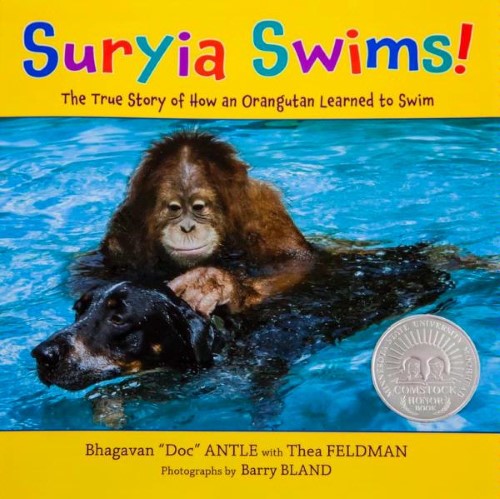
The story begins with endearing photos of a truly unique and loveable creature, Suryia, an orangutan who lives in a wildlife preserve with a whole host of human and animal friends. The colorful book takes readers through Suryia's journey of exploring a love of water, beginning first with a playful bath and ending with days of swimming in the pool with other animals, ranging from Suryia's best friend Roscoe, a dog, to tapirs, tigers, and leopard cubs.
The crisp, clear, and vibrant photographs create a visually pleasing patchwork of vignettes for children to participate and enjoy Suryia's exploration and love of water. The photographs inspire emotions of love, joy, and admiration for this animal and his water-filled journey with diverse and fantastically unique friends.
Children, grades two to four, thoroughly enjoyed this book. They commented on how funny the book was and how wonderful the pictures were. The story drew children and readers alike into the story of Suryia learning to swim and sharing the water with his friends. Readers commented on how it was a "great non-fiction book" and it was "an amazing story of how an orangutan did things his natural instincts wouldn't normally allow."
Bhagavan "Doc" Antle founded The Institute for Greatly Endangered and Rare Species (T.I.G.E.R.S.) where Suryia and all of the animals in the book, including Roscoe, live together in Myrtle Beach, South Carolina. Thea Feldman is a children's book author in New York. Barry Bland is a world renowned wildlife photographer. HEATHER NESEMEIER
Pirates of the Sea written and illustrated by Brandon Dorman (Greenwillow, an imprint of HarperCollins Publishers). 2011
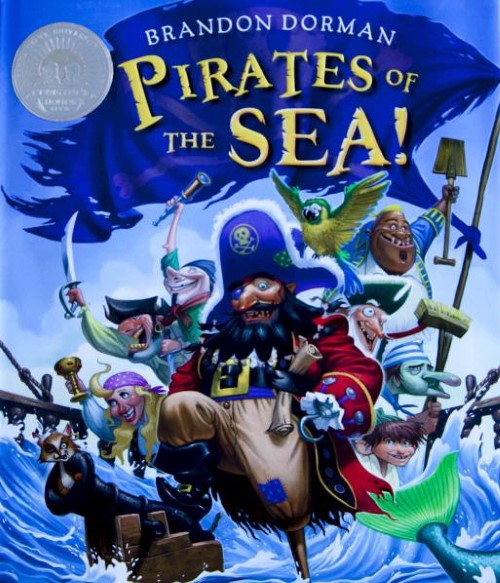
Told in a rhyming "pirate speak" that begs to be read aloud, Pirates of the Sea tells of Cap'n Bones and his crew aboard the Dragonfish of Doom. With a cast of characters and a hilarious pirate code, these pirates go in search of treasure that guarantees to make them rich once again. They run into a few obstacles along the way, with sharks chomping on Burpin' Bart's bottom, a sea monster that threatens to eat them all, deceptive mermaids and a terrible storm, but they eventually obtain their treasure, vowing to stay pirates of the sea forever more. The illustrations, created using Adobe Illustrator, are saturated in blues and browns, bringing emphasis to the sea and the ship, and feature many creative pirates that will keep children laughing.
Students and readers alike loved the use of "pirate speak" in this story. The children thought the phrases were hilarious, and readers noted that they made the read aloud easy and enjoyable. The vocabulary engaged children and got them excited about the book, bringing children to their feet and causing some to act like pirates for the rest of the day. Students fixated on the pictures, trying to locate the characters mentioned in the text and pointing out things they observed. One child commented, "If it was one out of ten, I would choose eleven!"
Brandon Dorman lives in Puyallup, Washington. BRITTANY LAZUR
My Brother Charlie written by Holly Robinson Peete and Ryan Elizabeth Peete with Denene Millner and illustrated by Shane W. Evans (Scholastic Press). 2010
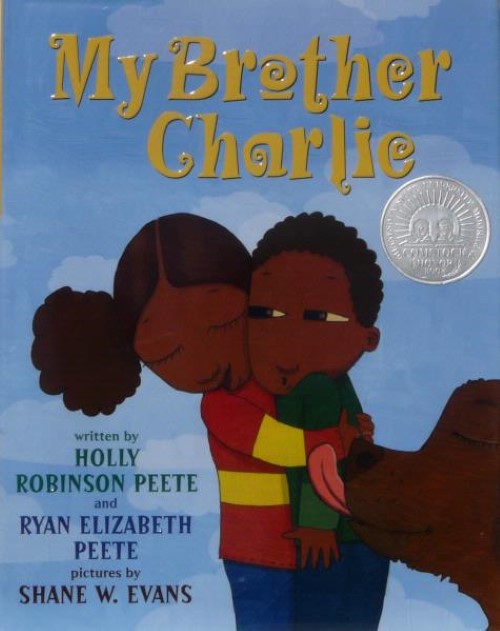
Told through the voice of a young girl who has a brother with autism, this touching book tells the story of a love between siblings, even when one child cannot always communicate that love. Charlie and Callie are twins, but that doesn’t mean that they are similar. Charlie has always been a bit different, and that’s because he has autism. His autism often makes it hard for Charlie to communicate with people and interact with kids his own age. It can be tough being Charlie’s sister, but there are good things too. Even when he can’t find the words, Charlie manages to tell his sister how much he loves her in ways that only he can. Evans’ mixed media art in vivid colors focuses on characters with large, Japanese manga-stylized eyes that bring the Peetes’ semi-autobiographical story to life.
This story was read aloud to children from ages eight through eleven. It incited a lot of discussion during read aloud sessions. Children paid intent attention throughout and understood the messages of showing love and accepting those with differences. One child commented, “I like that the book told us it’s okay to have autism.” Other children stated that they could understand how an autistic child thinks after reading this book. Discussions from this book brought classrooms together and helped students better relate to others. An authors’ note explains in some detail the authors’ motivation for writing the book and encourages everyone to “find value in the uniqueness of people.”
Actress Holly Robinson Peete is a board member of Autism Speaks and travels internationally to advocate on behalf of autism causes. Her daughter, Ryan Elizabeth Peete, often travels with her to speak about her experiences with her brother, RJ, who has autism. The Peetes live in Beverly Hills, California. Shane W. Evans lives in Kansas City, Missouri. BRITTANY LAZUR
Gunner, Football Hero written and illustrated by James E. Ransome (Holiday House). 2010
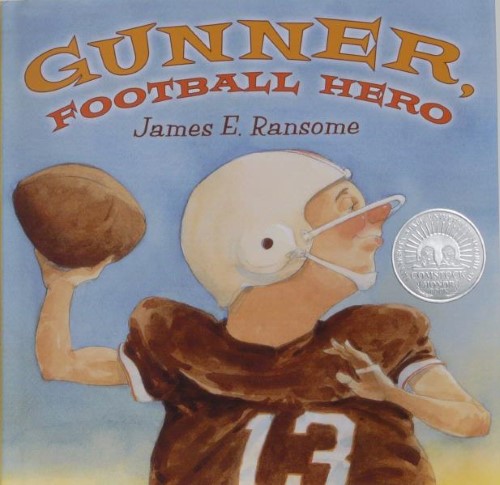
Gunner loves football and wants to be a star quarterback, but he looks different from most players, “too short and too round.” The Pee Wee football coaches are skeptical of his abilities until they see him throw a pass. They immediately sign him up as the third-string quarterback. Gunner faithfully attends all the practices, studies the playbook, and watches college and pro football on weekends. Nevertheless, he spends the season sitting on the bench. In the last game, both the first and second-string quarterbacks are injured, and the coaches send in Gunner. The fans sigh. Much to everyone’s amazement, Gunner throws “a straight-as-an-arrow spiral” and the receiver scores a touchdown, and then he throws another “long bomb” for a second touchdown. When Gunner makes his final throw, he’s not so lucky. It’s intercepted by a small player who jumps high in the air to make the catch. Still Gunner is a hero and receives the rookie of the year trophy. Children enjoyed the surprise twist at the story’s end which revealed that the player who intercepted the pass and won for the opposition was a girl.
Ransome uses watercolor to create numerous double-page spreads. A dramatic vertical page captures the story’s climax of the interception. Children enjoyed the “great illustrations” and especially liked the facial expressions, which depict the characters through cartoon caricatures. One third grade group noted that the “illustrations helped give feeling to the story.”\
This book was enjoyed by children from ages seven through twelve. A fifth grade teacher commented that the story flowed along perfectly and had just the right amount of words per page. A coach who read the book aloud noted that “it was a good book to talk about perseverance.” Children liked how Gunner kept plugging away, not giving up. A mother who read the story aloud to twelve-year-olds liked Gunner’s strong, supportive parents and the message “Be all you can be and stand tall.” The story elicited much discussion. One reader sums it up best: “The author has written the story in a way that the reader becomes Gunner.”
James R. Ransome, who is an Assistant Professor of Art at Syracuse University, lives with his family in New York state.
An activity sheet for this book is available on the publisher's website. CAROL HANSON SIBLEY
The Circus Ship written and illustrated by Chris Van Dusen (Candlewick Press). 2009

Mr. Carrington, the captain of a circus ship, tells the circus boss, Mr. Paine, that he needs to drop anchor and wait out the “fog as thick as stew.” However, Mr. Paine insists that they keep going. When the ship smashes into a ledge, the animals literally fly off. As Captain Carrington saves Mr. Paine, the animals are seen floundering about in the ocean. The next day the animals swim ashore to a Maine island. This double-page spread drenched in bright sunlight hints at a happy ending. Soon the townspeople find the animals everywhere from a “python in the pantry” to an “ostrich in the outhouse.” The people become more worried as the zebra eats Mrs. Dailey’s daisies, and Mr. Hood finds an alligator sleeping on his wood pile. All changes, though, when the tiger bravely jumps into a burning shed to rescue young Emma Rose. Now the townspeople find that “the animals aren’t bothersome; the animals were kind.” They all live happily together until they hear that greedy Mr. Paine wants his circus animals back. When he arrives on the island and looks everywhere, he cannot spot even one of his fifteen circus animals! They are cleverly hidden by the townspeople, and Mr. Paine finally runs off “in a fit of rage.” Now “it was a happy, peaceful place upon that isle in Maine.”
Van Dusen’s gouache, cartoon style illustrations capture the details of this dramatic tale. Light is skillfully used to show the thick blue fog, the roaring glowing fire, and the brightly lit island setting.
This highly entertaining story is one of those rare books that appeals to children across the ages. Children from ages three through ten enjoyed this story. One second grade teacher reported: “What a great experience! This book was fun, colorful and exciting to read and listen to . . . the illustrations were wonderful and the text contained a lot of teaching points.” Children especially enjoyed the hide-and-seek pages in which the animals hide from Mr. Paine. Readers had to pause or turn back to these pages so that children could find all fifteen of the animals. Both readers and older children appreciated the author’s note in which Van Dusen explains how he got the idea for his story from a real circus ship that had a much sadder ending.
Chris Van Dusen lives in Maine with his family.
Willow written by Denise Brennan-Nelson and Rosemarie Brennan, and illustrated by Cyd Moore (Sleeping Bear Press, an imprint of Gale). 2008

Miss Hawthorn teaches art in the strictest, most orderly way possible. She meets her match in Willow, a free-spirited student, who closes her eyes and sees pink trees and blue apples! When Willow paints the pictures she sees in her mind, she is reprimanded by her teacher. No matter how creative Willow’s drawings, paintings, or doodles are, Miss Hawthorn disapproves and even calls Willow a “horrid little girl” for not following the rigid rules of her classroom. Willow’s love for art is not crushed, however, and she even brings her art book to school in order to prove that pink trees and blue apples do exist in the minds of artists. Time passes, and when the students leave for winter vacation, the only present that the lonely Miss Hawthorn receives is from her most troublesome student, Willow. It is Willow’s well-loved art book. This kind gesture inspires Miss Hawthorn to sketch and paint and doodle, in a matter worthy of her imaginative student. When the students return from winter break, they discover that their classroom has transformed into a colorful, imaginative place and that their teacher has finally allowed her creativity to flourish. The story ends with a pleasing transformation—of the art teacher and her classroom.
Cyd Moore’s attention to detail and use of vibrant hues in her watercolor illustrations mirror Willow’s innovative approach to art. The expressions on the characters’ faces help bring the story to life.
Students in grades one through four were especially captivated by this story. They enjoyed the colorful illustrations, the art teacher’s attitude change, and the satisfying ending to the story. The children appreciated that Willow was always unique and “thought her own thoughts” about art.
This is the first book that sisters Denise Brennan-Nelson and Rosemarie Brennan have written together. Denise lives in Howell, MI with her husband Bob and their two daughters. Rosemarie is also a writing teacher and lives in Brighton, MI with her three children.
The illustrator, Cyd Moore, resides in Sylvan Lake, MI. An activity guide for teachers is available on her website. (Katie Hoffbeck)
A Taste of Colored Water written and illustrated by Matt Faulkner (Simon & Schuster Books for Young Readers). 2008

Two best friends and cousins, LuLu and Jelly, confront the reality of the Civil Rights Movement through the eyes of innocence. After hearing about a colored “water bubbler,” LuLu and Jelly have to see and taste this magical water. The pen and ink and watercolor illustrations depict the hopeful curiosity of the cousins as they imagine what the colored water will be. They have just such an opportunity on a trip to the “big city” of Eden with LuLu’s Uncle Jack. When they finally reach the colored water bubbler at Eden’s City Hall, they become witnesses to a Civil Rights march.Jelly is about to taste the water when a policeman with his furious dog scares the children: “That water ain’t for you. It’s for coloreds!” The story ends with the children safely heading home in Uncle Jack’s truck and asking “what color does a person have to be to get a taste of colored water?” The opening and closing endpapers add another dimension to this thought-provoking story.
Appealing to second through sixth graders, this book inspired conversations on what exactly colored water was and why the cousins weren’t allowed to drink it. After reading the book, students liked “expressing what they learned in school,” about the Civil Rights Movement, “in addition to learning new information.” The illustrations pulled the readers in, helping them to pick up clues that something bad was going to happen. The first person point of view also involved the students and kept them attentive.
Matt Faulkner both wrote and illustrated the book. His afterword provides insights into his personal connections to this story: “It’s my wish that we take strength from the courageous ones who came before us and learn to question oppression, racism, segregation . . . and begin to promote compassion to all.” Matt Falkner lives in Oakland, Ca where he teaches illustration at the Art Academy University in San Francisco.(Kelleen O’Brion)
Elizabeth Leads the Way: Elizabeth Cady Stanton and the Right to Vote written by Tanya Lee Stone and illustrated by Rebecca Gibbon (Henry Holt and Company). 2008
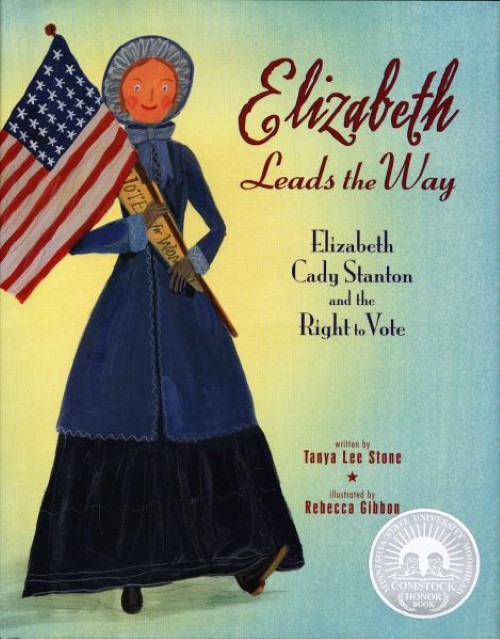
What would you do if you were told you couldn’t do something because you are a girl? “Would you ask why? Would you talk back? Would you fight . . . for your rights? Elizabeth did.” In this slice-of-life biography with delicate, folk-art illustrations, created with gouache and colored pencils, readers quickly learn about the brave woman Elizabeth Cady Stanton. Set in a time in history when only men are allowed to change laws and married women cannot own property, thirteen-year-old Elizabeth decides it is “preposterous!” With determination, Elizabeth sets out to do the things that boys do, including riding horseback, rafting in the river, and even studying Greek and science. Elizabeth’s strong-willed personality continues as an adult and after being married to an abolitionist and having seven children, Elizabeth gathers together with other women to discuss the things they would do if they only had the right. Elizabeth soon discovers that there is one solution to all of their dismays, and that is for women to have the right to vote. “Many said Elizabeth must be stopped. But she was unstoppable. She changed America forever.” An “Author Note” at the end of the book provides more detail about Stanton’s life and includes a list of sources.
With just the right amount of facts, Elizabeth Leads the Way is a wonderful read aloud for third and fourth graders when introducing the women’s rights movement. Many teachers thought this story fit in nicely with their units on elections, providing an appropriate history lesson. Third grade students thought the pictures were very colorful and realistic, representing the clothing and furniture of the “old times.” Students also liked Elizabeth’s character and the way she kept trying to change things, even when she was a young girl. They thought she was very brave for standing up for herself. Third and fourth grade teachers found this story led to a lot of discussion about equal rights, voting, and fairness.
Author Tanya Lee Stone has enjoyed creating stories ever since she was a child. She currently lives in Vermont.
Illustrator Rebecca Gibbon attended the Royal College of Art to study illustration and now resides in South London, England with her husband and two young children. (Ashley Roemer)
Mrs. Marlowe's Mice written by Frank Asch and illustrated by Devin Asch (Kids Can Press). 2007
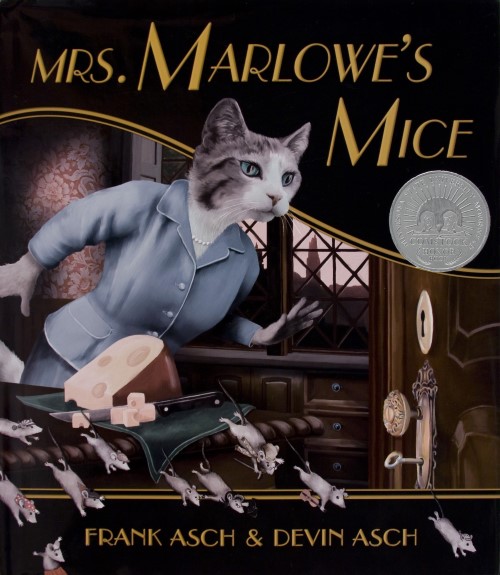
This father-son team, who created Mr. Maxwell’s Mouse, offer yet another suspenseful story of cats and mice. On the surface, this focuses on Mrs. Eleanor Marlowe, a cat who works at Purrington Street Library. When Mrs. Marlowe returns home after a day of work, readers learn that she leads a “secret” life. She provides a safe haven for a large family of mice. Grandpa Paul reminds his family that Mrs. Marlowe gives them a place to live “at great risk to her own welfare.” After a snoopy neighbor complains that she might be harboring mice, Catland Security officers arrive to inspect her apartment. Readers will notice mice hiding everywhere. When young Billy Joe accidentally reveals himself, Mrs. Marlowe acts quickly to save the mouse family.
The sepia-tone illustrations, created in Adobe Photoshop and Corel Painter, are a mix of realism and surrealism. The close-ups and various perspectives add to the story’s suspense. There is a serious message beneath this suspenseful story that will not be lost on those who examine the illustrations closely.
Children from fourth through sixth grade listened to this book with great interest. They appreciated the well developed characters, found the “weird” plot unique and interesting, and liked the surprising twist at the end.
Both Frank and Devin Asch live and work in Vermont and Hawaii, with Devin, also a skilled photographer, adding California to his list of abodes.
Henry's Freedom Box written by Ellen Levine and illustrated by Kadir Nelson (Scholastic Press). 2007

This fictionalized biography is based on the life of Henry “Box” Brown, a Virginia slave, who had himself mailed to Philadelphia to gain freedom. Kadir Nelson used layers of watercolor and oil paint over crosshatched pencil lines to create heartbreaking visuals of Brown’s life. Cutaways of the box personalize Brown’s journey. Readers wondered how Brown could have ever survived twenty-seven hours in such a small, cramped space. Henry finally smiles on March 30, 1849 when the box is pried open and he celebrates his first day of freedom.
Adults found this book to be a great read aloud. The story captivated children in second through sixth grade, who kept moving closer to the book as it was read. It inspired them to ask many questions and led to discussions of slavery and the Underground Railroad.
Author Ellen Levine lives in New York City and Salem, NY, while illustrator Kadir Nelson lives and works in Los Angles, CA.
Christmas in the Trenches written by John McCutcheon and illustrated by Henri Sørensen (Peachtree). 2006
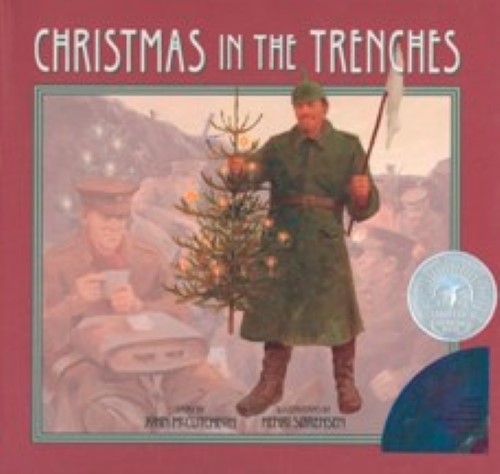
In this story within a story, Grandfather tells his grandchildren about his favorite Christmas when he was a young soldier. He was stationed in the trenches of France during World War I and relates the amazing story of how the German and British soldiers came together on the battlefield to celebrate Christmas Eve. Henri Sørensen’s sepia tone oil paintings bring this moving story to life.
Included with the book is a CD of the story, along with John McCutcheon’s song “Christmas in the Trenches” and “Silent Night” sung in both English and German. An author’s note provides historical details about this unofficial Christmas truce.
Students in grades four through six appreciated this book. A librarian found this to be a terrific read aloud for older students. She said the students really got into the story and questioned why the soldiers would fight each other after celebrating Christmas together. While listening, students moved so they could see the pictures better and made predictions based on the illustrations. Afterwards, they asked why the enemy was so nice. Later in the day a sixth grader suggested giving the book to two returning soldiers that the school was welcoming back from the war in Iraq.
John McCutcheon, author, folksinger, and composer, lives in Charlottesville, VA. McCutcheon, a Wisconsin native, graduated summa cum laude from St. John’s University in MN. Illustrator Henri Sørensen resides in Denmark.
Keeper of Soles written by Teresa Bateman and illustrated by Yayo (Holiday House). 2006

When Death comes for Colin, the best shoemaker in the kingdom, Colin notices Death’s barefeet and offers to make him a good pair of sandals, which he may pick up in four weeks. The cobbler continues to outwit Death by making him a new pair of shoes every time he arrives until one day Death insists that he has come for his soul. Colin replies: “And what do you think I’ve been giving you all these many years. . . I’ve given you sole after sole.” Death accepts the cobbler’s cleverness and allows him to live a long life. Yayo’s expressionistic paintings in acylics set a tone of cheerfulness and humor for this macabre literary tale.
Children, first graders through sixth graders, responded to this story with enthusiasm. They liked the play on words (soul/sole) and thought the pictures were great. They enjoyed looking for the many shoes embedded in the illustrations. A fifth grader commented: “The world needs more books like this one.”
Teresa Bateman, a school librarian and storyteller, lives in Tacoma, WA. Yayo, a native of Colombia, now lives in Quebec. This is his first picture book published in the United States.
Learning to Fly written by Sebastian Meschenmoser. Originally published as Fliegen lernen by Esslinger Verlag J.F. Schreiber in 2005. Translated from German (Kane/Miller). 2006

The narrator finds a penguin who convinces him that the penguin crashed while flying. He could fly until some other birds said “Penguins can’t fly.” The narrator takes him home and tries to help him figure out how to fly again. Together they undergo a training program, study books about flying, and try out what seem like good ideas. These range from taping on bat wings, being shot like an arrow, and trying out Icarus-like feathers. Nothing works. One day they see a penguin colony flying overhead and the penguin “stretched out his wings, pushed off, and joined them in the air.” This is a modern parable with a philosophical lesson: believe in yourself and never stop trying to achieve your dream, even when others tell you they are impossible.
Third and fourth graders enjoyed the story’s humor and liked the theme of never giving up. Students were attracted to the pen and ink sketches with bits of color detail. Children also found the story humorous and especially liked the drawings of the various ways the penguin was outfitted for flying.
This is the first book by author and illustrator Sebastian Meschenmoser, who lives and works in Frankfurt, Germany.
The Patchwork Path: A Quilt Map to Freedom written by Bettye Stroud and illustrated by Erin Susanne Bennett (Candlewick Press). 2005
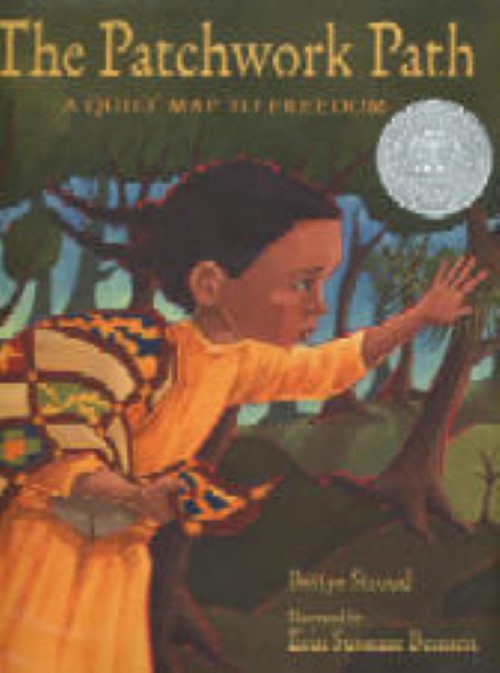
Ten-year-old Hannah, a slave on a Georgia plantation, tells her own story about her mother teaching her to make a special quilt encoded with secret patterns that will help her run to freedom. After her mother dies and her sister is sold to another plantation, Hannah and her father run away. The quilt patterns guide them on their long and dangerous journey to Canada. In an “Afterword,” the author explains that the picture book is based on an oral story from the Ozella family that had been passed down orally from grandmother to mother to daughter.
Expressionistic oil paintings in an earth-tone palette trace the journey. The faces of Hannah and her father are especially expressive with the use of angular lines and geometric shapes. The quilt patterns are carefully integrated into the artwork to explain the stages of the journey.
Fourth through six graders listened to this story and responded reflectively. They liked the illustrations and asked questions about slavery and the Underground Railroad. The story inspired one group of fourth graders to create their own paper quilt to hang in the library media center.
Author Bettye Stroud lives in Athens, GA. Illustrator Erin Susanne Bennett is from Atlanta.
Precious and the Boo Hag written by Patricia C. McKissack and Onawumi Jean Moss, and illustrated by Kyrsten Brooker (Atheneum Books for Young Readers, an imprint of Simon & Schuster Children's Publishing). 2005
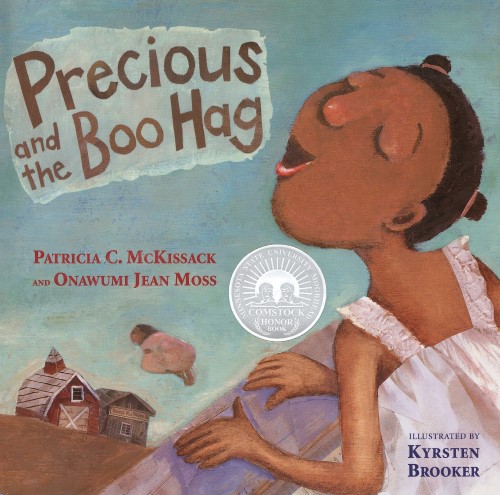
In this literary tale, Mama leaves young Precious at home while the family is out planting corn. Precious, who’s been sick with a stomachache, gets a firm warning from Mama: “Now remember, don’t let nothing and nobodyin this ho use.” Her older brother explains that if she lets somebody in, it might be Pruella the Boo Hag, who tries to trick and scare youngsters into disobeying their mamas. In fact, Pruella shows up in numerous transformations trying to fool Precious into letting her inside. Precious, triumphant and smart, is perfectly safe when Mama and Brother come home.
Brooker’s expressionistic illustrations in collage and oil add to the scary and humorous quality of the text. The realistic wooden frames used on some pages emphasize the need for Precious to stay inside the house in order to outwit the tricky Pruella.
Kindergartners through fourth graders were afraid for Precious and gasped each time they thought she might be tricked by the Boo Hag. They liked the bright colors and the expressive faces of the characters.
Co-author Patricia C. McKissack lives in St. Louis, MO and Onawumi Jean Moss resides in Amherst, MA. Illustrator Krysten Brooker lives in Edmonton, Alberta, Canada.
Sixteen Years in Sixteen Seconds: The Sammy Lee Story written by Paula Yoo and illustrated by Dom Lee (Lee & Low Books). 2005
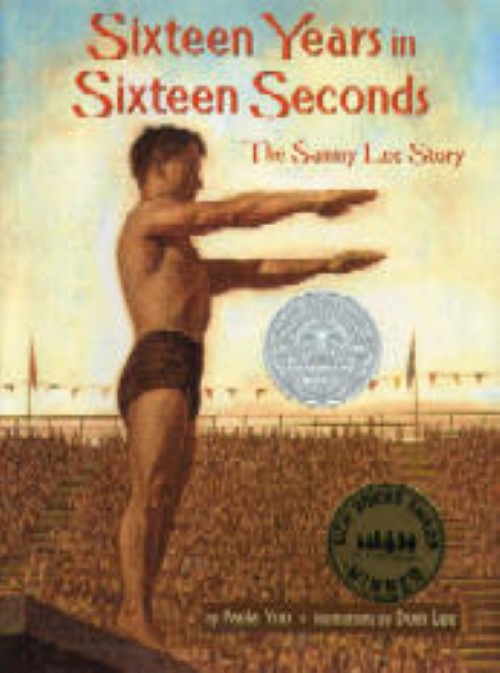
In 1932, Sammy Lee, like other people of color, could only use the public pool on Wednesdays. When Sammy was twelve-years-old, he discovered that he had a natural talent for diving. He not only faced discrimination at the public pool, but also faced pressure from his father who was only interested in his son getting accepted into medical school. Finally, while in college, Sammy struck a deal with his father that as long as his grades were good he could continue his diving.
Sammy Lee became a doctor in 1946, but continued competing in diving competitions. In 1948 at the age of twenty-eight, he qualified to be a member of the U.S. Olympic diving team. He won a bronze medal for his three-meter springboard dive and a gold medal for his ten-meter platform dive. He spent sixteen years of work for this sixteen second dive and became the first Asian American to win an Olympic gold medal.
The scratchboard-style, sepia-toned paintings create a textured effect and help readers understand that this slice-of-life biography is set in the past. The three panels that illustrate Lee’s Olympic dive are particularly dramatic.
Students in grades four through six were thoroughly captivated by Sammy Lee’s story and were indignant about the prejudice he faced. They appreciated the author’s choice of words and the illustrator’s brown-toned paintings. Students “liked how the author described the dive slowly, like you were there.” One fifth grader reported that this was one of the best books he’d ever read. The author’s note explaining that Mr. Lee is still alive and continues to be an active athlete interested the students as well. This is a book that truly helps students understand the impact of discrimination through a very personal story.
This is the first picture book authored by Paula Yoo, who lives in Los Angeles, CA. Illustrator Dom Lee was born in Seoul, Korea and now lives in Demarest, NJ.
Mighty Jackie: The Strike-Out Queen written by Marissa Moss and illustrated by C.F. Payne (Simon & Schuster Books for Young Readers). 2004
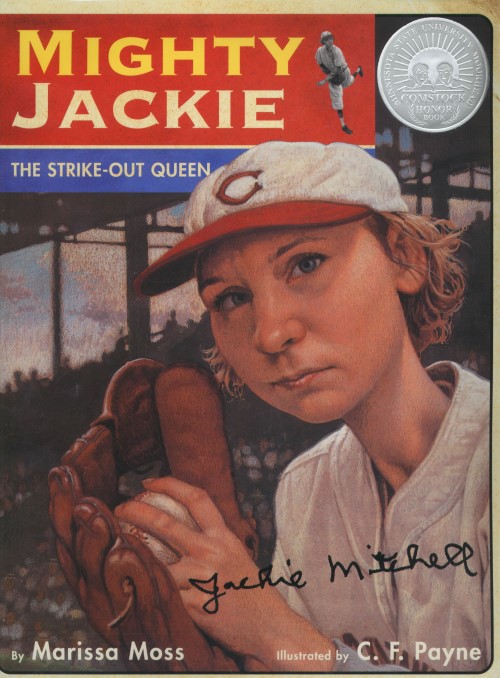
April 2, 1931 was an important day in baseball history. On this day the Chattanooga Lookouts played the New York Yankees in an exhibition game. Thousands packed the stadium to see Lookouts’ pitcher, seventeen-year-old Jackie Mitchell, pitch against the Yankees. Jackie made baseball history because she was the first professional female pitcher. Not only did she pitch against the Yankees, but with her “lefty pitch with a low dip” she also struck out Babe Ruth and Lou Gehrig! This slice-of-life biography explains how Jackie grew up playing ball with her father and how at age eight she learned to pitch from Dazzy Vance, a star pitcher for the Brooklyn Dodgers.
The mixed media colored illustrations show movement and emotion. The full-page close-ups of Babe Ruth capture the intensity in his eyes and the total shock and disgust when the umpire yells “strike three.” Jackie, surrounded by male players, looks undaunted and determined.
Just the cover of the book alone excited eight to twelve year olds. Children listened intently to the story and talked about the book with excitement. They thought it was great to have a female pitcher and yelled “strike three” when Jackie struck out Babe Ruth.
Author Marissa Moss is from Berkeley, CA and illustrator C.F. Payne lives in Cincinnati, OH.
Mr. Maxwell's Mouse written by Frank Asch and illustrated by Devin Asch (Kids Can Press). 2004
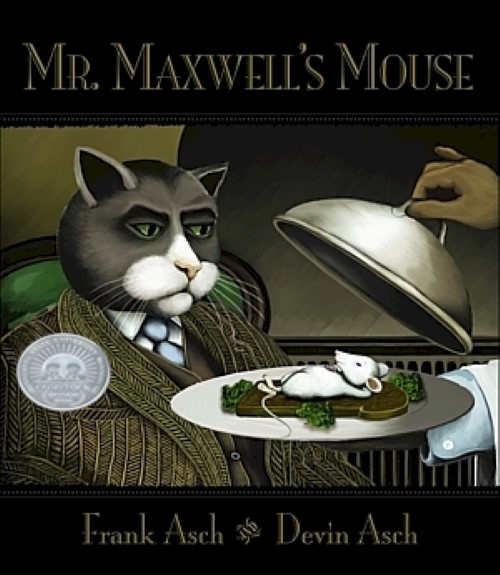
Mr. Maxwell is a sophisticated, debonair Edwardian businesscat, who goes to his favorite restaurant the Paw and Claw to celebrate his promotion to Vice Manager of Efficiency Control. Instead of ordering his usual baked mouse, he orders raw mouse for his entrèe. The Paw and Claw prides itself on polite and plump mice, but the one served to Mr. Maxwell just can’t keep quiet. Would Mr. Maxwell like to add a little salt? Would he like to say a prayer before eating? Would he like a fine glass of wine? The mouse, of course, is a smart little trickster who carefully plans a way to escape his fate.
Devin Asch, son of the author, illustrates this macabre, dark comedy with artwork created in Adobe Photoshop and Corel Painter. The glossy illustrations alternate between detailed scenes of the restaurant and close-ups of Mr. Maxwell and the mouse. The facial expressions and body language add to the tongue-and-cheek quality of the text. White text against black panels fit the sophisticated tone of the story.
Children found the illustrations to be “elegant” and “distinguished” and appreciated the details, such as the cats’ clothing. While sixth graders said that the story might be scary for young children, they found it to be entertaining and funny. A ten-year-old girl laughed at the idea of an animal talking to its food and “beamed from ear to ear” as the book was read. A nine-year-old burst boy out laughing when the mouse maneuvered Mr. Maxwell’s tail on to his plate. He also compared the story to “Tom and Jerry” cartoons.
Frank and Devin Asch are a father-son team. Frank Asch lives in Middletown Spring, VT and his son Devin is from Los Angeles.
A History of Me written by Adrea Theodore and illustrated by Erin K. Robinson (Neal Porter Books). 2022

A History of Me tells the story of a young girl who is the only brown person in her class and is learning about historical topics like slavery and civil rights. This picture book takes the reader through generations of a family, alternating between the perspective of the young girl and the stories of her ancestors and their past experiences. She expresses her feelings as they learn about slavery, and then transitions to the history of her great-great-grandmother who was a slave. She moves through learning about Civil rights and her great-grandmother, her own racist encounter with a boy from school, and her mother’s experience also being the only brown person in her class. Interspersed between each page’s story is the idea that the author loves school, loves to learn, but faces unique challenges because she is the only one with brown skin in her class. Towards the end, the narrator addresses that her daughter has the same experiences, but she is able to teach her that even though most of what is taught regarding history and racism focuses on the hardships and struggles, but there is also “courage, strength, intelligence, and creativity”. The narrator’s ending message to her daughter is that she should be proud of who she is and her history and that she can choose to be anything she wants to be.
As students listened to this book being read aloud, they showed high levels of interest through their focused body language, pointing out specific aspects they noticed and asking reflective questions as they listened. Some of the comments from students included that they liked the “real life” aspect and the mother-daughter connections and sharing about the past. They felt the connection of the mother sharing her experiences with the daughter and allowing her to be herself was powerful. Many students related to this book and the experience of being the only brown student at some time or another and many students found the content and message important. Comments also emphasized how strongly the illustrations supported the story and added to the message.
Author Adrea Theodore is a children’s book author, mother and pediatrician currently residing in Durham, North Carolina. She grew up loving reading, writing, and language, and was inspired to write this story when she realized the experiences her daughter had in elementary school learning about slavery and civil rights were the same as the ones she herself experienced. A History of Me is Adrea’s debut picture book. [JEN HESS]
Hello, Opportunity: The Story of Our Friend on Mars written by Shaelyn McDaniel and illustrated by Cornelia Li (Page Street Kids). 2022

Hello, Opportunity: The Story of Our Friend on Mars, introduces young readers to the evolution of space exploration. Focusing on the Mars Rover Opportunity, readers learn about how “Oppy” was designed, built, and launched. Updates from the mission show the relationship between their NASA team and this little robot with big drive and personality. Initially launched in 2003, Mars Rover Opportunity supplied data consistently for 15 years, far surpassing the originally anticipated 3 months. Opportunity collected images, weather reports, and mineral samples.
Students enjoyed learning about the development of the human interest in space, and the science that took us from “we want to go there” to “so we did!” There was particular interest in the materials used to build the rover, and how a robot could process and “think” of responses. Readers reported an empathetic response to Opportunity’s fate in June of 2018, and exhibited further curiosity about space exploration after the book was read.
This is author Shaelyn McDaniel’s debut title. A Florida native living in New York, she drew inspiration from her own misunderstanding about space exploration to help young readers learn more about Mars. Illustrator Cornelia Li is a celebrated freelance Canadian artist. She adds Hello Opportunity to a body of 9 other children’s books, many of which focus on human interactions with space and nature. [MADDISON MELQUIST]
Award Winners
Mr. Fox’s Game of “No!” written by David LaRochelle and illustrated by Mike Wohnoutka (Candlewick Press). 2024

Are you ready for a nearly impossible game that will have your readers rolling in the aisles with laughter? It is pretty simple: Mr. Fox will ask you a series of questions and all you have to do is answer “No”. Sounds easy, right? But with gigantic ice cream sundaes, free vacations and a million billion dollars on the line, Mr. Fox becomes progressively harder to say “No” to. Will you be able to make it all the way to the end without having to start over? The Theodor Seuss Geisel winning pair of David LaRochelle and Mike Wohnoutka deliver on this hilariously interactive read-aloud. Wohnoutka’s accessible comic-style illustrations work in tandem with LaRochelle’s over-the-top scenarios. Bringing each reader into the story, this book provides a unique read-aloud that forces each listener to stay engaged, work against their instincts and think carefully about their answers.
Students ages three through nine were very enthusiastic about this story! All readers noted their students’ facial expressions showed interest and most readers observed their listeners nudging closer to the book, often pointing at something in the book and showing intent attention throughout. Readers also mentioned that spontaneous laughter was common during these reads. One reader commented that, “This book had the students engaged, intrigued, and excited for the next page to come” and that laughter started almost immediately when she began reading. A reader to third graders noted that she and her students both felt that this book would reach every reader, child and adult alike. She also commented that this is very rare, as many times her students feel that books are either too “babyish” for them or written more for adults. From the students themselves we had some of the most enthusiastic responses. According to one student, “This is a really good book. It is hilarious. All grades in elementary school could read this. If I could give this book 100 stars I would. This is the best book ever. Well, except for Dog Man.” Considering the popularity of Dav Pilkey’s much loved graphic novel series, this is a ringing endorsement indeed.
David LaRochelle is an author from White Bear Lake, MN. His books include 100 Mighty Dragons All Named Broccoli, Isle of You, and It’s a Tiger. Mike Wohnoutka is an author-illustrator from Minneapolis, MN. His books include Ups and Downs: A Book of Emotions, Dad’s First Day of School and Hanukkah Bear. Together, LaRochelle and Wohnoutka are the award-winning pair of the See the Cat series, as well as Go and Get With Rex and Moo.
I Am a Tornado written and illustrated by Drew Beckmeyer (Atheneum Books for Young Readers, an imprint of Simon and Schuster). 2023
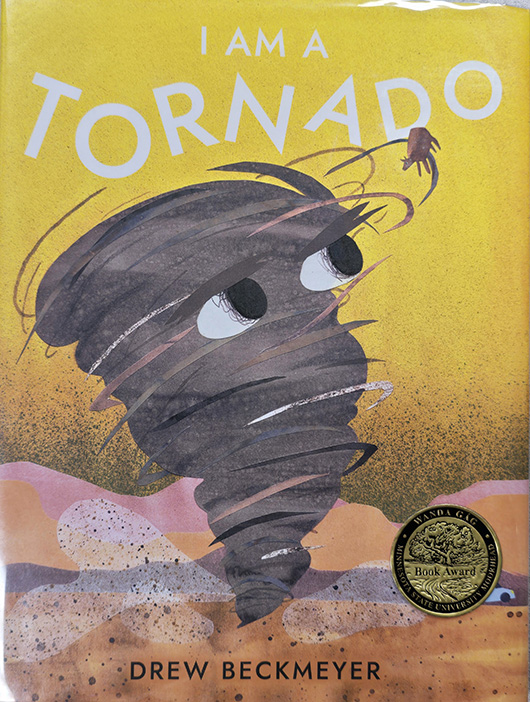
Tornado is more than just fast and big—it's a force to be reckoned with. As it traverses desert landscapes, wreaking havoc on homes, farms, and livestock, something seems amiss. Contrary to its destructive appearance, Tornado insists that everything is okay. When it finds an unexpected companion in Cow it is through their unlikely friendship that Tornado learns to manage its destructive tendencies. Together they weather the storm until it dissipates into the evening air. Drew Beckmeyer skillfully blends scientific insights with themes of social emotional learning, highlighting the power of empathy and companionship in the face of turmoil. Illustrated with earthy tones and intricate cut paper, the story resonates on multiple levels, offering a compelling exploration of emotional regulation and the importance of being heard.
Students ages two through eight showed intense interest in this story and the upper ages of this range also showed a great understanding of the book’s core message. One teacher commented that, “the kids were able to relate to the tornado and feeling angry and wild sometimes.” Another teacher commented that she “loved the message that sometimes when you’re angry you need someone to listen and your voice needs to be heard” and mentioned that that the cow was an excellent example of empathy. Lots of students also weighed in on this one, mentioning that they appreciated the humor of it, especially when Tornado said “I’m gonna toss ‘em”. But several students also mentioned that the ending made them feel a little sad as Tornado blew away, showing that readers really connected with this character and empathized with its situation.
Drew Beckmeyer is an author-illustrator and teacher based out of Los Angeles, CA. His picture books include The First Week of School, The Long Island and Dear Wild Child.
Mina written and illustrated by Matthew Forsythe (Paula Wiseman, an imprint of Simon & Schuster Books for Young Readers). 2022
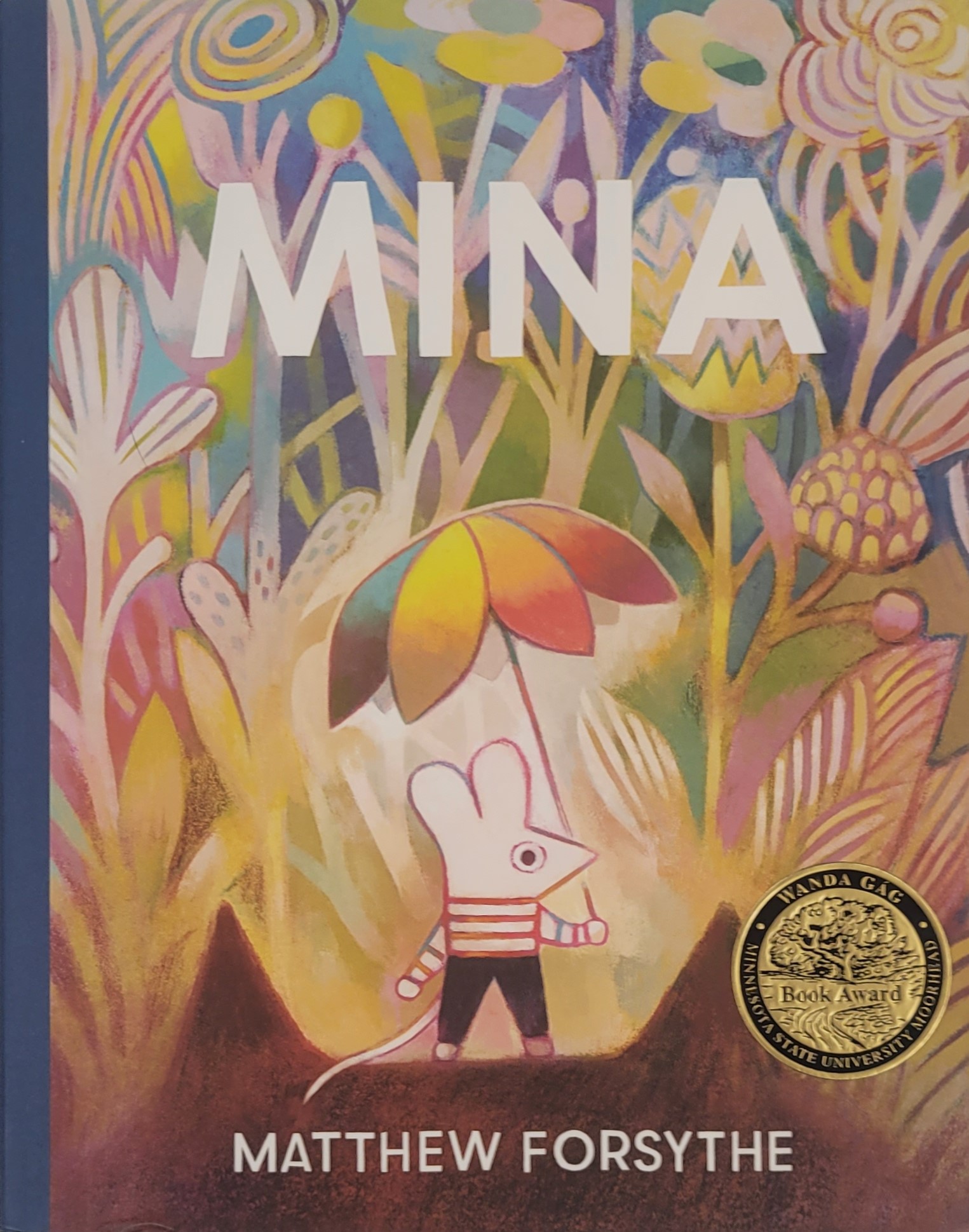
Mina, a young bookworm mouse, lives in a cozy home in a tree with her unpredictable father. He likes to bring home items from the human world to adapt, such as tin cans that become a microphone or telephone, postage stamps to add to his collection of antique art, and even stick insects. However, when he brings home “a squirrel,” Mina starts to worry, and that’s when listeners begin to shout, “That’s not a squirrel; that’s a cat.” All goes well for a while. Father knits the cat a sweater, and he and Mina ride on its back for adventures in the woods. When the cat quits eating, Father decides it’s lonely and brings home two more surprises. However, when they won’t eat either, Father phones the doctor. Without hesitation, the doctor announces: “‘The problem is that these squirrels are definitely cats.’” The chase is on. The three cats pursue Mina, her father, and the doctor who run for their lives. But they are miraculously saved by a stick insect who Mina taught to read. Reading saves them! When the stick insect reads in a loud and deeply charismatic voice, the three cats fall asleep. As one listener declared, “It’s a bedtime story.”
Excellent pacing of the text, dramatic page turns, and oversized illustrations captured the attention of kindergarteners and first graders. The story is predictable from the cover showing Mina standing on the shadow of a cat’s head to the dramatic facial expressions of the cats, especially their eyes, which become more sinister as the story progresses. The illustrations created with watercolor, gouache, and colored pencils provide a soft dreamy world with small details that intrigue children. Listeners were very engaged with this picture book, predicting key moments, shouting out warnings, enjoying the humor, and noticing the joy and importance of reading.
This is the second Wanda Gag Read Aloud Book Award for Matthew Forsythe, who won as the illustrator of Please, Open This Book! in 2016. Forsythe has illustrated several other picture books and has written and illustrated Pokko and the Drum, another animal story. He is also the illustrator of animated films and TV shows. Forsythe, who was born in Canada and raised in London, has traveled the world from Ireland to Korea, where he taught kindergarten. He now makes his home in Montreal, Canada. When he decided that teaching was way too exhausting, he realized that he could create picture books and comics. Mina, which received five starred reviews, addresses one of Forsythe’s themes that parents are not always ideal. [CAROL HANSON SIBLEY]
Mel Fell written and illustrated by Corey Tabor (Balzer + Bray). 2021.

Weighing less than a pound and measuring no more than 18 inches in length, a kingfisher is not the most obvious predator. But when kingfishers are looking for a meal, these small birds dive off of tree branches or telephone wires and plunge into the water for the catch of the day. In Mel Fell, by Caldecott Honoree Corey Tabor, a young kingfisher, Mel, decides that today is the day she is going to fly. Brimming with confidence, Mel jumps, flips, spreads her wings and…falls past a worried family of owls, past a scurrying bunch of squirrels, and past a heroic (but awfully slow) slug. With a splash, Mel enters the water, but all is not lost. With a turn of the book and a kick of her legs, Mel spreads her wings and bursts out of the water, ready to fly home. Simple text and comic illustrations mixed with a couple of well-placed book turns make this story a magical read-aloud experience and younger children will want to read this book again and again.
Children from ages three to nine were fascinated with this simple story. All readers mentioned the excitement that followed “the turn”. Similar to a flip book, Mel Fell starts with the spine on top and page turns happening from bottom to top. Through a clever set of directions to the reader when Mel works her way to the surface, the reader goes up with her. One teacher mentioned that the “children let out a ‘woahhh’ and became even more engaged.” All readers also noted unsolicited positive comments about the story and facial expressions that showed interest, and many said students either started clapping, chanting or laughing at some point in the story. All teachers mentioned the level of engagement and interest that was shown throughout this charming and infectious read aloud.
Corey Tabor is an author and illustrator who grew up in Wyoming and now lives in Seattle, Washington. He is best known for his Geisel Award winning early readers Fox at Night (2022) and Fox the Tiger (2019). Tabor won a 2022 Caldecott Honor for Mel Fell. [LOUIE LAUER]
The Bug Girl: A True Story written by the bug girl herself, Sophia Spencer with Margaret McNamarais, illustrated by Kerascoët, and published by Schwartz & Wade Books, an imprint of Random House Children's Books, 2020.
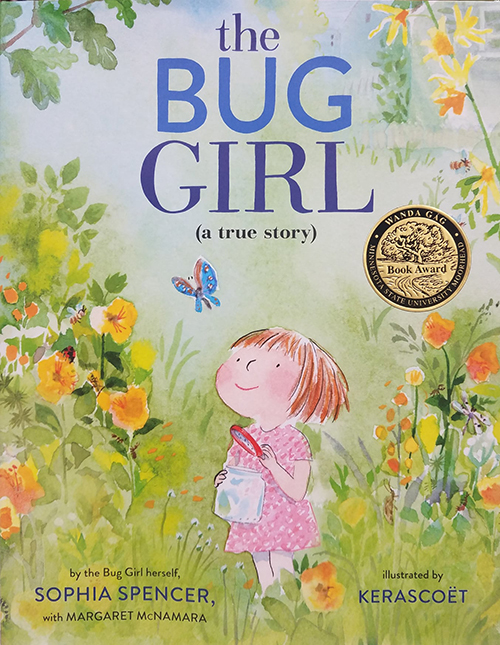
This true story is told by young Sophia who has loved bugs since she was two-and-a-half years old. Sophia’s mother took her to a butterfly conservatory where Sophia made friends with a special blue butterfly. After that she noticed bugs everywhere and wanted to learn all about them. Sophia started a bug club and made a rule that ALL BUGS MUST LIVE even flies and mosquitoes!
In first grade, the other kids didn’t want to hear about bugs anymore. One day, Sophia brought a grasshopper to school thinking the kids would be amazed. Instead, they made fun of her and squashed the grasshopper. That night Sophia went home sad and almost gave up her love of insects. That’s when Mom had an idea and decided to help.
This young author sends a powerful and positive message about being true to yourself. The evocative illustrations match the mood of the story. When read to a group of school-age children there was a collective ‘GASP’ when the grasshopper was squashed.
Sophia Spencer was a fourth grader when she wrote this book. She aspires to be an entomologist and study bugs in their environment when she grows up. Her love for insects has led her to appear on television shows and National Public Radio. Sophia lives with her mother in Canada. Co-writer Margaret McNamara is an award-winning author of picture books for children.
Kerascoet is the pen name for a husband and wife team of French illustrators. They wrote and illustrated the award-winning, I Walk with Vanessa, and they illustrated Malala’s Magic Pencil by Malala Yousafzai, which was highly acclaimed and won the Jane Addams Children’s Book Award for promoting peace, social justice and equality. [JUDY MROSLA]
Circle written by Mac Barnett, illustrated by Jon Klassen (Candlewick Press). 2019

“If you close your eyes, what shape do you see?” Young readers are asked to imagine all possibilities in this final book of Jon Klassen and Mac Barnett’s Shapes Trilogy. As a game of hide-and-seek begins between three friends, Circle reminds Triangle not to hide behind the waterfall. But when Circle opens her eyes, that’s exactly where Triangle has gone. In a story that uses deceptively simple text and illustrations, readers engage in a discussion of complex ideas. What does it mean to be a friend? How do you respond when a friend does something you don’t like? And just because we don’t see or understand something, does it mean that it is bad? Perfect for a lively discussion, this story will have young readers thinking about important concepts, using their imagination, and inspiring repeated readings.
Readers from age four to eight were completely engaged in Circle. Teachers noted several examples of students trying to move closer to the book and laughing spontaneously, as well as showing intent facial expressions. Many teachers mentioned that students either chose to read this story after it was read aloud or requested that they be able to check this out from the library. In a couple of instances, students wanted to talk about the shapes they imagined long after the book was read to them. Teachers also loved how such a simple book could inspire such a complex discussion and spark imagination in their students.
Jon Klassen and Mac Barnett have written six books together, including the two previous books in this trilogy, Triangle and Square, as well as the Caldecott Honor books, Sam and Dave Dig a Hole and Extra Yarn. This is the second time Klassen and Barnett have won the Wanda Gág Read Aloud Book Award. The first was for Sam and Dave Dig a Hole in 2015. (LOUIE LAUER)
Don’t Blink written by Amy Krouse Rosenthal, illustrated by David Roberts (Random House Children’s Books). 2018
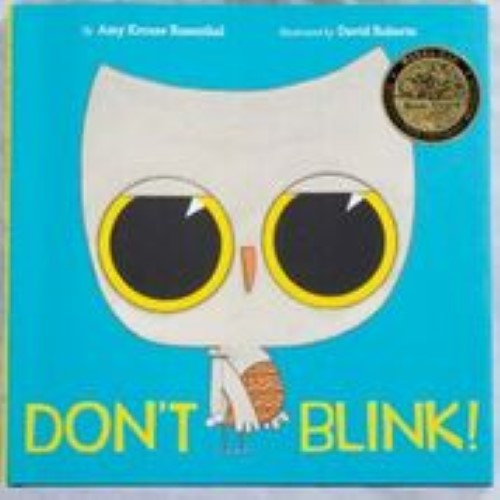
Please don’t blink for the rest of the review, otherwise you have to skip it! Oh did you blink? Please continue to read anyway. Don’t Blink is wonderful, fun, interactive read with a catch. Every time the audience blinks, they have to turn the page and get closer to the end of the book (and to bedtime). Children will want to read this silly book again and again!
Many readers thought that Don’t Blink was a great book whose main character, a friendly owl narrator “stimulates and interacts” with the audience and the story throughout the whole read. Multiple teachers commented they could not expect a “perfectly quiet class” while reading this book. This book encourages chatter, silly antics, and participation and is a perfect read-aloud choice. One teacher noted that this book “should be a strong contender for an award” (and they were right). Students agreed that the book was hilarious and that they tried really hard not to blink. A few students wanted to share this book with their family and siblings to see if they would blink. The audience also appreciated the large bright yellow, black, and white illustrations and pop-out words that are prefect for a group reading.
Amy Krouse Rosenthal was a maker of many things, including children’s books, adult books, short films, essays and so much more. She became a writer after having what she called “a McEpiphany” one day while at McDonalds. Since then she has written 28 delightful children’s books. Amy lived with her family in Chicago and sadly passed away in 2017 due to ovarian cancer. David Roberts was born in Liverpool England and found his calling in 1997 when he illustrated Frankie Stein’s Robot by Roy Apps. Since then he has illustrated over 70 books, including great titles like: Iggy Peck Architect, The Troll, and his very own series Dirty Bertie. [CASSEY SLATER]
Escargot written by Dashka Slater, illustrated by Sydney Hanson (Farrar Strauss Grioux). 2017

Who loves a snail? Do you? After reading the book Escargot, you just might! Escargot, a French snail and the main character, is full of personality and humor. As Escargot leads readers on a journey across the table toward a yummy salad, he asks them to talk about their favorite animals while also encouraging them to try a “hated” food. The clever French snail with a self-loving attitude and subtle humor makes this a book to be enjoyed by all ages – especially when read with a French accent!
Young readers in preschool through third grade enjoyed the opportunity to engage with the text while listening to the story. Reader comments included: “The book was very interactive and asked questions that required a response from the children” and “The children bounced with excitement through the entire story and chattered along as the snail asked questions.” Readers commented that the artwork was phenomenal. Children thought that the realistic art “looked like the snail could just crawl off the page.” Children were also curious and intrigued by the French words sprinkled throughout the text.
Award-winning author and journalist Dashka Slater’s writing spans the range from children’s picture books to teen and adult novels to news magazines. Her writing career officially began at age 10 with publication of her poetry in Cricket magazine. She went on to receive a Creative Writing Fellowship from the National Endowment for the Arts. Writing is a family affair for Dashka as her parents were both authors and she collaborated with her six-year-old son in writing the book, Dangerously Ever After. In Dashka’s words, “I believe you’re never too old or too young to stay up all night reading.”
Minnesota-born illustrator Sydney Hanson’s beautiful artwork reflects her love of animals. Her career includes work as an animator for Nickelodeon and Disney Interactive. Hanson lives in Los Angeles. [LISA STEIGER]
It Came in the Mail written and illustrated by Ben Clanton (Simon & Schuster Books for Young Readers). 2016
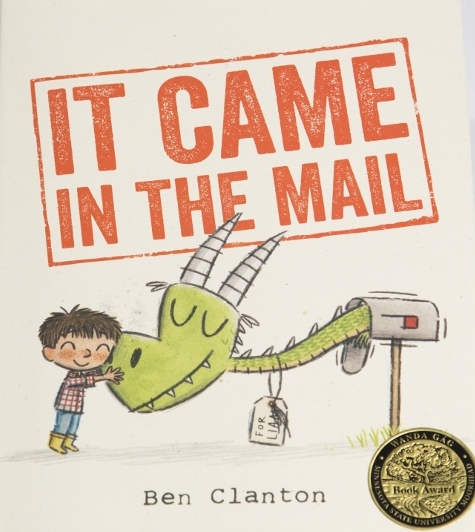
Imagination is a powerful thing, especially when a child’s desire for some mail encourages him to think outside the “mail” box. Young Liam learns that writing a letter can lead to some extraordinary return mail. This humorous story may inspire children to write their own letters as they dream BIG.
Young readers especially enjoyed the humor of this book and interacting with the illustrations and the text. Adults who read this story with children commented that this was a favorite for children to re-read on their own, the ideas in the book really captured the children’s imaginations, and that they were into it from the beginning until the end. One child responded, “Why doesn’t my mailbox send me things like that”?
Ben Clanton is the author and illustrator of numerous popular children’s books. Clanton lives in Seattle Washington with his wife, son, and dog. He is currently working on a new picture book series. Ben Clanton’s bright and imaginative illustrations are rendered in pencil and watercolor and assembled digitally. The illustrations add to the sense of fun and creativity so central to the story. (MARILYN LABRENSZ AND LISA STAIGER)
Please, Open this Book! written by Adam Lehrhaupt, illustrated by Matthew Forsythe (Simon & Schuster Books for Young Readers). 2015

Have you ever felt that the characters of a story were talking directly to you? The book begins with animals on the front cover speaking directly to the reader and asking them to “PLEASE, open this book”. The opening pages are black because, of course, it would be dark inside a closed book. The pages reveal what has happened to the characters because the book was closed. No, actually it was slammed shut! We see an alligator with his leg in a sling, a toucan with a bandaged beak, and a lemur that has been imprisoned for days. The characters plead with readers to not close the book once it has been opened.
While this appears to be a book for younger students, its humor appealed to students from kindergarten through fifth grade. Teachers commented that the kids chuckled and belly laughed through the entire book and that it reminded them of the pigeon books by Mo Wilhems and the book, No, David! by David Shannon. The students were intrigued that the author used the front and back covers to tell the story, as well as to give the solution to the problem. One reader commented that, “This book is over the top unique” while another noted that, “My students experience so much sadness and difficulty in their lives that anything that can make them laugh, even for a few moments, is very positive and this book has done that for them.”
Adam Lehraupt’s first book, Warning, Do Not Open This Book (2013) was selected as an ALA and Huffington Post notable book and was a E.B. White Read Aloud honor book in 2014. Lehraupt has appeared on Broadway, lived on a communal farm, and currently resides in Pennsylvania with his wife and sons. Matthew Forsythe is a comic book artist and children’s book illustrator and designs for animation. He was the lead designer for Adventure Time on the Cartoon Network. My Name is Elizabeth by Annika Dunklee was his first children’s book. It was named a New York Times Notable Children’s Book in 2011. Forsythe makes his home in Montreal, Canada. (CONNIE HOWITSON)
Sam & Dave Dig a Hole written by Mac Barnett, illustrated by Jon Klassen (Candlewick Press). 2014

Have you ever dreamed of finding something spectacular? The story of Sam and Dave begins when they decide to look for buried treasure in their own backyard. The boys begin digging and bring their dog along to help. For a long time, they dig straight down and then decide to dig in a different direction which causes them to just miss the something spectacular. Their next plan is to split up and dig in opposite directions to help increase their chances of finding the treasure. After a long day of digging, Sam and Dave decide to take a rest but their very clever dog decides to keep digging. Soon they are all falling and it is up to the reader to decide whether or not Sam and Dave really have discovered something spectacular.
This book was extremely successful with young children. The students nudged closer to the book, laughed spontaneously, and asked for the story to be read again. While having the book read to them, children could not help but try to tell the characters which direction to dig. One reader stated, “I have never seen or heard so much laughter and smiling faces when reading a book to children.”
Mac Barnett is a bestselling author of over 18 children’s books. Both of his collaborations with Jon Klassen, Sam & Dave Dig a Hole and Extra Yarn, were selected as Caldecott honor books. Barnett lives in Berkeley, CA. Jon Klassen has written and illustrated numerous children’s books. His book, This is Not My Hat, won the Caldecott award and the Kate Greenaway medal. Klassen is from Niagara Falls, Ontario, Canada and now lives in Los Angeles, CA. (ASHLEY LORENTZ AND PAM WERRE)
The Day the Crayons Quit written by Drew Daywalt, illustrated by Oliver Jeffers (Philomel Books, an imprint of Penguin Group). 2013
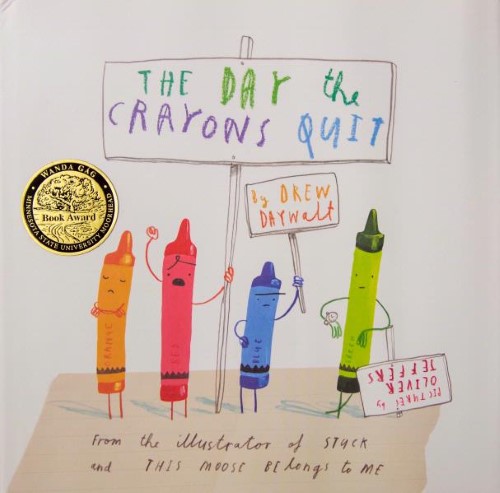
Where does inspiration come from? In an interview with Kidlit411, author Drew Daywalt indicated he was staring at his crayon box one day and started to wonder if his crayons could talk to him what would they say? Thus The Day the Crayons Quit was born. Red is overworked – all of that Holiday work you know. Orange and Yellow are fighting – what color do you think the sun is? Moreover, poor Peach is naked. A humorous presentation about balance and working together is playfully presented in crayon drawings.
Students from five to nine laughed aloud during the reading of this tale. Teacher after teacher remarked that they went ahead and purchased a copy of this book for their classroom. The immediate reaction to this book by students was dismay that it was over followed by conversation about what other crayons might say. Teachers loved the discussion the book generated and the possibilities for discussing point of view and other writing prompts.
The Day the Crayons Quit is Daywalt's first children's book, but children have been enjoying his writing for years on series such as Buzz Lightyear and Timon & Pumbaa. Illustrator Oliver Jeffers has amassed numerous awards including the Nestlé Smarties Book Prize and the Blue Peter Book Award. Jeffers previous books Stuck and This Moose Belongs to Me preceded The Day the Crayons Quit on The New York Times Best Seller list. [HEATHER MANEIRO]
Silly Doggy! written and illustrated by Adam Stower, (Orchard, an imprint of Scholastic). 2012
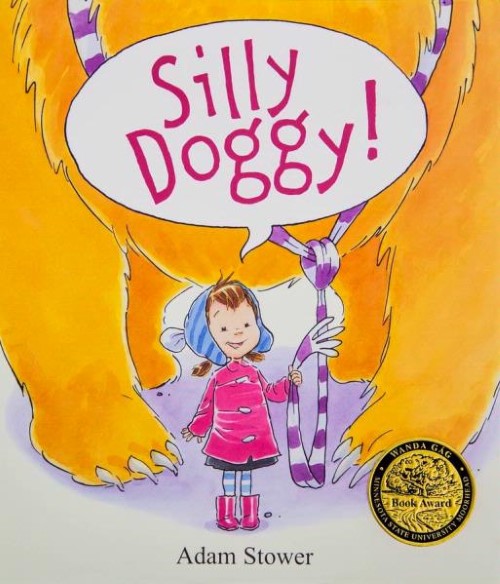
One day Lily looks out the window and sees something big, brown, and hairy: a doggy! But this wasn't just any dog; it's actually a loveable bear from the zoo! Her doggy is so silly: he doesn't eat his dog food; he doesn't do any dog tricks, and he never does what Lily tells him to, but as Lily puts it, "his favorite thing is scratching. My favorite thing is him." When Mom wouldn't let Lily keep Doggy, Lily was forced to create "found" posters, advertising her silly friend. She secretly hoped no one would see it, but unfortunately, a zoo keeper did come to claim Doggy. Luckily for Lily, another zoo friend found its way into her backyard . . . a "kitty"!
Stower's colorful illustrations range from double page spreads with doggy's huge body taking up both pages to vignettes showing the antics between doggy and Lily. The pictures greatly extend the text with facial expressions and body language that make these characters endearing.
This book was a huge success with younger children. They were laughing throughout the story, requesting repeated readings, and wanting to keep the book for their own collections. Readers enjoyed telling the story, pointing out that the language allowed them to use a lot of expression. The illustrations were a hit as well; many commented on the bright color and large pictures, perfect for reading aloud. Students noticed the endpapers as well, which showed newspaper articles about lost zoo animals and Lily and Kitty winning a pet competition. Students were overwhelmingly positive about "Silly Doggy!"
Adam Stower lives and works in Brighton, England. [BRITTANY LAZUR]
Earth to Clunk written by Pam Smallcomb and illustrated by Joe Berger (Dial Books for Young Readers, a division of Penguin Young Readers Group). 2011
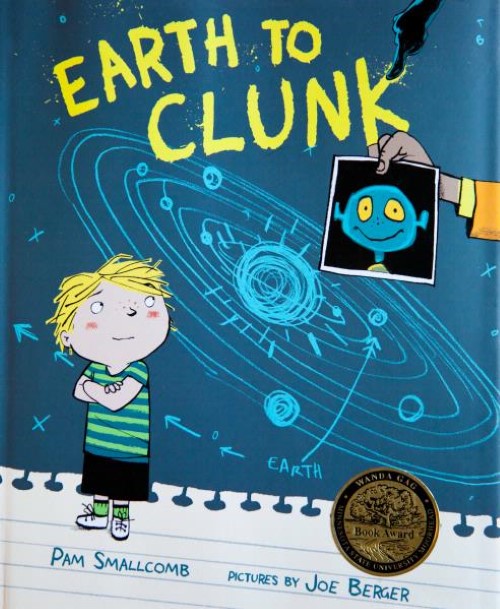
Our narrator has an unwanted pen pal—Clunk, from the planet Quazar. In an attempt to punish Clunk for having a pen pal from Earth, the young boy sends him all of the awful things he can think of: dirty socks, old lasagna, a scary picture, and his big sister. But Clunk has been sending him stuff too: a Zoid, three Forps, and a surprisingly tasty glob. Will the two be able to find friendship? Berger's pen, pencil, and ink illustrations, digitally colored, illuminate the dead-pan humor of Smallcomb's amusing, imaginative story.
Students, ages six to nine, loved this "out of this world" book, some saying that it was their favorite read aloud. Children laughed, had interested facial expressions, bounced with anticipation, pointed to something in the book, repeated phrases, clapped, and chose to look at the book after the reading, wanting more. They liked the mystery behind Clunk and were fascinated by the Zoid, especially loving the page where the Zoid burps. Teachers used the book to make connections to pen pals and concrete poetry, as the text is often purposefully shaped in "stair" formations.
Pam Smallcomb lives in rural Maryland, while Joe Berger resides in Bristol, England. [BRITTANY LAZUR]
Memoirs of a Goldfish written by Devnin Scillian and illustrated by Tim Bowers (Sleeping Bear Press). 2010
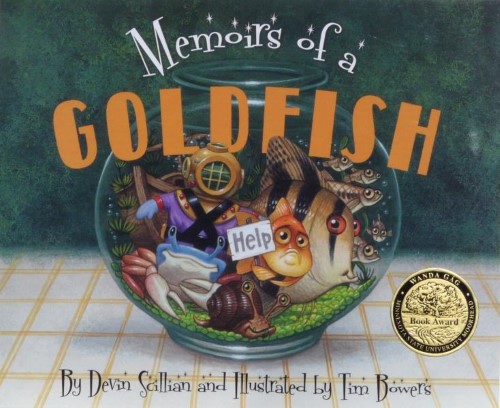
In this daily memoir, a goldfish narrates two-weeks of his life. From the double-page spread of the copyright page when he is dumped into a small fishbowl to day fourteen, readers follow the frustrations and joys of this endearing goldfish. By day three, he’s looking a bit bored until he’s joined by Mr. Bubbles, a little person in a diving suit. Mr. Bubbles doesn’t say anything, and the goldfish finds him quite “creepy.” More and more creatures are added daily until the narrator loses it: “‘This is my bowl. . . . I want my bowl back!’” When he gets his wish, he’s content at first but then starts worrying about what has happened to everyone. Maybe a solitary life is not for him. On day fourteen all of the creatures are reunited in a lovely big fish tank, just the right size for all of them. The narrator is especially happy to notice a new addition to the group, another goldfish named “Gracie,” who is “the color of a fresh tangerine.” It appears to be love at first sight!
The eyes and the mouth of the goldfish perfectly convey his feelings and add much humor to the story. The cartoon style, full-color illustrations become larger and larger as more creatures are added to the little bowl. The fishbowl literally expands in order to hold all of the added paraphernalia. The endpapers showing Mr. Bubbles hint at what is to come.
This book entertained children from ages five through twelve. Because many of the children had their own fish tanks, they related to the story and listened intently. They laughed and commented as each new item was added to the tank. The names given to each creature add much to the humor, such as guppies named “Rhoda and Clark” and an angelfish named “Cha-Cha.” One first grade teacher commented: “My kids loved the book. We wrote a similar story when we were done.” Readers shared that children wanted to look at the book on their own after the reading and, in fact, “almost fought over it.”
Devin Scillian, also a singer, songwriter, and journalist, lives with his wife and children in Grosse Pointe, Michigan. Tim Bowers lives in Granville, Ohio with his wife and youngest son.
An activity guide for this book is available on the publisher’s website. CAROL HANSON SIBLEY
Felicity Floo Visits the Zoo written and illustrated by E.S. Redmond (Candlewick Press). 2009
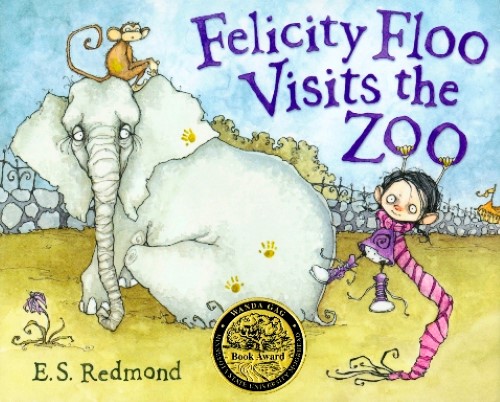
Why are “all of the animals down at the zoo . . . snuffling and snorting and sneezing ACHOO”? It’s all because sniffling Felicity Floo wiped her runny nose on her hand and now has fingers “sticky with green, gloppy goo.” Even though there is a sign warning “please do not pet the animals,” Felicity touches all of them, leaving behind green, germ-laden handprints. Pen and ink and watercolor illustrations in predominantly green and brown tones show wide-eyed Felicity and startled animals.
This highly entertaining picture book was read to a wide age range of children, from two-year-olds through first graders. Children enjoyed the rhyming text and the illustrations. They noticed the handprints on the cover and looked for them on every page. They asked “What’s wrong with the animals?” when they noticed the animals looked sick. During read aloud sessions, children kept scooting forward to get closer to the book and even stood up to see better. One teacher summed up the read aloud experience: “This was a great introduction into a lesson on hand washing and the importance of not spreading germs. This book is great because it really kept all the children interested and sparked many questions.”
This is the first book published by E.S. Redmond. She and her family live in Massachusetts.
The Cow That Laid an Egg written by Andy Cutbill and illustrated by Russell Ayto (HarperCollins Publishers). 2008
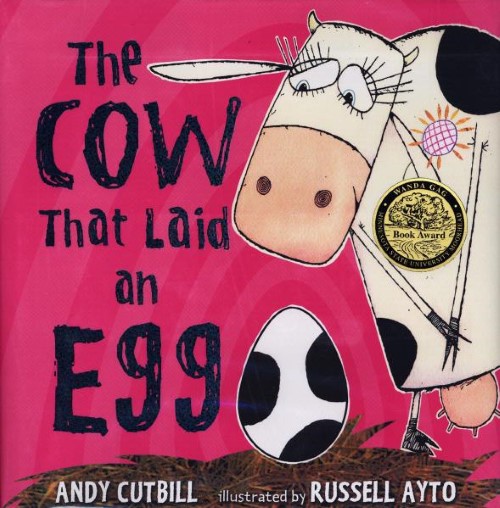
Marjorie, a Holstein cow, feels very ordinary. She’s not able to do handstands or ride bicycles like the other cows. Wanting to help Marjorie feel better, the chickens “hatched a cunning plan.” The next morning Marjorie shrieks that she has laid an egg! The large size font and Marjorie’s wide open mouth emphasize the amazing feat of laying the Holstein-spotted egg. All the farm’s creatures are astonished and the farmer’s wife even calls the newspaper. People arrive by car, bus, helicopter, and balloon to view the extraordinary cow and her egg, much like the hype caused by Charlotte writing in her spider web. The jealous cows, however, get suspicious and tell Marjorie that the chickens laid her egg. Time passes while Marjorie sits on her egg, until finally a “small, brown, feathery bundle” hatches. It might look like a chicken, but Marjorie is vindicated when the creature opens its mouth wide and moos like a cow!
The book’s art and design pleased children. The jacket cover shows Marjorie admiring her spotted egg, while the cover and endpapers are decorated with Holstein spots. The cartoon style mixed media illustrations in pen and ink, watercolor, and collage fit perfectly with this humorous award-winning story.
The book appealed to two-year-olds through third graders who made many comments about the funny story and pictures. The story invited participation, as children “clucked” with the chickens and “mooed” with Marjorie and her offspring. One third grade teacher commented that the students moved their chairs very close to the book and added: “It’s fun, humorous, and adds a lighter side to daily reading. Students sat very still, as if not to miss a word.” One second grader offered a reality check: “Cows are mammals and mammals don’t lay eggs!”
Both author and illustrator live in England, Andy Cutbill in London and Russell Ayto in Cornwall. (Carol Hanson Sibley)
Wolf's Coming! written and illustrated by Joe Kulka (Carolrhoda Books). 2007
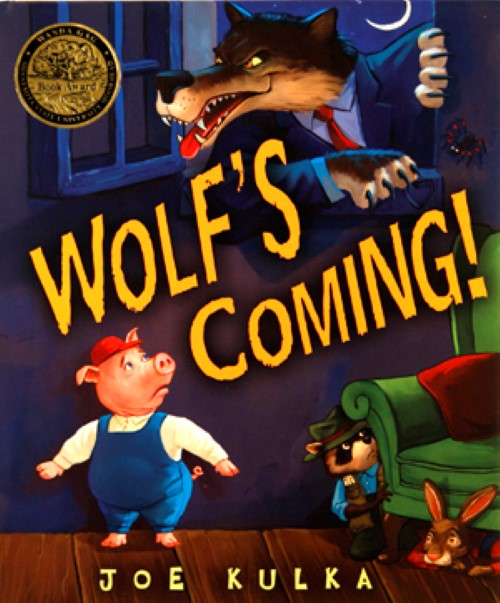
Rhyming text and cartoon style illustrations tell the story of animals hurrying through the woods repeatedly calling out: “Wolf’s Coming!” A dapper, but sinister-looking wolf with yellow piercing eyes follows the animals through the woods. Illustrations become darker and darker as the suspense mounts. Finally, the animals run into a brightly lit home in a tree trunk as wolf creeps closer. When wolf opens the front door, they all yell “Surprise!”—it’s wolf’s birthday.
Children, ages two through nine, “howled” through this story. While some readers thought it might be too scary, young children had their “eyes glued to the book” and wanted it read again and again. Listeners enjoyed the rhyming words, loved the pictures, and liked the surprising twist at the end. The large illustrations and text make this a good choice for group reading.
Joe Kulka resides in Quakertown, PN with his wife and children. This is the first book he has both written and illustrated.
My Father the Dog written by Elizabeth Bluemle and illustrated by Randy Cecil (Candlewick Press). 2006
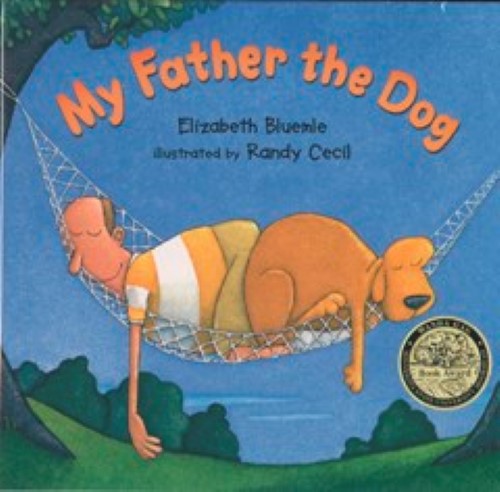
A young daughter provides evidence to prove that her father is really a dog. Each double-page spread offers examples to support her premise. For example, Dad “starts off the day with a good scratch,” runs after balls, and “fetches the newspaper every morning.” The spare, understated text provides plenty of gaps for readers to fill in their own stories about how their dads are similar to dogs. Randy Cecil’s naïve style oil paintings have a colorful, textured quality. The round-shaped, elongated figures are very appealing to children.
Children, ages one through eight, “ate up” this “super silly” book. Young children easily followed the story and laughed as the narrator unveils each reason why her father is a dog. Children loved the pictures and wanted readers to pause so they could spend time looking at the details. This is a winner for individual or group reading. Readers need to be prepared for requests for the book to be read over and over.
My Father the Dog is author Elizabeth Bluemle’s first published book. In addition to writing, she owns the Flying Pig Bookstore in Charlotte, VT. Illustrator Randy Cecil lives in Houston, TX.
The Great Fuzz Frenzy written by Janet Stevens and Susan Stevens Crummel, and illustrated by Janet Stevens (Harcourt). 2005
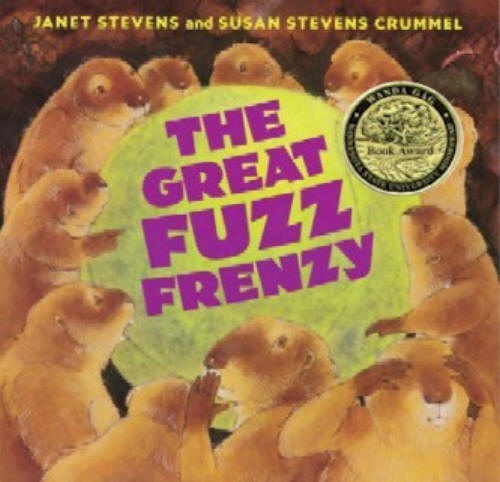
This story set in a prairie-dog town begins on the front endpapers and continues on the title page and copyright page when Violet, a pet dog, drops a green tennis ball into a prairie dog tunnel. A fold-out page shows the ball rolling down the tunnel with shocked prairie dogs looking on. When Pip Squeek pokes at the ball and puts a bit of green fuzz on her head, all of the prairie dogs except Big Bark get into the action: “They fuzzed their ears, their heads, their noses. They fuzzed their feet, their tails, their toeses.” When other prairie dogs pour down the tunnel to get a piece of fuzz the peaceful town turns into “A fuzz feud. A fuzz fiasco.” Bossy Big Bark gets his comeuppance when he steals all the fuzz and is swooped up into the air by an eagle.
The mixed media illustrations in shades of brown along with the green luminescent tennis ball and fuzz humorously depict the plump prairie dogs “abuzz about fuzz.” Effective horizontal and vertical double-page spreads take readers deep into prairie dog burrows.
This winning picture book received perfect scores from all its readers and listeners! The story appealed to first through fourth graders who loved the prairie dog characters and didn’t want the story to end. They liked the upbeat tone of the book, the rich and comical language, and the fold-out pages. They also liked the fuzz and looked for it on every page. Because of the back endpaper where Violet returns with an orange tennis ball, the students predicted that the story wasn’t over afterall.
Teachers and librarians enjoyed reading the book aloud because of all the expressions that could be used. They also found the story useful for emphasizing the reading skills of predicting and drawing conclusions.
Janet Stevens is from Boulder, CO where she and her dog, the real Violet, encounter many prairie dogs. Co-author Susan Stevens Crummel lives in Fort Worth, TX.
I Like Myself written by Karen Beaumont and illustrated by David Catrow (Harcourt, Inc). 2004

An African American girl energetically celebrates her uniqueness. Beaumont’s rhyming text describes a confident, joyful, and silly child who appreciates everything about herself. Catrow’s colorful surrealistic illustrations, created with watercolor, ink, pencil, and collage, playfully interpret and extend the story. For instance, the illustration of the girl and her pet dog splashing in a bird bath adds another dimension to the text:
I may be called a silly nut
or crazy cuckoo bird—so what?
I’m having too much fun, you see,
for anything to bother me!
The book delighted preschoolers through second graders, who asked to have the book read again and again. They laughed and giggled at the pictures and found something that captivated them on every page. They also enjoyed the rhyming text and commented: “I like myself, too.”
Author Karen Beaumont lives in San Martin, CA and illustrator David Catrow is from Springfield, OH.
Mina written and illustrated by Matthew Forsythe (Paula Wiseman, an imprint of Simon & Schuster Books for Young Readers). 2022

Mina, a young bookworm mouse, lives in a cozy home in a tree with her unpredictable father. He likes to bring home items from the human world to adapt, such as tin cans that become a microphone or telephone, postage stamps to add to his collection of antique art, and even stick insects. However, when he brings home “a squirrel,” Mina starts to worry, and that’s when listeners begin to shout, “That’s not a squirrel; that’s a cat.” All goes well for a while. Father knits the cat a sweater, and he and Mina ride on its back for adventures in the woods. When the cat quits eating, Father decides it’s lonely and brings home two more surprises. However, when they won’t eat either, Father phones the doctor. Without hesitation, the doctor announces: “‘The problem is that these squirrels are definitely cats.’” The chase is on. The three cats pursue Mina, her father, and the doctor who run for their lives. But they are miraculously saved by a stick insect who Mina taught to read. Reading saves them! When the stick insect reads in a loud and deeply charismatic voice, the three cats fall asleep. As one listener declared, “It’s a bedtime story.”
Excellent pacing of the text, dramatic page turns, and oversized illustrations captured the attention of kindergarteners and first graders. The story is predictable from the cover showing Mina standing on the shadow of a cat’s head to the dramatic facial expressions of the cats, especially their eyes, which become more sinister as the story progresses. The illustrations created with watercolor, gouache, and colored pencils provide a soft dreamy world with small details that intrigue children. Listeners were very engaged with this picture book, predicting key moments, shouting out warnings, enjoying the humor, and noticing the joy and importance of reading.
This is the second Wanda Gag Read Aloud Book Award for Matthew Forsythe, who won as the illustrator of Please, Open This Book! in 2016. Forsythe has illustrated several other picture books and has written and illustrated Pokko and the Drum, another animal story. He is also the illustrator of animated films and TV shows. Forsythe, who was born in Canada and raised in London, has traveled the world from Ireland to Korea, where he taught kindergarten. He now makes his home in Montreal, Canada. When he decided that teaching was way too exhausting, he realized that he could create picture books and comics. Mina, which received five starred reviews, addresses one of Forsythe’s themes that parents are not always ideal. [CAROL HANSON SIBLEY]
Honor Books
Mela written by Maddalena Schiavo and illustrated by Eleonora Pace (Creative Editions). 2024

Inspired by illustrator Eleonora Pace’s real-life experience of adopting a dog named Mela (Italian for “apple”), this heartwarming picture book, written by Maddalena Schiavo, strikes a chord with animal lovers and pet owners of all ages. The story gently explores the emotional journey of a rescued dog with an uncertain past as she forms a bond with her new family, who bring their own hopes and expectations. Through tender storytelling and evocative illustrations, the book beautifully captures the mutual patience and affection that grow between Mela and her adoptive owner.
Students from kindergarten through second grade responded enthusiastically to the story. They were drawn in by the vivid, expressive artwork and quickly recommended the book for their school library. The narrative’s authenticity deeply resonated with many, prompting connections to their own experiences with adopted pets. Teachers noted the book’s calming effect, making it an ideal choice for Social Emotional Learning. During read-alouds, students leaned in, made thoughtful comments, pointed out specific illustrations, and even broke into spontaneous applause. One teacher shared that students connected strongly with the book’s central message: that sometimes, good things take time.
Author Maddalena Schiavo lives in Vicenza, Italy. Before turning to writing, she worked for several years in a public library. Today, she publishes children’s books across Italy and enjoys engaging with young readers through workshops and school visits. Illustrator Eleonora Pace teaches watercolor and art to learners of all ages. She currently lives in the tranquil mountains of South Tyrol, where she teaches at a local art school and continues to bring stories to life through her illustrations.
The Yellow Bus written and illustrated by Loren Long (Roaring Brook Press). 2024

The Yellow Bus, written and illustrated by Loren Long, tells the story of a school bus that once had a joyful job taking kids to and from school. It loved being part of their everyday lives. But as time passed, the bus grew old and was no longer needed. It was left behind, sitting unused and forgotten. Still, the bus found new ways to be useful—like becoming a shelter or a place for animals to play. The story shows that even when your role changes, you can still have value. It's about growing older, facing change, and finding purpose in new ways. The book mixes a gentle message with powerful art to remind us that there's always something meaningful ahead.
After listening to the story, readers fell in love with The Yellow Bus by Loren Long because of the themes of finding joy and purpose, even when life changes. Readers highlighted that they enjoyed the patterns of the story as the bus helps children, then serves the elderly, becomes a shelter for people in need, provides a home for farm goats and eventually for fish. Readers also commented on the beautiful illustrations that used bright yellow for the bus against mostly black-and-white backgrounds, which makes her stand out and feel special but also is purposeful in the emotions presented throughout the story.
Author and illustrator Loren Long was born in 1964 in Joplin, Missouri. He grew up in Lexington, Kentucky, and earned a BA in Graphic Design from the University of Kentucky. After attending the American Academy of Art in Chicago, he began his career as an illustrator for a greeting card company before transitioning to freelance work. Long is best known for his Otis series. He has also illustrated bestselling books for authors like Barack Obama (Of Thee I Sing), Matt de la Peña (Love), and Amanda Gorman (Change Sings).
The Together Tree written by Aisha Saeed, illustrated by LeUyen Pham (SALAAM READS, an imprint of Simon & Schuster Children’s Publishing Division). 2023
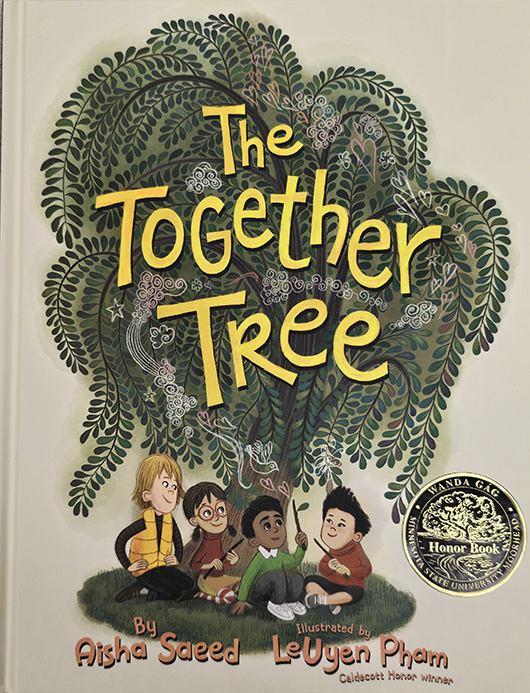
It is extremely difficult to watch our children going through the trials of life. Such a time occurred for author Aisha Saeed who observed a few of her son’s kindergarten classmates bully him. She also noticed that while the rest of the class didn’t participate, they didn’t seem to know what to do. Hoping to help her son, Ms. Saeed wrote The Together Tree. In this quietly compelling and powerful story, Rumi feels unwelcome and alone at his new school. During recess, as Rumi finds solace under a giant willow tree, he becomes a target for bullying. It isn’t until a lone upstander comes to Rumi’s aid that other classmates begin to see the importance of standing together against bullying. Throughout the story, readers see a black and white, dreary, leafless tree change into a beautiful, shade yielding place of safety. Alongside the tree are bullies, a bullied boy, and bystanders who also change and learn to stand tall together. In the process the reader learns that kindness often has the power to change many lives.
When the story ended, some classes were extremely quiet, trying to process the power and impact of the story. The colors the illustrator, LeUyen Pham, used played a significant part in the story. The kids commented that at the beginning, the tree seemed lifeless and sad and so did Rumi. The pictures of the bullies were in black and white when the children were bullying Rumi. Although he is in color, his facial expressions reveal his hurt, rejection and loneliness. Later, when the children started to ask Rumi if they could play with him, Asher, the bully, felt rejected and left out and he was the only one still pictured in black and white. As the tree flourished, the kids realized that the students in the story had started to accept one another. Eventually, all came together in a safe, restful place, together under the tree. “A powerful read, one that will fit in well with curricula and be helpful for counselors, etc.” Teachers asked their librarians to purchase the book and some classrooms hoped The Together Tree might be this year’s winner.
Aisha Saeed, a Pakistani American, is the bestselling and award-winning author of Amal Unbound, Omar Rising, and Bilal Cooks Daal. In 2018 Amal Unbound was selected as the Global Read Aloud and in 2020 Bilal Cooks Daal won the Asian American Pacific Islander Literature Award Honor. LeUyen Pham is the illustrator of over 120 books, most notably of the Caldecott honor winner Along Came Bear, Princess In Black series, and Real Friends series. She lives in Los Angeles, CA.
Acorn Was A Little Wild written by Jen Arena and illustrated by Jessica Gibson (Simon & Schuster Books for Young Readers). 2022

Not wanting to wait around to see what happens, little Acorn takes a jump off the tree to seek an adventure of their own. Acorn was a little wild tells the story of what can happen to an acorn once it falls off an oak tree. Rolling down hills and being picked up by a pesky squirrel; narrowly escaping one squirrel’s mouth and flying from a tree only to be picked up by another squirrel and buried deep underground. After initially thinking all their fun is over underground, little Acorn starts a new adventure as he stretches and grows, pushing through the soil and back into the sun. Bright, colorful illustrations accompany playful text which provide the reader with an introduction to how an acorn gets from the branches of an oak tree, planted deep underground, and then grows into a tree of their own.
While listening to the book, preschool, kindergartens, and first graders showed rapt interest in the illustrations and repeated phrases often trying to stretch or shift closer to the book. Several readers noted the children made lots of positive comments and laughed throughout the book. One teacher commented that it was a clever way to introduce oak trees and how the oak tree grows.
Author Jen Arena lives in Tampa, Florida where she writes and edits. Other books by Arena are Besos for Baby, Lady Liberty’s Holiday, and Marta! Big & Small. Jessica Gibson is a freelance illustrator from Detroit, Michigan. [LISA EGGEBRAATEN]
I Can’t Draw written by Stephen W. Martin and illustrated by Brian Biggs (Margaret K. McElderry Books). 2022

I Can’t Draw is about Max, a boy who loves to draw but doesn’t think he is any good at it. He asks his friend Eugene (the best artist in the class) for tips on how to be a better artist. Eugene suggests a variety of ways for Max to improve his drawing skills, but none of his attempts look like Eugene’s. Then, an idea hits Max: Instead striving to be exactly like Eugene, perhaps they could team up! Max adds his own unique flair to Eugene’s drawings. Their collaboration turns out to be exactly what Max needs to realize that he actually CAN draw. This book is a lesson in appreciating your own talents and unique abilities that kids can relate to.
Students showed a great deal of enthusiasm for this book. They found a lot of humor in the drawings and Max’s responses eliciting laughter and spontaneous comments. Students enjoyed the differences in the “How to draw a cat” instructions from Max and Eugene on the end pages of the book. Several students wanted to try following the steps themselves. Others wanted to team up with a classmate to do their own drawing collaborations. Many of the students identified with Max’s feelings and related them to their own experiences. This led to animated class discussions about how everyone has different talents.
Stephen W. Martin is a writer on Netflix’s Trash Truck and the author of several picture books. He grew up in Canada and now lives in Los Angeles with his wife and dog. Brian Biggs is the author and illustrator of many books for kids. He has worked as an art director, graphic designer, animator, and university professor. [STEPHANIE NEWLAND]
“Maybe…” written and illustrated by Chris Haughton (Candlewick Press). 2021.
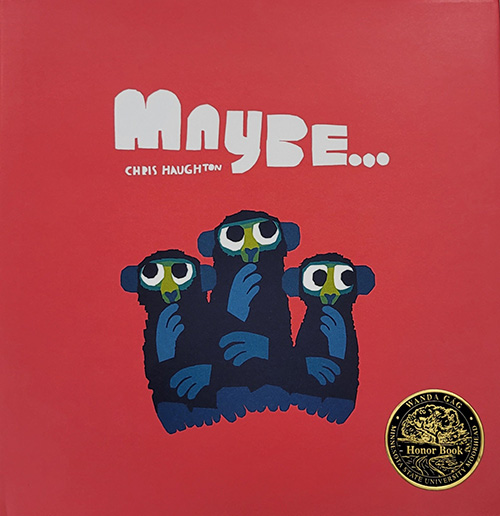
Chris Haughton delights readers with his new book, Maybe… This cautionary tale features a trio of misbehaving, mango-loving monkeys demonstrating what can transpire when they don’t listen to the big monkey in charge. With his bold choice of colors and his signature collage-style art, Haughton takes readers on a suspenseful ride through the jungle with these naughty but loveable monkeys. Will this mischievous bunch get those irresistible mangos, or will they find themselves becoming breakfast for the tigers hiding below? Maybe… you will need to read this book to find out.
Maybe… received great reviews from children ages five to seven. Many were on the edge of their seats, laughing and pointing as they heard about the naughty monkeys and the tigers hiding in the jungle throughout the book. One teacher said it best, “This is a fun, interactive read for kindergarten, because the language is simple and patterned, the kids caught on quickly to the plot, and repeated words from the story with me.” Feedback from readers noted that in response to the book, classrooms erupted with animal sounds, multiple children asked to read the book again, and many of Haughton’s other titles were checked out from the library.
Chris Haughton is an author and illustrator from Ireland who is currently based in London. Haughton has amassed many nominations and awards for his works, including the Ezra Jack Keats Award. Maybe... is his sixth book. Some of his previous titles include Shh! We have a Plan, Oh No, George!, and Don’t Worry, Little Crab. In addition to writing children’s books, Haughton spends time making apps, toys and rugs. [JEANNE ANDERSON]
Norman Didn’t Do It! (Yes, He Did) written and illustrated by Ryan T. Higgins (Disney-Hyperion, an imprint of Buena Vista Books, Inc.). 2021.
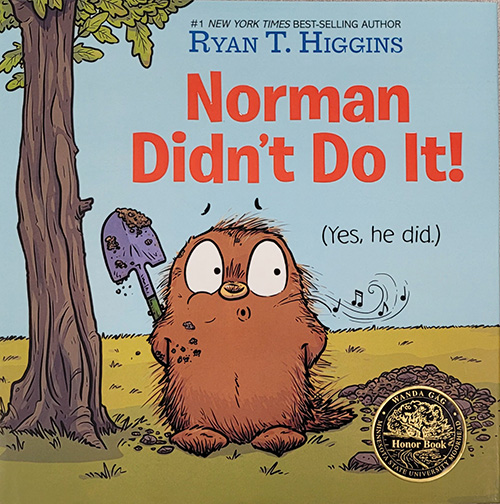
In Norman Didn’t Do It! (Yes, He Did), porcupine protagonist Norman is best friends with a tree named Mildred. The two of them play chess, read books, play baseball, and Norman loves that it is just the two of them. One day a seedling pops up and Norman becomes extremely jealous. He is afraid Mildred will like “the other tree” better than she likes him. One night he decides to take care of his problem once and for all, but immediately regrets his actions. Norman Didn’t Do It! (Yes, He Did) is a witty, humorous book about friendship, jealousy, and making amends.
Students ages five to eight loved this book! They nudged closer to the reader, laughed spontaneously, made positive comments, and told others about the book. They found the illustrations engaging. Norman is a memorable character and children are able to relate his friendship dilemma. Norman Didn’t Do It! (Yes, He Did) is a book children will want to read again and again.
Ryan T. Higgins is the best-selling author of We Don’t Eat Our Classmates and the Mother Bruce series. Higgins received the E. B. White Read-Aloud Award for Mother Bruce and was awarded an Ezra Jack Keats New Illustrator Honor for the same title. We Don’t Eat Our Classmates was a Wanda Gág Read Aloud Honor book in 2019 and Wilfred was a Wanda Gág Read Aloud Honor book in 2014. Higgins currently lives in Maine with his wife, children, and several pets. [STEPHANIE NEWLAND]
Swashby and the Sea written by Beth Ferry, and illustrated by Juana Martinez-Neal - Author Illustrator, and published by Houghton Mifflin Harcourt Publishing Company, 2020.
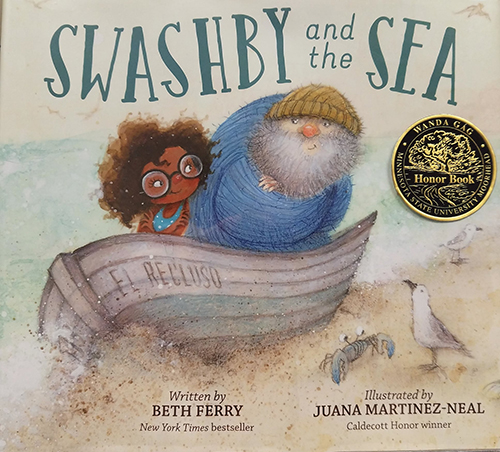
In this book, young readers will be reminded that it is never too late to make new friends. Retired sea captain Swashby loves his quiet life by the sea. But when a young girl and her grandmother move next door, it looks like his serene days may be over. When Swashby tries to send his new neighbors messages in the sand, his old friend, the Sea, has a way of adjusting the messages to get the captain just what he needs. This sweet and funny story is a perfect blend of well-patterned text and beautiful illustrations that will have readers looking for the little details that make this story come to life. With an ending that will surely please, this story will also be perfect for character analysis or for a lively discussion on what it means to be a friend.
Readers from ages 4-8 were completely engaged in Swashby and the Sea. Teachers noted several examples of student’s facial expressions showing interest, making unsolicited positive comments, as well as pointing out something in the story. One teacher noted, “My students loved reading Swashby’s messages and the Sea’s reply”, which are shown creatively through the illustrations. Two classes chose this title as the favorite of what they read this year and one teacher even said that this book gave her “goosebumps”. Both students and teachers commented on the important message of the power of friendship and how much they appreciated the role of the illustrations in the story.
This is the first collaboration between Beth Ferry and Juana Martinez-Neal. Beth Ferry is a children’s book author from New Jersey who has written over fifteen picture books. Juana Martinez-Neal, originally from Lima, Peru, and now living in Arizona, is the Caldecott Honor winning illustrator of the book, Alma and How She Got Her Name. [LOUIE LAUER]
A Tiger Like Me written by Michael Engler, illustrated by Joëlle Tourlonias, translated by Laura Watkinson (Amazon Crossing Kids). 2019
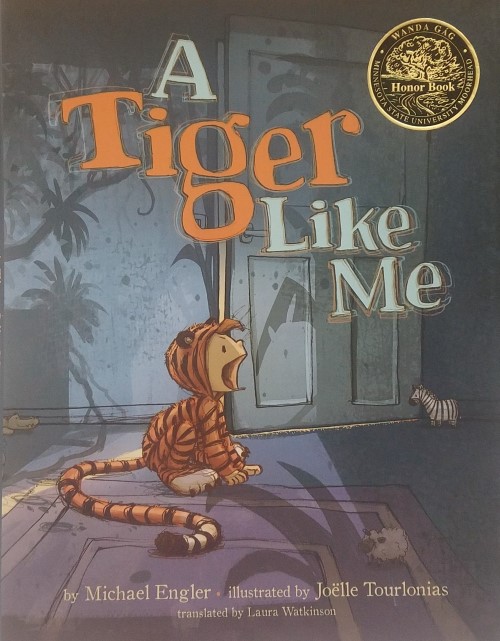
Is he a tiger or a boy? That is the question. Imaginative play creates a frenzy of activity as a tiger-boy stalks his food, roars a powerful roar, stretches, growls, pounces on his unsuspecting father, and generally creates mayhem. When evening comes, the wide-awake tiger eventually becomes a cuddly, snuggly, sleepy tiger cub. The illustrations emphasize the frenetic energy of the wild and wary tiger-boy. Splashes of color dot the pages and emphasis the movement of the boy throughout the book. The stuffed animals that follow him are cleverly hidden on each page and add visual interest to the story.
Children loved joining in on the story by “roaring” and chanting the refrain, “I am a tiger!” They liked the illustrations, the jungle theme, and could relate to the boy pretending to be a tiger. Many children asked that the book be bought for their school library.
The book was first published in Germany as Ich bin ein Tiger in 2016. The author, Michael Engler, lives in Düsseldorf, Germany and writes children’s books and plays for theater and radio. He has written more than fifteen children’s books that have been translated into thirteen languages. Illustrator Joëlle Tourlonias also lives in Düsseldorf and has illustrated more than thirty picture books. (PAM WERRE)
Hey, Dog written by Tony Johnston, illustrated by Jonathan Nelson (Charlesbridge). 2019
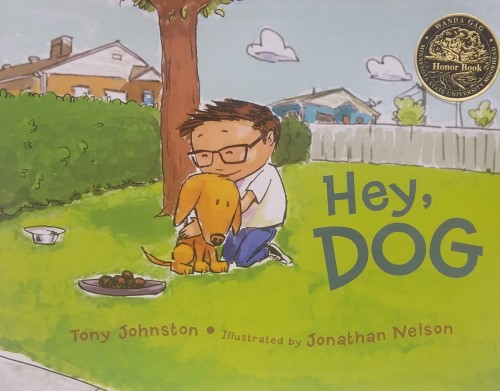
A perceptive young boy discovers a thin, brown dog cowering in the bushes near his home. The dog has been abandoned and abused, but with patience, kindness, and some luscious dog food, the boy is finally able to entice the pup to come out with the whispered wish, “Hey Dog. Come on. Let’s go home.” The illustrations are effective in conveying the emotions of the boy, his mother, and the dog. Truly a heartfelt story of love and redemption.
Teachers noted that children were captivated by this book and swept up by the strong emotions portrayed in the story. The book taught many important concepts including empathy, problem solving, perseverance, and how to care for dogs and others. The children noted how careful the boy was with the dog and that the mood and illustrations became lighter once the boy had won the dog’s trust.
Tony Johnston lives in California and has written more than one hundred books for children including Winter is Coming, Puma Dreams, A Small Thing…But Big, Voice from Afar: Poems of Peace and The Harmonica. Her books have won numerous awards and prizes. Illustrator Jonathan Nelson is Diné (Navajo) and was born and raised in the Four Corners area of New Mexico. His graphic novel, The Wool of Jonesy, was an American Indian Youth Literature Honor book in 2018. Nelson illustrated the book, First Laugh – Welcome Baby!, notable for its depiction of Navajo culture and traditions. (PAM WERRE)
Blue written and illustrated by Laura Vaccaro Seeger (Roaring Brook Press). 2018

Using a simple rhyming text and just two words per page, Laura Vaccaro Seeger uses the color and feeling of blue to share a universal story of life and death in a new and fresh way. Seeger explores the emotions associated with the many shades of blue during the relationship between a boy and his dog as the boy grows from a child to a man. Her use of acrylic paint on canvas and die-cuts connect the life experiences of the boy throughout the book.
This book was shared with over 300 students from preschoolers through 5th grade as well as high school and college students; proving this is a powerful, timeless, and ageless story. At first glance, this book appears to be a very elementary introduction to color. However, older students were aware of the difficulty of telling a story with such few words and were impressed with the illustrations that used strategically placed cutouts to bring a more complete understanding to the story. Children realized that this complex story was conveyed through the combination of the illustrations and the words.
Students felt a universal response to Blue. They were often very quiet as they contemplated the story’s ending, and then would erupt with applause. There was lengthy discussion about this unique approach to a timeless theme. One student summed it up by commenting that it was “so simple, it was beautiful.” The power of its message helped both students and adults cope with the death of their pets when they heard this story.
Laura Vaccaro Seeger is a two-time winner of both the Caldecott Honor Award and the Theodor Seuss Geisel Honor Award and a plethora of other awards and accolades. She has been drawing since she was two years old and while in the fifth grade, she wrote an essay stating that she was born to make picture books. With around 20 picture books to her name and more to come, she certainly seems to be proving that is true. [CONNIE HOWITSON]
We Don’t Eat Our Classmates written and illustrated by Ryan T. Higgins (Disney-Hyperion). 2018

Don’t worry, no dinosaurs ate any classmates in the making of this book! It is Penelope Rex’s first day of school and she is really nervous. There’s a big problem. All of her classmates are children and they look so delicious! Will Penelope be able to make any friends without eating them first?
Higgin’s book was inspired by his experiences with his own children and their classmates. He created Penelope Rex to be as cute and innocent looking as possible so children would find her relatable. The story revolves around making friends and treating others the way you want to be treated. An interesting note is that Higgins used drawings of dinosaurs created by his children and their friends to decorate the endpapers. Readers found that many children were “captivated” and engaged throughout the book. One class voted this book as their classes’ “kids’ choice.” Preschoolers through second graders really enjoyed the bright, colorful illustrations, the humor, the detailed illustrations, and the surprise ending.
Ryan T. Higgins has a degree in ecology, but he always wanted to be a cartoonist. His books, such as Be Quiet!, Mother Bruce, and Wilfred have been national bestsellers. He received an E.B. White Award and an Ezra Jack Keats Honor Award for his book, Mother Bruce. His book, Wilfred, was a Wanda Gág Read Aloud Honor Book in 2014. Ryan currently resides in southern Maine with his family and wide variety of pets. [CASSEY SLATER]
After the Fall: How Humpty Dumpty Got Back Up Again written and illustrated by Dan Santat (Roaring Brook Press). 2017
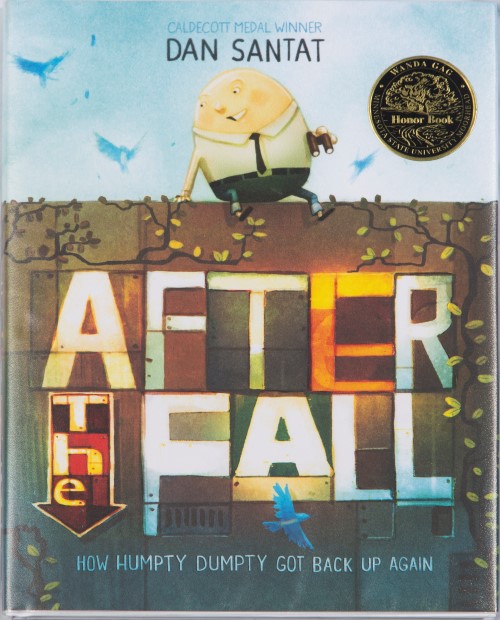
Have you ever wondered what COULD have happened if all the king’s horses and all the king’s men COULD have put Humpty together again? This modern day twist on a favorite nursery rhyme classic tells the tale of a legendary egg who faces his fears and triumphs in a surprising and majestic way.
Dan Santat is the author and illustrator of numerous children’s picture books and his artwork is featured in both chapter books and middle-grade novels. Santat won the 2015 Caldecott Medal for The Adventures of Beekle: The Unimaginary Friend and he is the winner of the Silver Medal from the Society of Illustrators for Oh No! Or. How My Science Project Destroyed the World. Santat is the creator of the Disney animated series The Replacements. He lives in southern California with his wife, two kids, and many, many pets. (LIZ LYNCH)
The Darkest Dark written by Chris Hadfield, illustrated by The Fan Brothers, as told to Kate Fillion (Little, Brown Books for Young Readers). 2016
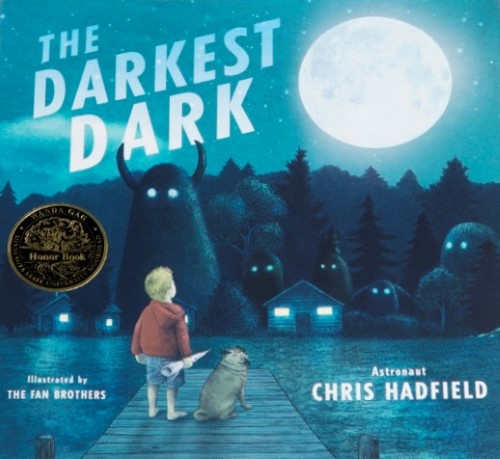
This is the tale of how a young boy’s love of planets and space exploration helps him overcome his fear of darkness. As a child, Chris Hadfield was inspired to pursue his own dreams after observing the Apollo 11 moon landing on television. This experience changed the way Chris perceived the darkness, and inspired him to become an astronaut and later the first Canadian Commander of the International Space Station (ISS).
Themes within this book sparked lots of conversations with children across a wide range of age levels. Younger readers especially related to the theme of bedtime fear of the dark. The story helped children realize that they too can overcome their fears. Children commented “I loved the colors and pictures in this book,” and “I want this book to win a prize, I really, really liked this book”. Children were surprised and delighted to learn that the boy in the story really did become an astronaut.
Chris Hadfield follows up his two previous books on space exploration and the life of an astronaut with this children’s book inspired by his own childhood experiences. His books give us a remarkable glimpse into the day-to-day world of space exploration. Hadfield’s extensive career as a pilot and astronaut included over 25 Shuttle missions, work as a NASA Scientist and Engineer, and acting as Commander of the International Space Station. Co-Author Kate Fillion is a bestselling author and journalist who lives with her family in Toronto.
Illustrators Terry and Eric Fan have created rich and beautiful images of a young boy wrestling with his fear of the dark, and of our solar system and the astronauts who explore it. Through the brother’s use of ink and graphite mixed with digital art, the images portray the “darkness” of both settings. (MARILYN LABRENSZ AND LISA STAIGER)
The Night Gardener written and illustrated by The Fan Brothers (Simon & Schuster Books for Young Readers). 2016
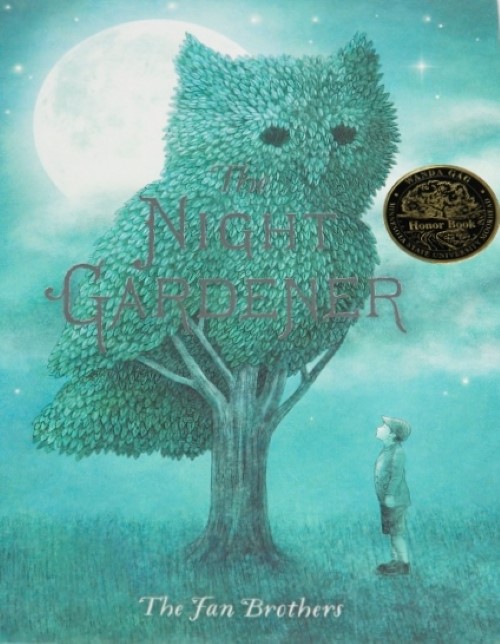
Grimloch Lane is a gray place until the morning young orphan William awakens to find that a tree on his street has been sculpted into a giant and beautiful owl. Each day a tree in the neighborhood become a cat, then a rabbit, then a parakeet, and finally a dragon. As a result, this little gray town becomes colorful and full of vitality and life once again. One night William spots the night gardener and receives a wonderful topiary lesson from him. Though the night gardener leaves, the town and William are changed forever.
Children who listened to this book loved it and expressed lots of “oohs” and “aahs” as they enjoyed the visual discoveries on each new page. The readers stated that this was a unique book with many hidden details. The prediction from children and readers is that this book is destined to become a classic.
This is the first picture book for brothers Eric and Terry Fan. The drawings are a blend of traditional and contemporary techniques, using highly textured graphite and deepening digitally colored compositions. The Fan Brothers received their formal art training at the Ontario College of Art and Design in Toronto and currently live in Toronto, Canada. (KATHY VANDER VORST)
What to Do With a Box written by Jane Yolen and illustrated by Chris Sheban (Creative Editions). 2016
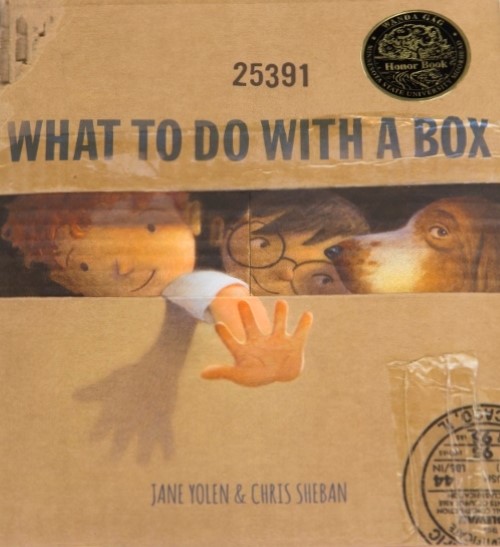
This delightfully simple, poetic salute to the wonders of cardboard boxes is ideally suited to younger readers and evokes fond memories in more mature readers. Beloved author Jane Yolen’s verse stimulates the imagination without the sing-songy quality often found in children’s rhymes. Chris Sheban created the illustrations on real cardboard boxes and incorporated actual postage stamps, warnings, and tears into the story. The end result is a book whose text and illustrations combine to create a “total package” (pun intended).
When reading this book, children love to share their memories of playing with boxes and develop new ideas for cardboard creativity. While the book may be simple in text and appearance, the possibilities for the imagination are endless!
Award-winning author Jane Yolen has written over 300 books and lives primarily in Massachusetts, although she also owns a house in Scotland, where she spends time each year. Her books have won numerous awards including a Caldecott Medal for Owl Moon. Chris Sheban lives in Chicago and has won multiple honors from the Society of Illustrators. (AMY SOMA)
If You Ever Want to Bring an Alligator to School, Don't! written and illustrated by Elise Parsley (Little, Brown and Company). 2015

Magnolia was told to bring something from nature to school for show-and-tell. Despite her teacher’s warnings about how much trouble they are, she decides to bring an alligator to school. Magnolia promises her teacher that the alligator will be good. However, readers will see many humorous reasons why you should NOT bring an alligator to school. Even though the alligator gets Magnolia into trouble with all of his shenanigans, Magnolia is determined to impress her classmates with her show-and-tell. She shows her class how alligators are super big, have super sharp teeth, and are super tough. Magnolia demonstrates how to send your alligator running for the hills, by yelling “BOOGA, BOOGA, BOOGA!” when you are tired of his naughty behavior. Even though she gets rid of her ill-behaved alligator, Magnolia is still sent to the principal’s office for all the mischief the alligator caused throughout the day.
Readers commented on the detailed illustrations in the book. The illustrations show exactly how the characters are feeling and they complement the story. The book was a hit among all readers. Children were engaged from the moment they were shown the front cover and throughout the entire book. They asked for the book to be read again and again. Readers highly recommended the book as a read aloud.
Elise Parsley studied drawing and creative writing at Minnesota State University Moorhead. She and her husband live in South Dakota. If You Ever Want to Bring an Alligator to School, Don't! is Parsley’s debut picture book. (ELIZABETH BAKKEN-MAYNARD)
A Tale of Two Beasts written and illustrated by Fiona Roberton (Kane Miller). 2015

Children found this book unique as it tells two stories in one. First, a young girl relates how she “rescued” and cared for a strange beast, actually a raccoon. In part two, the raccoon tells his side of the story of how he was “ambushed” and ill-treated by a terrible beast, actually the young girl. Children learned how one event can be seen differently depending on your point of view.
Children from preschool through fourth grade were completely engaged with this book. They liked the bright, vibrant colors in cartoon style, and enjoyed both the humor and the mystery in the story. They asked questions about the book and had many comments. Readers found that the book was easy to read aloud and enjoyed changing their voices to depict the two main characters.
In 2011, Fiona Roberton’s first picture book, Wanted: The Perfect Pet, received the International Literacy Association children’s book award for a newly published author. Roberton, who was born in Oxford, England, now lives in London when she is not following her passion of traveling the world. (CAROL SIBLEY)
Those Pesky Rabbits written and illustrated by Ciara Flodd (Little Bee Books). 2015
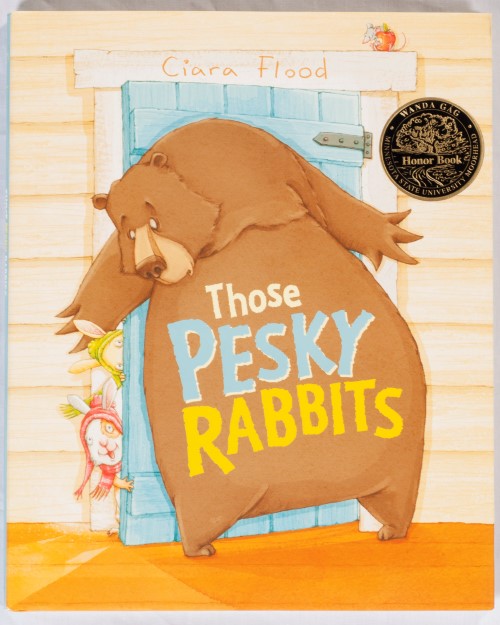
Grumpy Bear discovers he has a family of pesky rabbits as his new neighbors. The rabbits knock on Mr. Bear’s door and ask for various items which, of course, Bear loudly and emphatically refuses to share with them. The rabbits decide that Bear needs their help and friendship and they provide him with a basket of goodies loaded with all of the things he would not share with them. Bear enjoys the gifts and then realizes he has made a terrible mistake and that he would really like some new friends. With the addition of the rabbits, Bear finally has a complete home sweet home.
The detailed illustrations clearly depict the emotions of the friendly rabbits and the grumpy Bear who just wants to be left alone. Flood includes numerous inside jokes in the illustrations that kept children interested in the story and captured their attention.
Children in preschool through second grade enjoyed participating in the sound effects featured in the book and were engaged in the story through the detailed and humorous illustrations. Teachers noted that the children recognized that at first Bear was angry and mean, but then he changed and the children felt sympathy for him because he was lonely. Children commented that we all make mistakes and can change for the better.
Ciara Flood is a freelance illustrator and Those Pesky Rabbits is her first picture book. Flood lives in London with her partner and young son. (PAM WERRE)
A Perfectly Messed-Up Story written and illustrated by Patrick McDonnell (Little, Brown and Company). 2014
Sometimes stories don’t work out as planned; in fact, they can get a little messy. In this book you’ll meet Louie, a simply-drawn protagonist who just wants to share his straightforward story with the world. All Louie desires is to tell the reader a happy little tale that is clean and clear of blemishes or distractions to the reader. Unfortunately for poor Louie, more messes and mishaps find him with each page turn.
This tale captivated listeners (ages 5 through 8) as Louie broke from his world inside the book to address the reader directly. Louie desperately tries to prevent the messes that spilled, plopped, and stained his quaint, tidy storybook world. The dramatic and unfortunate stains and Louie’s frustration involved children in the story. Listeners were captivated by the realistic smudges of jelly and peanut butter on the pages of the book. The clever and simple illustrations were enjoyed by readers and prompted them to lean in for a closer look at the book.
Patrick McDonnell is the creator of the comic strip, Mutts (muttscomics.com) and has written and illustrated a number of children’s books including: The Gift of Nothing, The Monsters’ Monster, and Me...Jane, a Caldecott honor book. McDonnell is a New York Times bestselling author and resides in New Jersey. (SARA WATSON CURRY)
How Martha Saved Her Parents from Green Beans written by David LaRochelle and illustrated by Mark Fearing (Dial Books for Young Readers, an imprint of Penguin Group). 2013

The adventure begins with Martha's grim existence on an average Tuesday evening struggling with the challenge of eating her vegetable – green beans. Despite her parents' encouraging suggestions to consume the "healthy" green beans, Martha believes that green beans are VERY bad. The adventure continues with a mean, swaggering gang of green beans who kidnap Martha's parents.
The bright and colorful illustrations create a visually pleasing detailed journey of Martha and the evil gang of green beans. The intricate textures in the pictures add to the humor and horror of the spirited characters – both the green beans and Martha.
Children ages 6 to 9 found the book enticing, exciting, and humorous. The story kept them enthralled throughout the entire book. Teachers commented that the book "was suspenseful for the students" and they enjoyed the eyes on the lettuce; a perfect segue into Martha's second adventure.
David LaRochelle was born and raised in Minnesota. After a short career as an elementary school teacher, David became a full-time illustrator and author and currently lives in White Bear Lake, MN. Mark Fearing was raised in Minnesota and is an author and illustrator of books in his favorite genres of science fiction, horror, and humor. HEATHER NESEMEIER
Mr. Tiger Goes Wild written and illustrated by Peter Brown (Little, Brown and Company). 2013

Mr. Tiger lives in a drab Victorian village where his bright orange color and black stripes stand out among the other animals. He grows tired of being so proper, "He wanted to be . . . wild." On a dramatic double-page spread Mr. Tiger appears lower and lower on the page and then a page turn shows him on all fours! Now he is ready to explore a new kind of life. He scampers about with abandon and roars like a real tiger. His friends finally lose their patience when he jumps into a fountain and climbs out "naked." Mr. Tiger run away to the wilderness where he enjoys his new found freedom until he becomes lonely. When he returns home, he finds that his friends have also changed. They have discovered the joy of just being themselves.
From the wrap-around jacket to the textured book cover, sporting huge orange and black stripes, to the endpapers which change from dull bricks to the greens of the wilderness, to the heavy weight of the paper, this picture book is a perfect example of book design. Peter Brown created the illustrations with India ink, watercolor, gouache, and pencil, then composed and colored them digitally. Children will enjoy comparing Brown's wilderness with that of Henri Rousseau's painting entitled "Tiger in a Tropical Storm (Surprised!)," where there are many similarities in color and shape.
Children in preschool through age eight enjoyed the story and superb art. They roared with Mr. Tiger and giggled at his antics, saying "Oh, no, Mr. Tiger is naked!" Most of all they appreciated the message: "We are all special. We can't be someone else. Home is great." One kindergarten teacher commented: "I have a sign in my room. If you can't be brilliant be odd. This book fits that sign." An eight-year-old Peter Brown fan exclaimed: "Peter Brown is awesome." He added that Peter must like black and orange (thinking also about "Creepy Carrots"). The following comment from a second grader sums up the children's enthusiasm: "Make this book win the award!" CAROL SIBLEY
Wilfred written and illustrated by Ryan Higgins (Dial Books for Young Readers, an imprint of Penguin Group). 2013
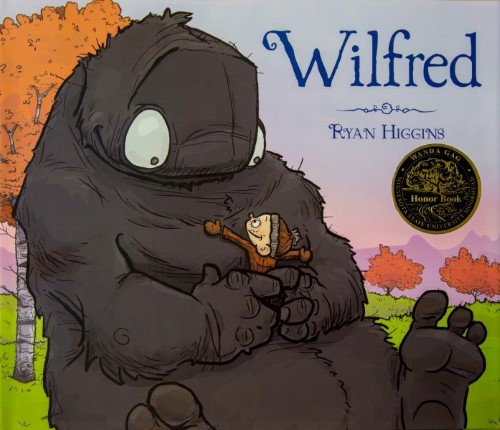
Once upon a time in a faraway land lived a lonesome, hairy giant named Wilfred. Wilfred's massiveness and hairiness frightened many away. Wilfred was lonely. That is, until one day he happens upon a little town with unusual people; they are all bald, even the women and children. One brave young boy befriends Wilfred and realizes that Wilfred is a very obedient and lovable creature. Greedy townspeople see Wilfred's hair as a way to end their baldness and convince Wilfred to shear away all of his hair. Cold and hairless, Wilfred is bound to his cave to keep warm near the fire. Seeing some of the citizens wearing wigs, the little boy realizes why his big, hairy friend has not returned to play. In an effort to save his friend from freezing, the little boy makes Wilfred giant mittens. The courageous boy gets caught in a blizzard on the way to deliver the mittens to Wildred. The townspeople search and search and finally find the boy safe and warm. Wilfred had saved the little boy. The townspeople finally realize that Wilfred is a hero and not a monster. The whole town comes together, covering Wilfred in blankets to keep warm, while others busily sew their wigs together in order to make a coat for Wilfred.
Higgins' detailed illustrations range from double-page spreads with Wilfred's body extending to both pages to vignettes showing Wilfred complying with his friend's commands. The large illustrations made this book perfect for a read aloud. The illustrations enhance the text by showing characters' emotions and portraying just how lovable Wilfred really is.
This book was really engaged children ages five to nine. The fantastic illustrations and humorous characters drew them in. Children were enamored with and immobilized by the book. This book stirs up compassion in students and sends a wonderful message about friendship. Readers highly recommended this book, and children begged for it to be read again.
Ryan Higgins, the author and illustrator of Wilfred, resides in Southern Maine with his family. ELIZABETH BAKKEN
Oh, No! written by Candace Fleming and illustrated by Eric Rohmann (Schwartz & Wade Books, an imprint of Random House Children's Books). 2012

"Oh, No!" The animals in the forest have found themselves in quite a predicament. One by one the animals have tumbled into a hole. Now tiger is hot on their trail licking his lips to see a hole filled with such tasty treats. Can elephant rescue them in time, and what will they do about tiger?
Children ages two through six were drawn in by the made-up language of the animals and chanted along each time "Oh, No" was repeated. The illustrations provided interest for groups of all sizes, but the large size illustrations especially facilitated large group reads. Children asked to forgo a second story for the opportunity to hear Oh, No! one more time.
Candace Fleming and Eric Rohmann both live in Oak Park, Illinois. HEATHER MANEIRO
Z Is for Moose by Kelly Bingham and illustrated by Paul O. Zelinsky (Greenwillow Books, an imprint of HarperCollins Publishers). 2012

The curtain opens with a standard run through the alphabet with recognizable animals and items. Things begin to go awry when "D" ends up being for Moose. Moose is a positively lovable character who is so excited to be involved in this drama of the alphabet that he jumps into the mix a bit too early and then, as he takes his place, interrupts the other characters. As the suspense comes to a climax, readers turn the page to find that Moose has been replaced by Mouse. Chaos ensues, complete with total disruption of several letters. Resolution is found when Moose realizes that there is still a chance to be part of the alphabet show with the letter Z.
The vibrant colors add punch and pizzazz to the theatrical and humorous illustrations. Frame by frame, readers are taken through each letter and even when chaos reigns, children can follow along with the alphabet.
Children ages three to nine loved this engaging and funny book. They enjoyed the "delightful twist on an ABC book" and demanded repeated readings. Readers appreciated that it allowed for exploration of feelings, emotions, taking turns, and friendship.
A resident of Ellijay, Georgia, Kelly Bingham, once a storyboard illustrator for Disney, now writes children's books. Paul O. Zelinsky lives in Brooklyn, New York with his family. HEATHER NESMEIER
Me and My Dragon written and illustrated by David Biedrzycki (Charlesbridge). 2011
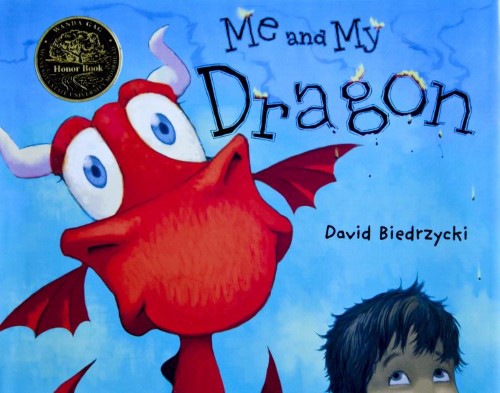
"Some kids want a dog. Others would like a cat. I want . . . a dragon!" A young narrator makes his case for owning a dragon, emphasizing how responsible of a pet owner he would be. He would take his dragon to get his shots; he would teach his dragon how to fly, and if he was a naughty dragon, he'd take him to obedience school. The narrator makes his case for how great a pet a dragon would be; you don't have to worry about bullies when you have a pet dragon! Biedrzycki's colorful illustrations, done in Adobe Photoshop, compliment the text perfectly, depicting the humor that the text only hints at.
Children, ages three to nine, responded favorably to the illustrations in the book, wanting to take a great deal of time to look at every page for the added details and clues. One group noticed that the endpapers told prequel and sequel events of the main story. Other children noticed the burning letters on the jacket cover and the burning barcode on the back! Students were engrossed in the read aloud, and teachers reported it being a favorite amongst the children.
David Biedrzycki lives in Medfield, Massachusetts. BRITTANY LAZUR
Fuddles written and illustrated by Frans Vischer (Aladdin, an imprint of Simon & Schuster). 2011

Fuddles is a fat, pampered cat. His family spoils him, but Fuddles decides that his life needs adventure. After preparing hard for his grand quest (but not too hard), Fuddles finally gets a chance to escape when Mom isn't looking! Will Fuddles be able to fight the ferocious beasts he dreamed about? Even more importantly, will he ever find his way home?
Vischer's digital illustrations complete this hilarious book. Fuddles's face and body express a multitude of emotions, such as pride, ambition, anger, cleverness, and surprise. Using perspective and continuous narrative, Vischer depicts the movement of Fuddles's adventures, causing the action to truly come alive on the page. Vischer also makes effective use of color to show nightfall in the later spreads of the book, causing a stark contrast in mood and tone from the onset of Fuddles's quest.
Children ages three to eight loved this book. They laughed at Fuddles's actions, particularly when he rides a vicious dog like a bull. Students understood the messages of running away and getting lost, and they expressed sympathy for Fuddles. Readers also enjoyed this book, saying that they had fun reading it aloud, and that the text flowed well.
FransVischer, originally from Holland, lives in Glendale, CA, with his family and their pampered cat. BRITTANY LAZUR
That Cat Can't Stay written by Thad Krasnesky and illustrated by David Parkins (Flashlight Press). 2010

In a comic rhyming text, the narrator tells the tale of how five cats and eventually one dog are added to a family. Mom brings home stray cat after stray cat and Dad firmly replies: “That creature cannot stay./There’s no use begging./Don’t say please./I don’t like cats. They scratch my knees./And I don’t want to have to shout,/so kindly put/that cat-thing out.” While Mom pretends to comply, she knows just how to manipulate soft-hearted Dad: “I’ll put him back outside,/I’m sure he’ll find some place to hide,/away from all the rain and hail/which just might drench him, nose to tail.” The young son and daughter witness each encounter and make the cats their own, but it is Dad that the cats prefer. Each scenario is funnier than the last with Dad ranting and raving but always relenting. Finally, Dad gets just what he wants—a sad and lonely pup he found at the pound. The book concludes with a funny family portrait, including five cats, and one dog.
The cartoon style, pen and ink and watercolor illustrations are at the heart of this comedy. The exaggerated facial expressions, especially those of Dad, are laugh-out-loud funny. One reader commented how the humorous vignettes of the Dad, proclaiming why he doesn’t want another cat, kept the children entertained.
Students from age four through eight greatly enjoyed this book. One second grade teacher called the book “brilliant” and said her students “loved it.” Children moved closer as the book was read and enjoyed repeating the refrain.
Thad Krasnesky, an Army major, lives at West Point, New York with his wife and two daughters. David Parkins, who lives with his wife and daughter in Lansdowne, Ontario, Canada, is also known for his political cartoons and editorial illustrations. CAROL HANSON SIBLEY
Interrupting Chicken written and illustrated by David Ezra Stein (Candlewick Press). 2010
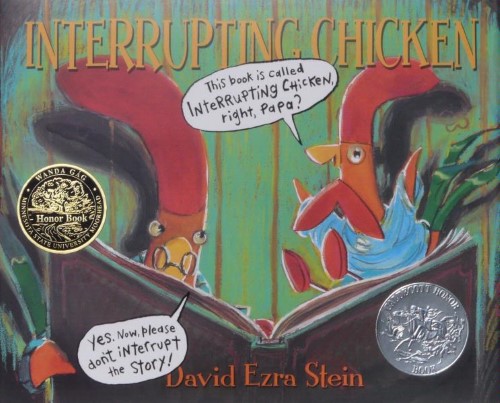
It is bedtime for little chicken. The little chicken’s Papa agrees to read a bedtime story, as long as Chicken doesn’t interrupt. She promises again and again that she won’t disturb him, but again and again she gets in the way! By jumping on to the actual pages of the fairy tale “storybook,” Chicken warns the surprised characters of the hidden dangers, thereby saving everyone a whole lot of trouble. Her exasperated father gives Chicken three chances to stay quiet, but when she doesn’t, and there are no more stories to read, Chicken must come up with her own bedtime story. Stein’s illustrations, done in watercolor, water-soluble crayon, china marker, pen, opaque white ink, and tea, are saturated with vibrant colors that reflect the playful and excitable spirit that the little chicken embodies.
This was an extremely successful book with students ages four to ten. Children were laughing throughout the story; one 3rd grade girl even commented that “it was probably the funniest book I ever heard.” Children enjoyed the inclusion of folk tales within the story and especially loved it when Chicken would interrupt the stories. All children paid very close attention to the story. The mother of a four-year-old, who normally doesn’t like to sit and read books, was very impressed by her young daughter’s attention to this story. Readers enjoyed the book as well, stating that it was one of their favorites and that they enjoyed “getting into” the characters. One reader got so into the role, she lost her voice after reading the book!
David Ezra Stein lives in Kew Gardens, New York, with his wife, Miriam.
A story-hour kit for this book is available on the publisher’s website. BRITTANY LAZUR
The Cow Loves Cookies written by Karma Wilson and illustrated by Marcellus Hall (Margaret K. McElderry Books, an imprint of Simon & Schuster). 2010
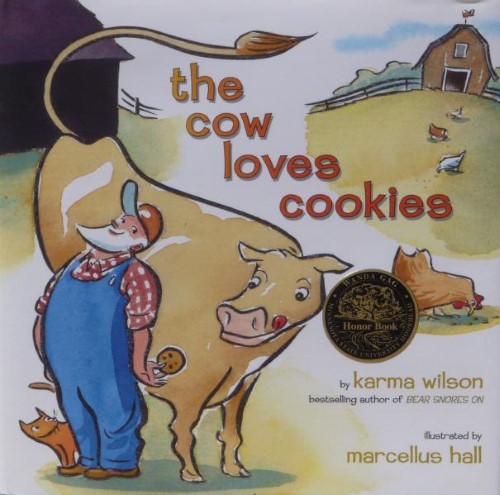
The story opens with an engaging cover of the farmer offering the cow a cookie, continues on the endpapers with a scene of the farm, and commences with the farmer carrying a huge bale of hay to the horse. The rhyming, repetitive text begins: “Whenever Farmer feeds the horse, he feeds the horsey hay, of course. The horse loves to nibble hay. He eats it every single day. But the cow loves cookies.” The story continues with Farmer feeding the chickens, the geese, the pigs, the dog, and finally the cow. It is then that readers learn why the cow loves cookies. Farmer and cow have made a deal; every day Farmer packs a picnic lunch of cookies, and the cow gives milk for dunking. Both are happy as “They both LOVE milk and cookies!”
Cartoon style watercolor and ink illustrations with bold black outlines show uncluttered scenes of the farm and the animals. Children especially enjoyed the scene of the oinking, snorting pigs, eating their gooey slop. Readers reported that the illustrations were easily viewed by groups of children.
This story was read to children from ages three through six. Children enjoyed making the animal sounds and repeating “the cow loves cookies.” Students thought the book was funny and especially enjoyed the ending when “the duck loves quakers.” Adults enjoyed reading this story aloud and appreciated the rhyming flow of the text. Children showed intent attention, looked at the book after read aloud sessions, and wanted it read again. Preschool teachers agreed that “All of the students just loved this book.”
Karma Wilson and her family live on a small ranch in Montana. Marcellus Hall, who resides in New York, is both an illustrator and musician. CAROL HANSON SIBLEY
The Three Little Gators written by Helen Kettelman and illustrated by Will Terry (Albert Whitman and Company). 2009

The Three Little Gators, a literary variant of “The Three Little Pigs,” is set in an east Texas swamp. Mama gator sends her three sons off to create a life of their own with the warning: “Make sure you build houses strong enough to keep you safe from Big-bottomed Boar.” The First Gator, more hard working than his siblings, makes his house out of rocks. The Second Gator builds a stick house, while the Third Gator builds a house of sand. It’s no surprise that Big-bottomed Boar soon appears. When the Third Gator won’t open his door, Big-bottom Boar warns: “‘Then I’ll wiggle my rump with a bump, bump, bump and smash your house!’” In no time, sand flies and the Third Gator runs off to Second Gator’s house where the action repeats itself. However, when the Big-bottomed Boar “wiggled, and bumped, and waggled and thumped,” the First Gator’s rock house stands firm. The boar decides to squeeze down the chimney. “‘Bad choice’” yells the three little gators. The Big-bottomed Boar falls on the hot grate of the barbecue grill and runs off “faster than a thunderbolt” with grill stripes steaming on his big bottom!
The very funny, full-page cartoon style paintings show big-eyed gators and a scary boar with spiky hair, a big snout, and sharp tusks. Brown and gold tones capture the swamp setting.
The Three Little Gators captivated children from kindergarten through third grade. They compared it to “The Three Little Pigs,” commenting on how the author took an old story and made it into something new. They enjoyed the illustrations with the gators’ big eyes, the boar’s big eye peeking through the door, and the grill marks on the boar’s bottom. Students chose to look at the book after the read aloud sessions, told others about the book, and asked for the story to be read again.
After living in Texas for nine year, author Helen Ketteman now lives with her husband in Sanibel Island, Florida. Will Terry resides in Utah. In addition to illustrating picture books, he teaches illustration at Utah Valley State College in Orem, Utah.
Sleep, Big Bear, Sleep! written by Maureen Wright and illustrated by Will Hillenbrand (Marshall Cavendish Children). 2009
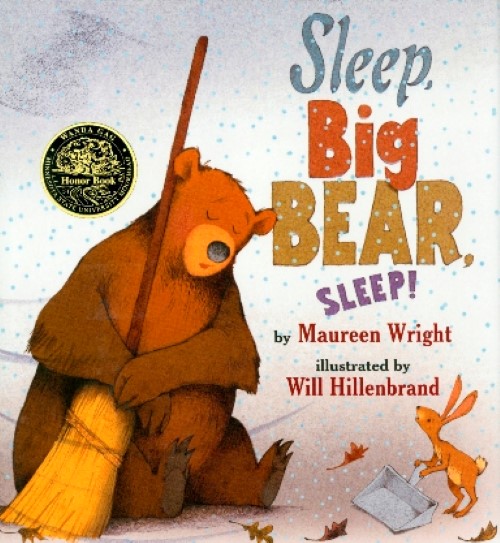
When Old Man Winter softly reminds Big Bear that it’s time to hibernate, Big Bear doesn’t hear well and thinks he said “‘Drive a jeep, Big Bear, drive a jeep.’” Tired Big Bear causes havoc as he drives around town. This sequence continues as Old Man Winter continually says, “Sleep, Big Bear, sleep” and Big Bear responds to what he thinks he hears. He sweeps, leaps, dives deep, and climbs a steep mountain, before Old Man Winter finally yells: “‘Hey there, Bear! Did you hear what I said? It’s winter time, now go to bed!’” A friendly rabbit adds to the fun as it follows Big Bear on all of his adventures and finally joins him in his cozy den.
Hillenbrand’s full-color, full-page illustrations convey the seasonal change from shades of green to a gray winter landscape dotted with snowflakes. Two vertical double-page spreads towards the middle of the story add to the drama as Big Bear dives deep and prepares to climb a very steep mountain.
Preschoolers through third graders loved this very entertaining story. They enjoyed the illustrations and asked for more time to look at them after the read aloud sessions. They also liked the rhyming text and the repeated line, “Sleep, Big Bear, Sleep.” Five-year-olds “freaked out with laughter when Big Bear drove the jeep.” One day care provider recommended this story to read before nap or bedtime. She commented: “I could say, ‘okay, Big Bear went to sleep, now it is your turn!’” One kindergarten teacher appreciated that the book made the children think, as it stirred up many questions. First graders enjoyed how Big Bear kept misunderstanding, and they tried to guess what he would do next based on picture clues. One second grade teacher shared that her class loved the book and that the story led to a good discussion on confusing what people say. And, of course, the children wanted the book read over and over.
 Author Maureen Wright lives with her family in Athens, Pennsylvania. Illustrator Will Hillenbrand lives in Cincinnati, Ohio with his wife and their son.
Author Maureen Wright lives with her family in Athens, Pennsylvania. Illustrator Will Hillenbrand lives in Cincinnati, Ohio with his wife and their son.
A Visitor for Bear written by Bonny Becker and illustrated by Kady MacDonald Denton (Candlewick Press). 2008
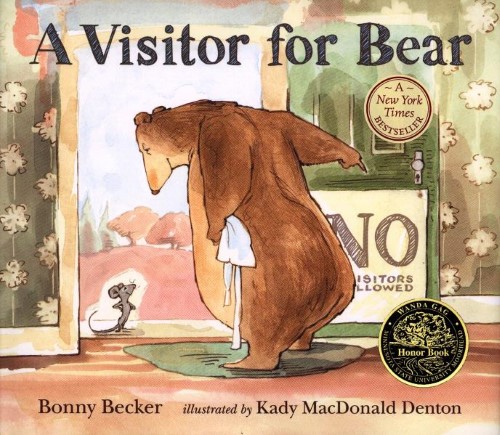
Bear is very content living alone in his cottage in the woods. But one morning, as he sets out to make his breakfast for one, a “small and gray and bright-eyed” visitor appears. After answering the “tap, tap, tapping” at his door, Bear looks down at the mouse and points to the sign on his door: “No Visitors Allowed.” With a happy grin back on his face, Bear resumes his duties, only to encounter more surprise visits. The persistent small furry mouse is found repeatedly throughout the house until Bear puts forth a plan to lock everything up to keep the mouse out. As readers would expect, the mouse reappears, causing Bear to give in to the small creature’s plea. The two characters settle in front of the fire and Bear soon realizes that no one has ever been so attentive to his jokes and tricks. When the mouse starts to obey the original command of “no visitors allowed,” Bear quickly intervenes. After ripping off the sign that once hung on his door, Bear tells the mouse, “ ‘That’s for salesmen. Not for friends.’ ”
When hearing this book read aloud, many early elementary students enjoyed the numerous reappearances of the mouse. Throughout the story, students laughed, smiled, pointed, repeated phrases, and showed intent interest. Preschool children noticed the large font on the pages where Bear shouted at the mouse to leave his home, and they enjoyed repeating the words. The soft illustrations created with watercolor, ink, and gouache perfectly complement the text. One reader thought the expressions on Bear’s face were “priceless.” Over all, children caught on to the message of friendship and being kind to one another. A first grade teacher commented on the terrific use of language within the conversations between the bear and mouse, and found the story to be very appropriate for the younger age group.
Author Bonny Becker said the idea for A Visitor for Bear just “popped into” her head one day, which is fitting to the character of the mouse in the story. More “Bear and Mouse” stories are in the making. Bonny lives in Seattle, WA.
Illustrator Kady MacDonald Denton lives in Peterborough, Ontario, where she works in an old, tall, yellow brick house overlooking the river. She said, “Bear and the mouse are two of the funniest characters I’ve met in a long time.” (Ashley Roemer)
The Sandman written by Ralph Fletcher and illustrated by Richard Cowdrey (Henry Holt and Company). 2008
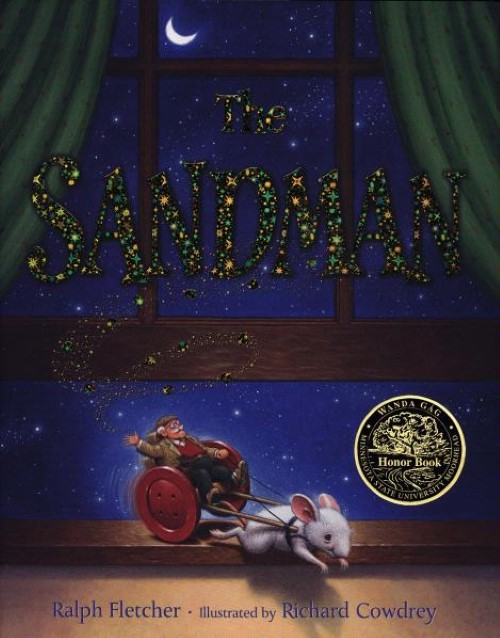
After trying the common remedies of counting stars and drinking warm milk, Tor cannot fall asleep. The next day, as the tiny man ventures through the woods, he comes upon a sparkling green dragon scale. Noticing that one edge is jagged, Tor brings the scale into his shop to file. As the small sand-like shavings blow throughout his workshop, Tor suddenly falls asleep. After a long rest with wonderful dreams, Tor realizes the value in the surprise he found and grinds up the entire dragon scale. Riding in his mouse-drawn carriage, Tor journeys throughout the night to sprinkle the special sand over children with restless eyes. With the many children needing help to fall asleep, Tor keeps very busy, eventually getting the nickname “The Sandman.” But the sand from the dragon scale does not last forever, forcing the Sandman to set out on a difficult journey to capture another scale. With success, the Sandman is able to continue with his bedtime deed. And because “…dragons live forever, there will never be a shortage of scales.”
Detailed and rich acrylic illustrations support this mystical, bedtime story. Children from the ages of two to nine enjoyed searching the pictures to find unique details, such as a postage stamp hanging on the wall of Tor’s bedroom. Children also liked the dragon, specifically the large, two-page spread of the fire-breathing creature. The mouse caught the attention of many listeners, and many young children thought it was funny that Tor was pulled around by such a small creature. Adult readers enjoyed the story just as much, specifically this unique version of how the Sandman does his work.
Author Ralph Fletcher lives with his family in Lee, New Hampshire.
Illustrator Richard Cowdrey got ideas for The Sandman by reviewing the Hildebrandt Brothers’ version of The Hobbit. Richard lives in Gambier, Ohio. (Ashley Roemer)
Snow Day! written by Lester L. Laminack and illustrated by Adam Gustavson (Peachtree). 2007
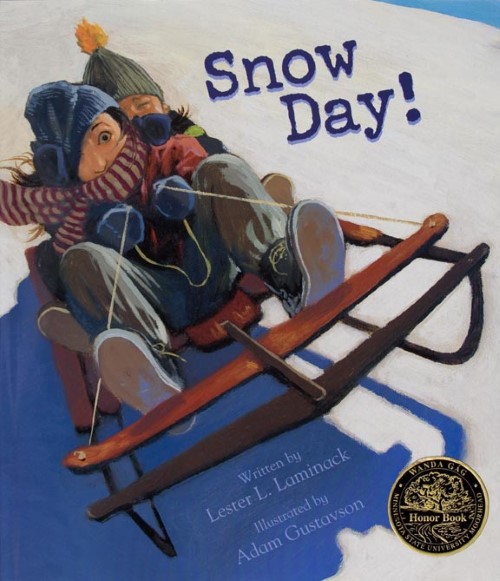
An unknown narrator imagines what he and two children could do if they had a snow day from school. They could sleep in late, build a snow fort, go sledding. However, the weatherman’s predictions don’t work out. The next morning is a school day! The father and two children race to get ready. The book’s last line reveals the mysterious narrator: it’s the father—a teacher.
Gustavson’s oil paintings from various perspectives capture the facial expressions of the characters and effectively depict the deep imagined snow, which came down like “a bazillion goose feathers.”
The story and illustrations captured the attention of first through fourth graders. They commented on the bus almost covered with snow and “the awesome snow fort.” They liked the surprise ending and talked about their own snow days.
Lester L. Laminack makes his home in North Carolina, and Adam Gustavson lives with his wife and two sons in New Jersey.
Knuffle Bunny Too: A Case of Mistaken Identity written and illustrated by Mo Willems (Hyperion Books for Children). 2007
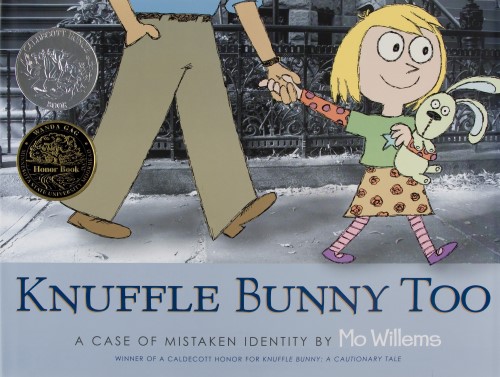
In this second book about Trixie and her daddy, Trixie now attends preschool and is looking forward to taking her one-of-a-kind Knuffle Bunny to school. Things do not go well when Trixie finds out that her classmate Sonja has a Nuffle Bunny that looks much like Trixie’s. Arguments ensue and the teacher takes both bunnies, only to give them back at the end of the day. Hours later Trixie wakes up in the middle of the night and marches into her parents’ bedroom to announce: “That is not by bunny.” The two daddies and the girls rush out to do a bunny exchange. The black and white photographs of Brooklyn’s Grand Army Plaza at night awed readers. They noticed the tiny cartoon figures of the girls and their daddies walking toward the arch for the bunny exchange. All ends happily with Trixie finding her first best friend in Sonja.
Two-year-olds through first graders were excited about this story and were amazed by the illustrations, hand-drawn cartoon sketches superimposed on photographs. Children related to this story of a favorite stuffed animal, asked many questions, and pointed at objects in the pictures. One first grade class said it was the best book of the year!
Mo Willems took photographs of his own Brooklyn neighborhood for the book. An “event kit” for the book, which contains many teaching ideas and activities, is available from the publisher’s website.
My Cat, the Silliest Cat in the World written and illustrated by Gilles Bachelet, and published by Abrams Books for Young Readers. Originally published as Mon chat le plus bête du monde by Éditions du Seuil in 2004. Translated from French.

A painter, appearing in a dressing gown, narrates this story about his very fat, sweet, and silly cat. According to the straightforward text, the cat especially likes to eat, sleep, and keep clean. The very funny illustrations show the “cat” engaged in all of the above activities, except that this cat is actually an elephant! The elephant is often shown in a series of vignettes, such as those that describe his cleanliness. The colorful paintings enhanced with pen-and-ink portray him licking himself clean, spraying himself with toilet water, and sweeping his elephantine body with a vacuum cleaner.
Children from the ages of two through eight enjoyed this book. During the reading, one two-year-old walked up to touch the elephant on the page several times. Kindergartners especially liked this unique story. The students kept saying “It’s not a cat!” and then laughed and pointed at what they found funny. The kindergartners, who wanted the book read again and again “could have looked at the illustrations forever.”
Gilles Bachelet lives in Cambrai, France where he has taught illustration at the École Supérieure d'Art.
One Potato, Two Potato written by Cynthia DeFelice and illustrated by Andrea U'Ren (Farrar, Straus and Giroux). 2006

Mr. and Mrs. Grady, who are elderly, poor, and lonely, live in a small cottage with just one of every thing: one coat, one blanket, one chair. Their garden on a bare, rocky hillside yields one potato per day. This is the couple’s breakfast, lunch, and supper. One day while digging in the potato patch, Mr. Grady finds a huge, black pot. He carries it home to show his wife, and they soon discover that whatever is dropped in it is doubled. One hairpin, one potato, and one cold coin each become two. When Mrs. Grady accidentally falls into the pot, her husband pulls out two identical wives. To make things even, Mr. Grady jumps in and also gets doubled. Now they have their greatest wish, each has a friend. The couples decide they now have everything they could ever want and so bury the magic pot for someone else to find. Pen and gouache illustrations in earthy tones emphasize the couple’s poverty.
Children from ages four through nine listened intently to this story and enjoyed chanting “one potato, two potato.” They found the story exciting and liked making predictions about the magic pot. They also laughed at the illustrations of Mrs. Grady falling into the pot and Mr. Grady jumping in. Readers appreciated the theme of receiving, but not abusing, good fortune. Teachers noted that the book is helpful for learning the mathematical concept of doubling.
Author Cynthia DeFelice lives in Geneva NY, and illustrator Andrea U’Ren makes her home in Portland, OR.
365 Penguins written by Jean-Luc Fromental and illustrated by Joëlle Jolivet. Originally published as 365 Pingouins by Naïve Livres. Translated from French (Abrams Books for Young Readers). 2006
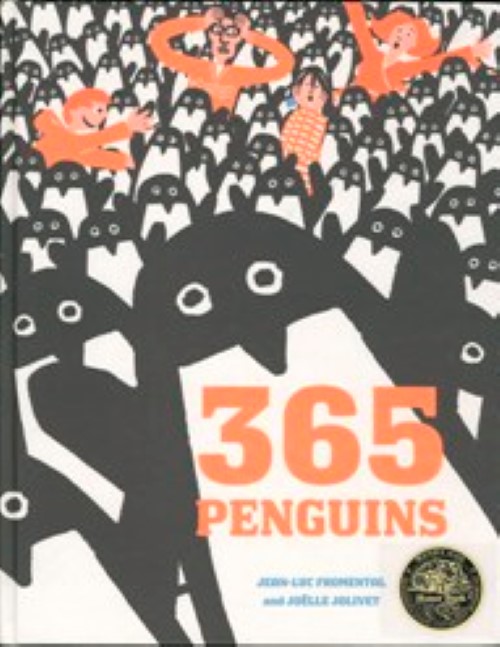
A family of four receives a special delivery on New Year’s Day, one penguin from an undisclosed sender. As the year proceeds another penguin is delivered every day. As the number of penguins increases so do the family’s problems. How can they house hundreds of penguins? How can they afford the fish to feed them? How can they keep them cool in the summer?
This story combines a lesson on global warming with numerous math problems. For example, Daddy figures out he can store 216 penguins in a cube until penguin 217 is delivered. The story also becomes a game of “I spy” when blue-footed Chilly penguin arrives.
The large format (37 x 29 centimeters), cartoon-style illustrations in blue, orange, and black, and the large font size all work well together for a read aloud. Teachers valued the book for its science and math concepts, while children liked the humor and enjoyed predicting what will happen as the family acquires more and more penguins. The book was a hit with children ages three through nine.
Jean-Luc Fromental and Joëlle Jolivet are both from France.
Am I a Color Too? written by Heidi Cole and Nancy Vogl, and illustrated by Gerald Purnell (Illumination Arts). 2005
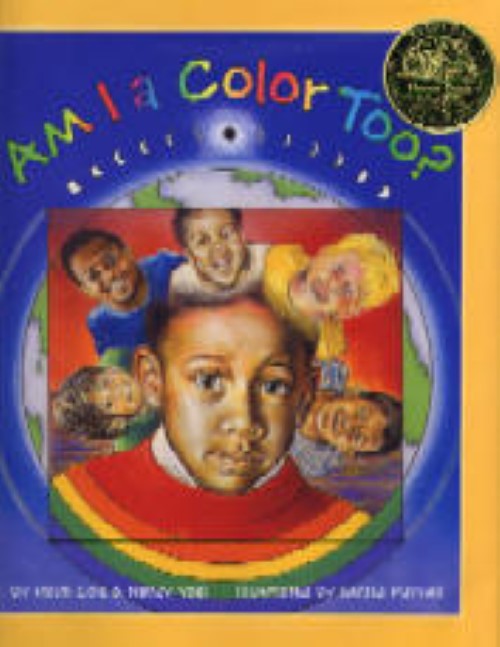
Tyler, a young boy whose father is black and mother is white, narrates this story. He wonders why people focus on skin color and asks: “Am I a Color Too?” As Tyler questions his own identity, he thinks about all the universal qualities shared by people and concludes:
I am a Human Being,
Not a color, not a word.
I have my hopes and dreams
And a voice that will be heard.
Purnell’s realistic illustrations, focusing on faces and facial expressions, show the beauty in all kinds of skin colors.
Kindergarteners through fourth graders commented on the amazing pictures. Children especially liked the illustration where Tyler’s eye reflects the faces of his mother and father. They also liked the rhyming text and were motivated to retell the story to others. Teachers commented that the book stimulated discussion and reported that students even got out of their seats to take a closer look at the book and ask questions.
Author Nancy Vogl lives in northern Michigan and illustrator Gerald Purnell resides in New Jersey.
Llama Llama Red Pajama written and illustrated by Anna Dewdney (Viking). 2005
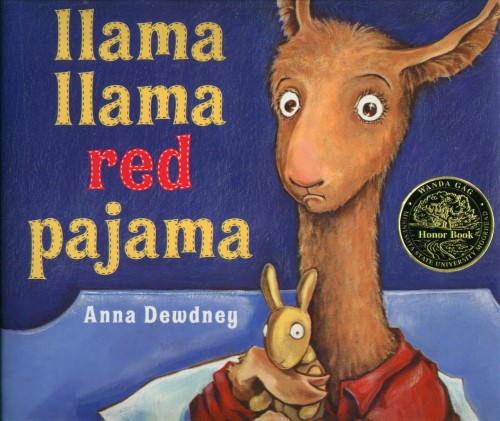
After being read to, kissed, and put to bed by his mama, Baby Llama suffers from separation anxiety. As he waits for his busy mother, his anxiety escalates into a full-fledged tantrum. Dewdney tells her story through rhyme, rhythm, and the natural language of young children. The full-page paintings darken as Baby Llama’s angst reaches its climax. Dewdney creates her engaging and exaggerated facial expressions from her own self-portraits.
Two-year-olds through kindergartners wanted this book read again and again. Children liked the predictability of the repeated, rhyming phrase “llama llama red pajama” and chanted and clapped along with the story. They also enjoyed the lighthearted tone, the changing facial expressions, and the excellent word choice. In the words of readers, this is a “funny, cozy, interactive” picture book that uses “honesty and humor in depicting inner thoughts and emotions of children.” A perfect book for storytime and bedtime.
Anna Dewdney lives in Putney, VT.
Stanley Mows the Lawn written and illustrated by Craig Frazier (Chronicle Books). 2005
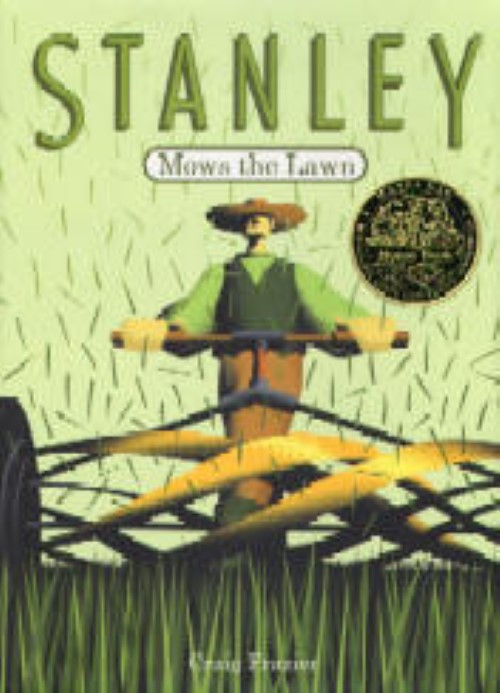
When Stanley realizes his grass has grown too tall, he starts mowing his huge lawn in straight paths with his push mower. When he hears something moving in the grass, he takes a closer look and discovers Hank, a friendly looking snake in two shades of green stripes. Stanley devises a plan to make both Hank and himself happy. He mows in zigs and zags creating strips of short and tall grass.
The simple text encourages us to look at the world closely and to have empathy.
Frazier created computer colored hand drawings, predominately in a green and brown palette, to show the world from the point of view of both characters.
Three-year-olds through seven-year-olds were intrigued by Stanley’s big lawn and all the grass clippings and were relieved that Hank was safe at the end. Children liked the varying perspectives shown in the illustrations, as well as all the shades of green. Adults noticed that the story left many gaps for discussion.
Author/illustrator Craig Frazier lives with his family in northern California.
Knuffle Bunny: A Cautionary Tale written and illustrated by Mo Willems (Hyperion Books for Children). 2004

Toddler Trixie, with a tight hold on her stuffed “Knuffle Bunny” joins her daddy on a trip to the neighborhood Laundromat. On the way back home, pre-verbal Trixie, discovering that Knuffle Bunny is left behind, tries every means possible to communicate her distress to her daddy, who remains clueless. When Daddy with Mommy’s help finally retrieves Knuffle Bunny, Trixie utters her first words: “Knuffle Bunny!”
Willems’ illustrations and the overall book design merge perfectly with the text to tell the story of Trixie’s traumatic journey. The unique illustrations are a blend of cartoon sketches superimposed over sepia-toned airbrushed photographs.
Children, ages two to six, loved this book and wanted it read over and over. They were intrigued by the pictures. A kindergartner commented: “They look real, but then they don’t.” The story inspired one two-year-old to reenact the stages of Trixie’s tantrum from baby talk, to crying and screaming, to the totally uncontrollable boneless stage.
Author/illustrator Mo Willems, who lives in Brooklyn, took photos of his own neighborhood for the book.
A guide for teachers is available on the publisher’s website.
Kumak's Fish: A Tall Tale from the Far North written and illustrated by Michael Bania (Alaska Northwest Books/Graphic Arts Center Publishing). 2004
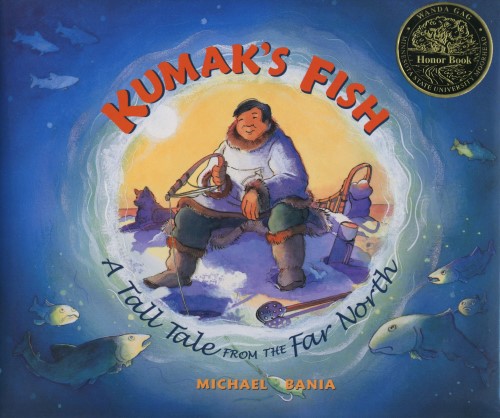
On a spring day in the Alaskan Arctic, Kumak announces “Good day for fish” and packs his family, along with Uncle Aglu’s “amazing hooking stick” into their dogsled for a day of ice fishing on the nearby lake. This Iñupiat variant of the traditional tale of the enormous turnip demonstrates that it takes a village to catch a fish. An endnote explains Bania’s inspiration for her tall tale.
Bania’s watercolor and pen-and-ink illustrations, depicting the icy Arctic setting, provide readers with authentic details of the Iñupiat culture and show the joyfulness of the characters.
Two-year-olds through nine-year-olds enjoyed this book and were captivated by Kumak. They appreciated the dialogue and repetition of numerous phrases. The ending when Kumak was having a hard time landing his fish especially intrigued the children, who enjoyed mimicking the twitching of the hooking stick.
Michael Bania, who worked and lived in the Arctic Circle for nearly twenty years, now lives in Soldotna on Alaska’s Kenai Peninsula.
Acorn Was A Little Wild written by Jen Arena and illustrated by Jessica Gibson (Simon & Schuster Books for Young Readers). 2022

Not wanting to wait around to see what happens, little Acorn takes a jump off the tree to seek an adventure of their own. Acorn was a little wild tells the story of what can happen to an acorn once it falls off an oak tree. Rolling down hills and being picked up by a pesky squirrel; narrowly escaping one squirrel’s mouth and flying from a tree only to be picked up by another squirrel and buried deep underground. After initially thinking all their fun is over underground, little Acorn starts a new adventure as he stretches and grows, pushing through the soil and back into the sun. Bright, colorful illustrations accompany playful text which provide the reader with an introduction to how an acorn gets from the branches of an oak tree, planted deep underground, and then grows into a tree of their own.
While listening to the book, preschool, kindergartens, and first graders showed rapt interest in the illustrations and repeated phrases often trying to stretch or shift closer to the book. Several readers noted the children made lots of positive comments and laughed throughout the book. One teacher commented that it was a clever way to introduce oak trees and how the oak tree grows.
Author Jen Arena lives in Tampa, Florida where she writes and edits. Other books by Arena are Besos for Baby, Lady Liberty’s Holiday, and Marta! Big & Small. Jessica Gibson is a freelance illustrator from Detroit, Michigan. [LISA EGGEBRAATEN]
I Can’t Draw written by Stephen W. Martin and illustrated by Brian Biggs (Margaret K. McElderry Books). 2022

I Can’t Draw is about Max, a boy who loves to draw but doesn’t think he is any good at it. He asks his friend Eugene (the best artist in the class) for tips on how to be a better artist. Eugene suggests a variety of ways for Max to improve his drawing skills, but none of his attempts look like Eugene’s. Then, an idea hits Max: Instead striving to be exactly like Eugene, perhaps they could team up! Max adds his own unique flair to Eugene’s drawings. Their collaboration turns out to be exactly what Max needs to realize that he actually CAN draw. This book is a lesson in appreciating your own talents and unique abilities that kids can relate to.
Students showed a great deal of enthusiasm for this book. They found a lot of humor in the drawings and Max’s responses eliciting laughter and spontaneous comments. Students enjoyed the differences in the “How to draw a cat” instructions from Max and Eugene on the end pages of the book. Several students wanted to try following the steps themselves. Others wanted to team up with a classmate to do their own drawing collaborations. Many of the students identified with Max’s feelings and related them to their own experiences. This led to animated class discussions about how everyone has different talents.
Stephen W. Martin is a writer on Netflix’s Trash Truck and the author of several picture books. He grew up in Canada and now lives in Los Angeles with his wife and dog. Brian Biggs is the author and illustrator of many books for kids. He has worked as an art director, graphic designer, animator, and university professor. [STEPHANIE NEWLAND]
The Together Tree written by Aisha Saeed, illustrated by LeUyen Pham (SALAAM READS, an imprint of Simon & Schuster Children’s Publishing Division). 2023

It is extremely difficult to watch our children going through the trials of life. Such a time occurred for author Aisha Saeed who observed a few of her son’s kindergarten classmates bully him. She also noticed that while the rest of the class didn’t participate, they didn’t seem to know what to do. Hoping to help her son, Ms. Saeed wrote The Together Tree. In this quietly compelling and powerful story, Rumi feels unwelcome and alone at his new school. During recess, as Rumi finds solace under a giant willow tree, he becomes a target for bullying. It isn’t until a lone upstander comes to Rumi’s aid that other classmates begin to see the importance of standing together against bullying. Throughout the story, readers see a black and white, dreary, leafless tree change into a beautiful, shade yielding place of safety. Alongside the tree are bullies, a bullied boy, and bystanders who also change and learn to stand tall together. In the process the reader learns that kindness often has the power to change many lives.
When the story ended, some classes were extremely quiet, trying to process the power and impact of the story. The colors the illustrator, LeUyen Pham, used played a significant part in the story. The kids commented that at the beginning, the tree seemed lifeless and sad and so did Rumi. The pictures of the bullies were in black and white when the children were bullying Rumi. Although he is in color, his facial expressions reveal his hurt, rejection and loneliness. Later, when the children started to ask Rumi if they could play with him, Asher, the bully, felt rejected and left out and he was the only one still pictured in black and white. As the tree flourished, the kids realized that the students in the story had started to accept one another. Eventually, all came together in a safe, restful place, together under the tree. “A powerful read, one that will fit in well with curricula and be helpful for counselors, etc.” Teachers asked their librarians to purchase the book and some classrooms hoped The Together Tree might be this year’s winner.
Aisha Saeed, a Pakistani American, is the bestselling and award-winning author of Amal Unbound, Omar Rising, and Bilal Cooks Daal. In 2018 Amal Unbound was selected as the Global Read Aloud and in 2020 Bilal Cooks Daal won the Asian American Pacific Islander Literature Award Honor. LeUyen Pham is the illustrator of over 120 books, most notably of the Caldecott honor winner Along Came Bear, Princess In Black series, and Real Friends series. She lives in Los Angeles, CA.
